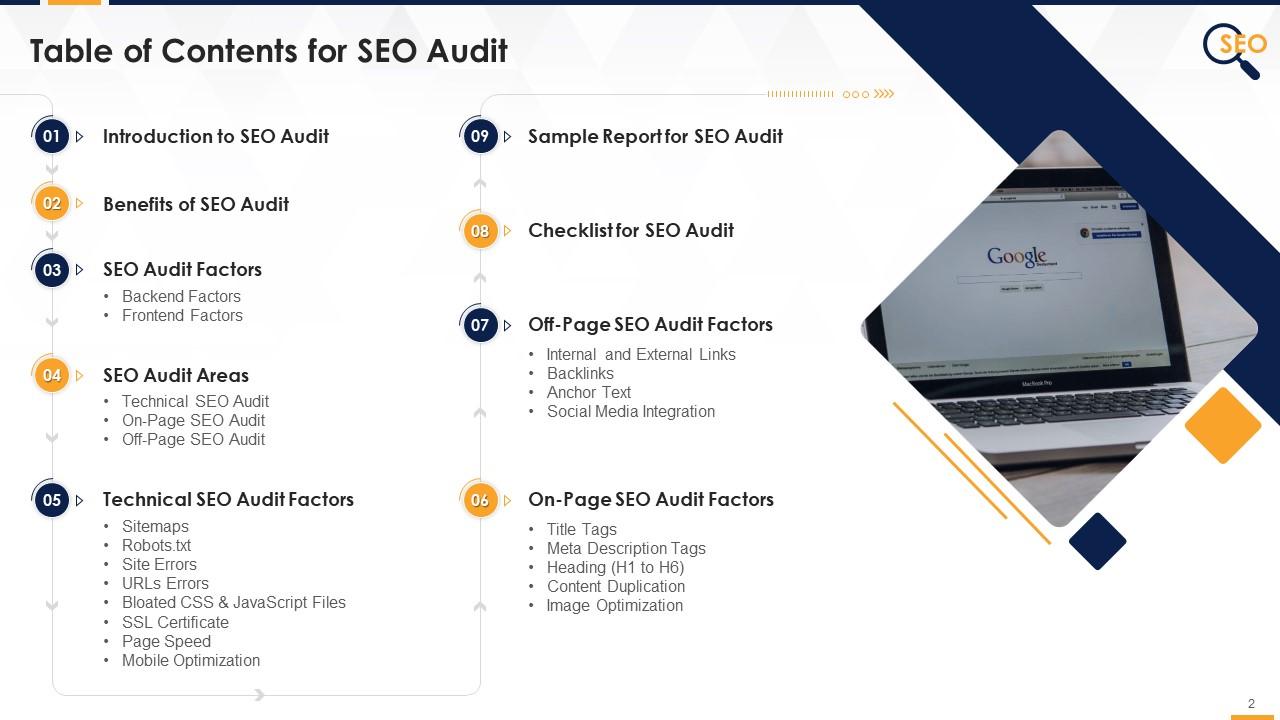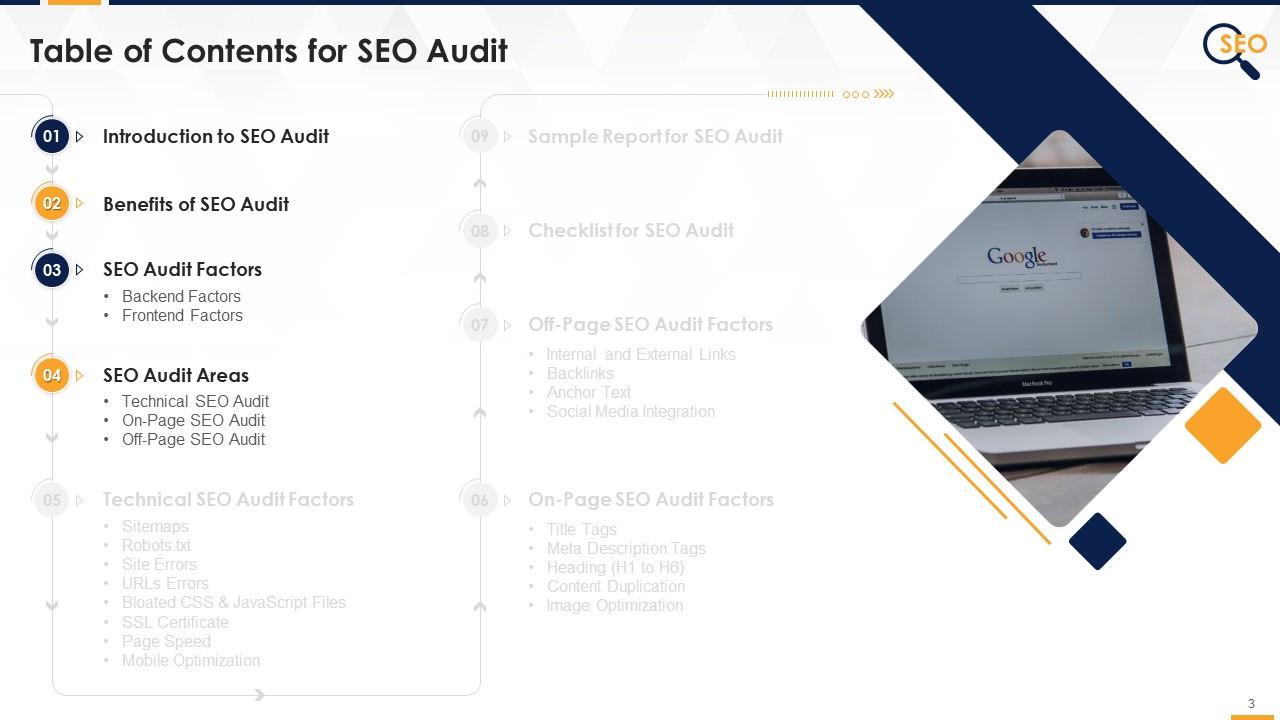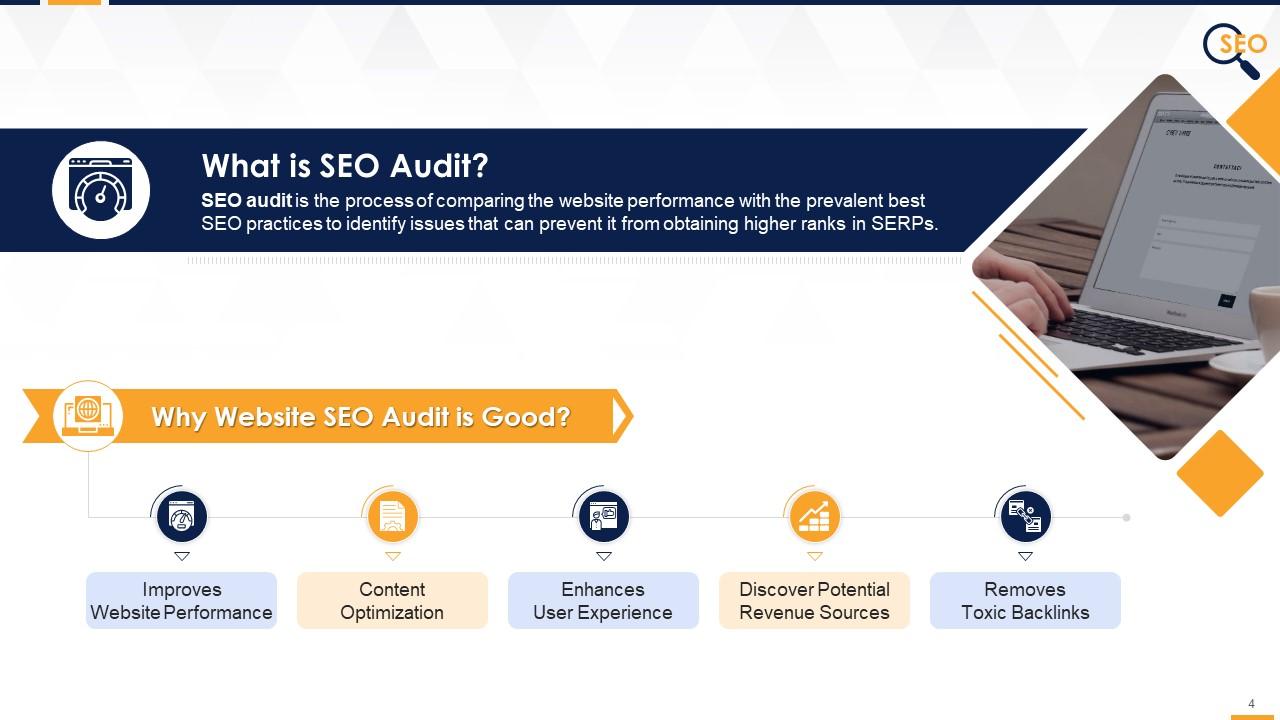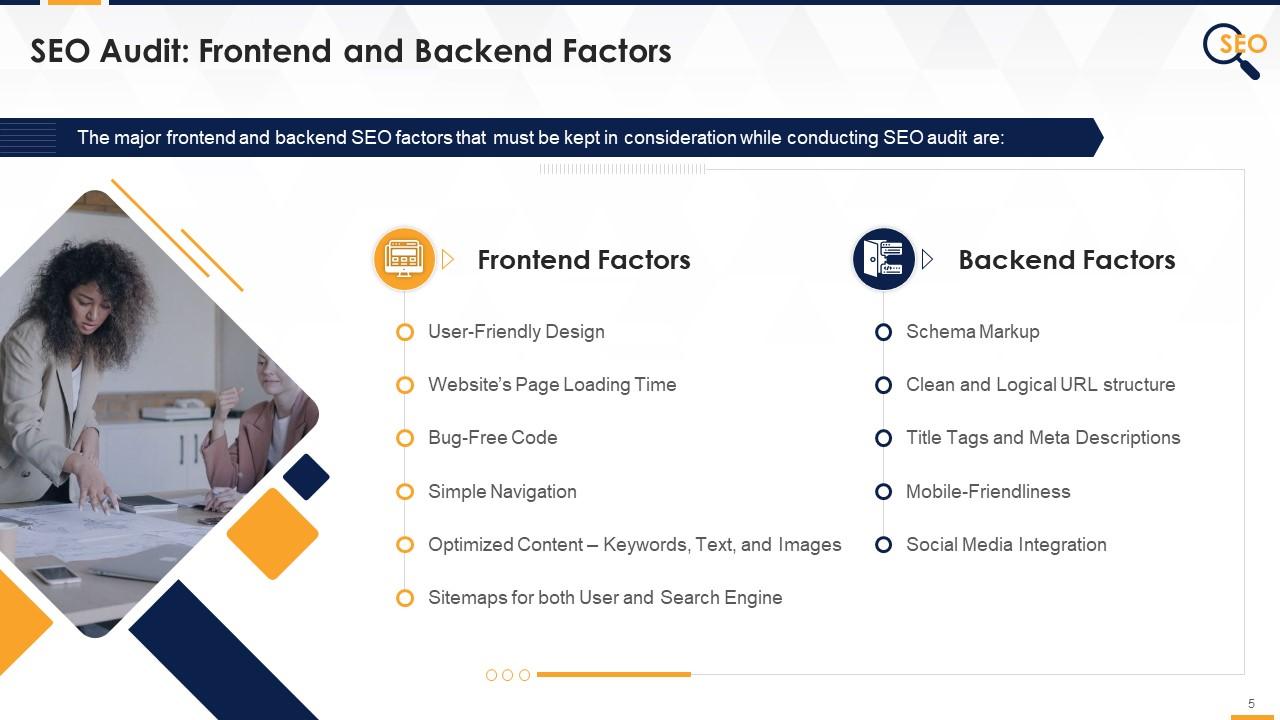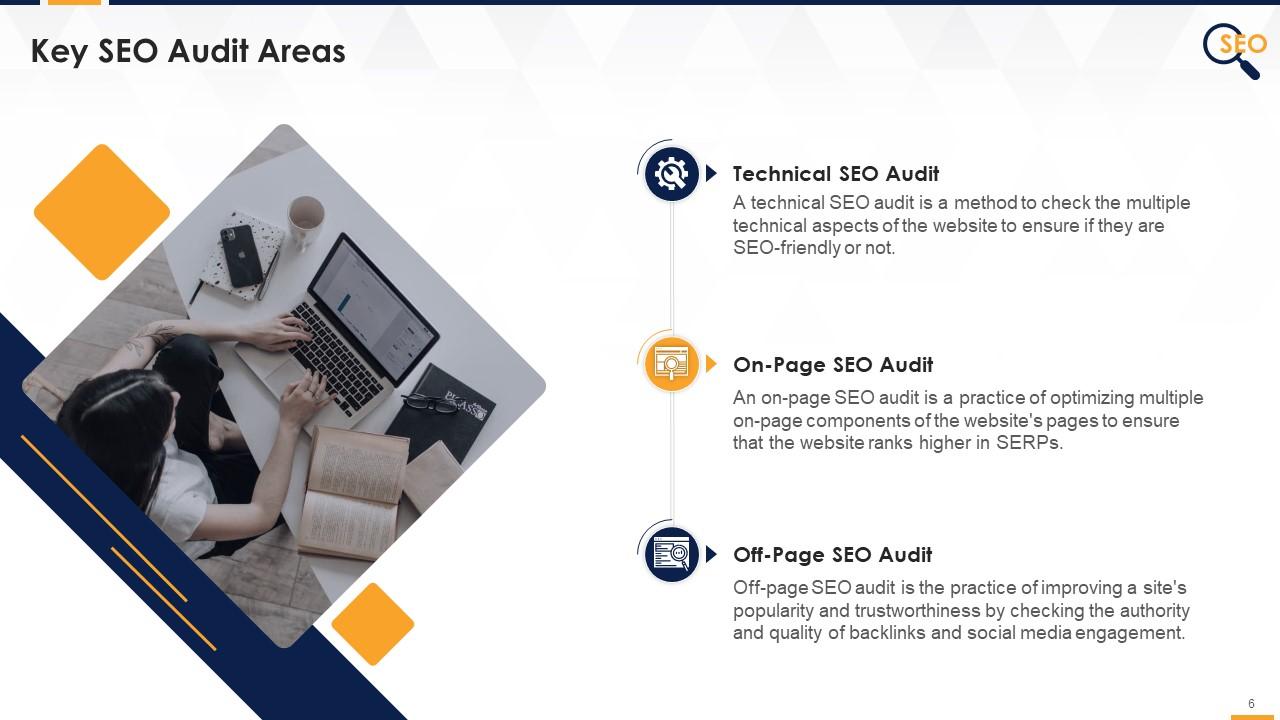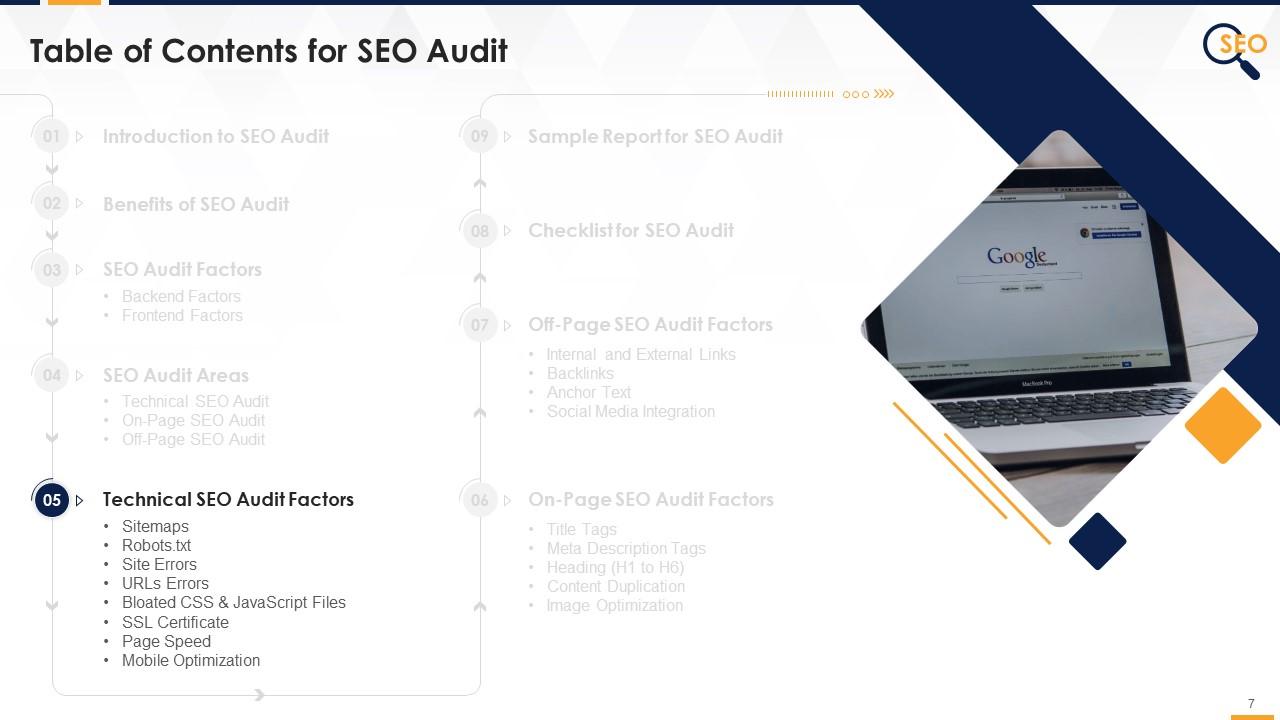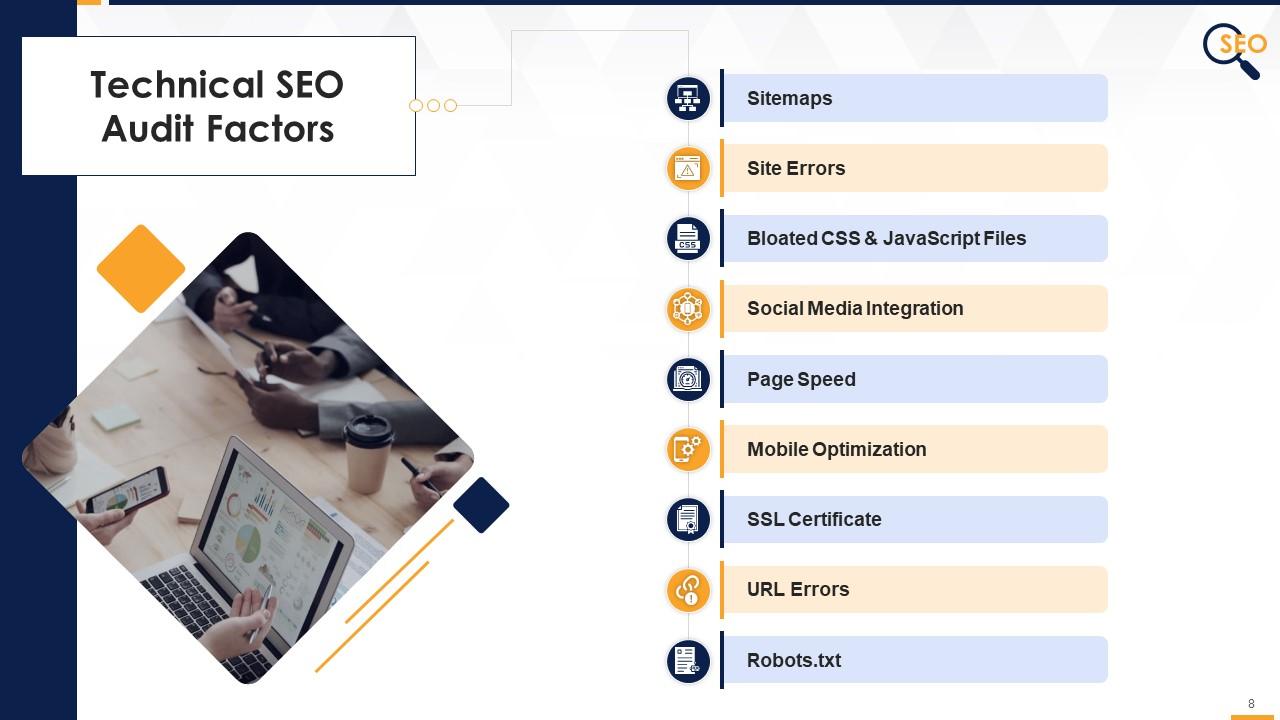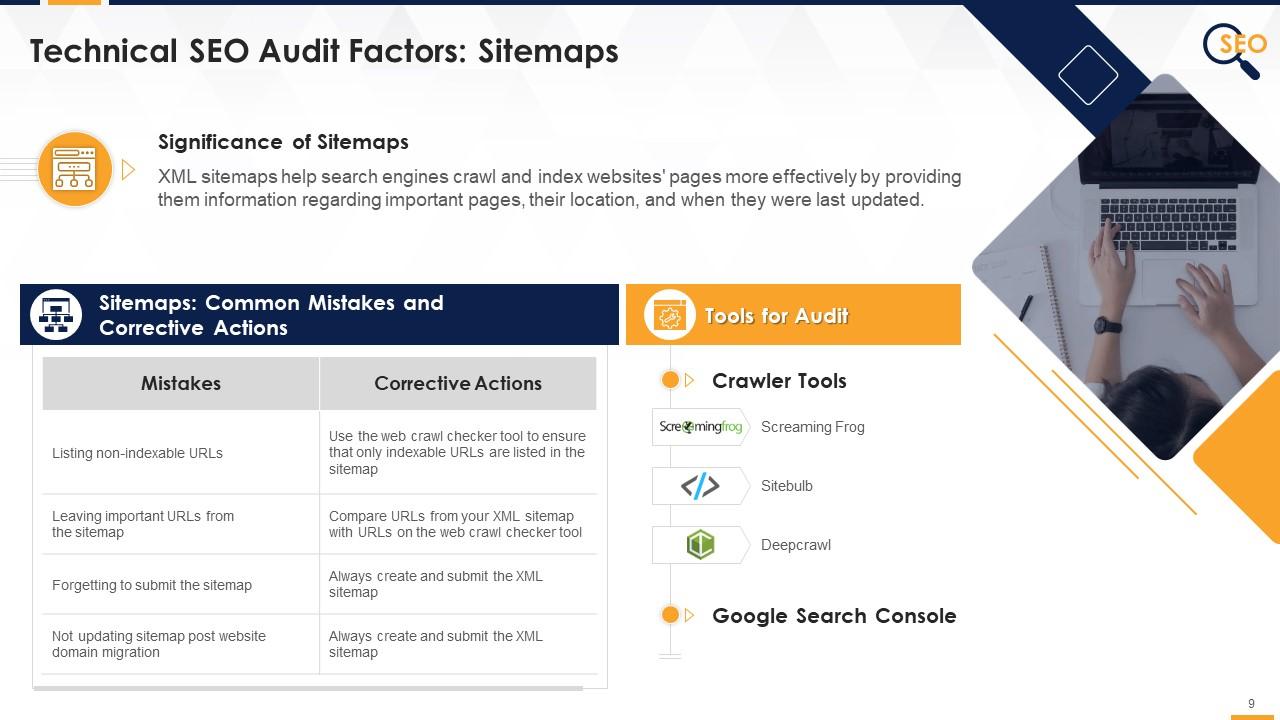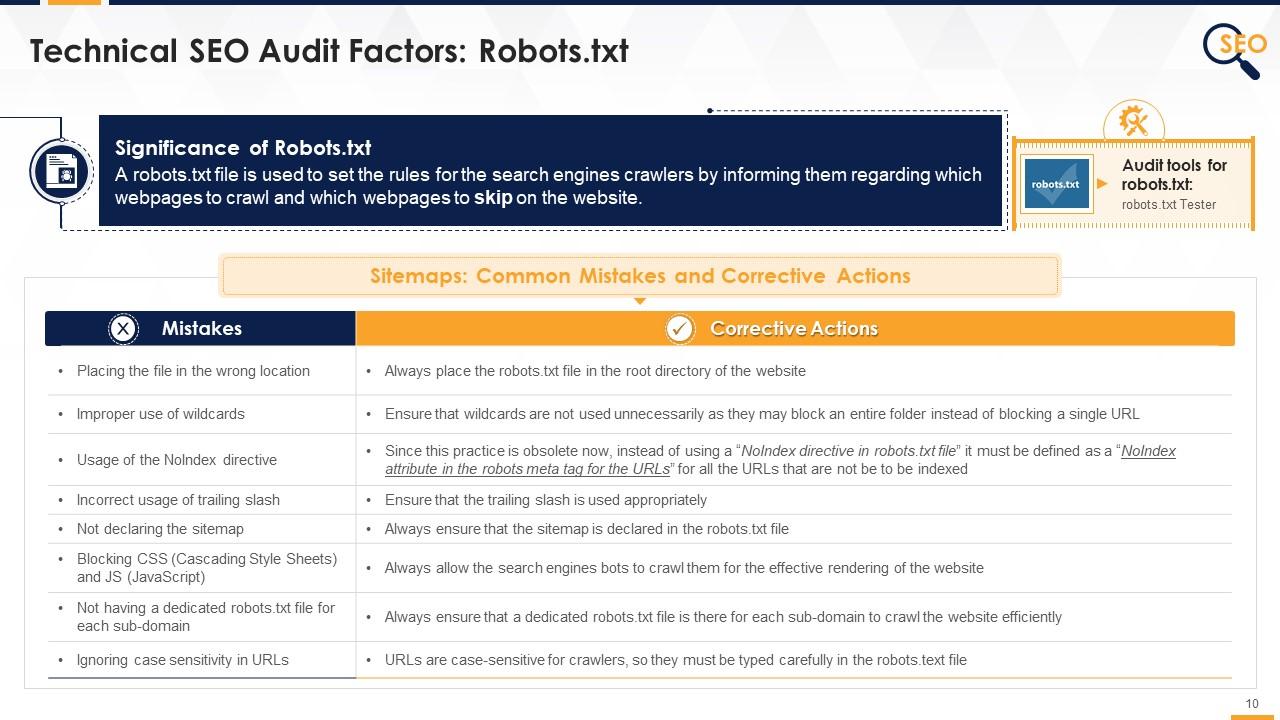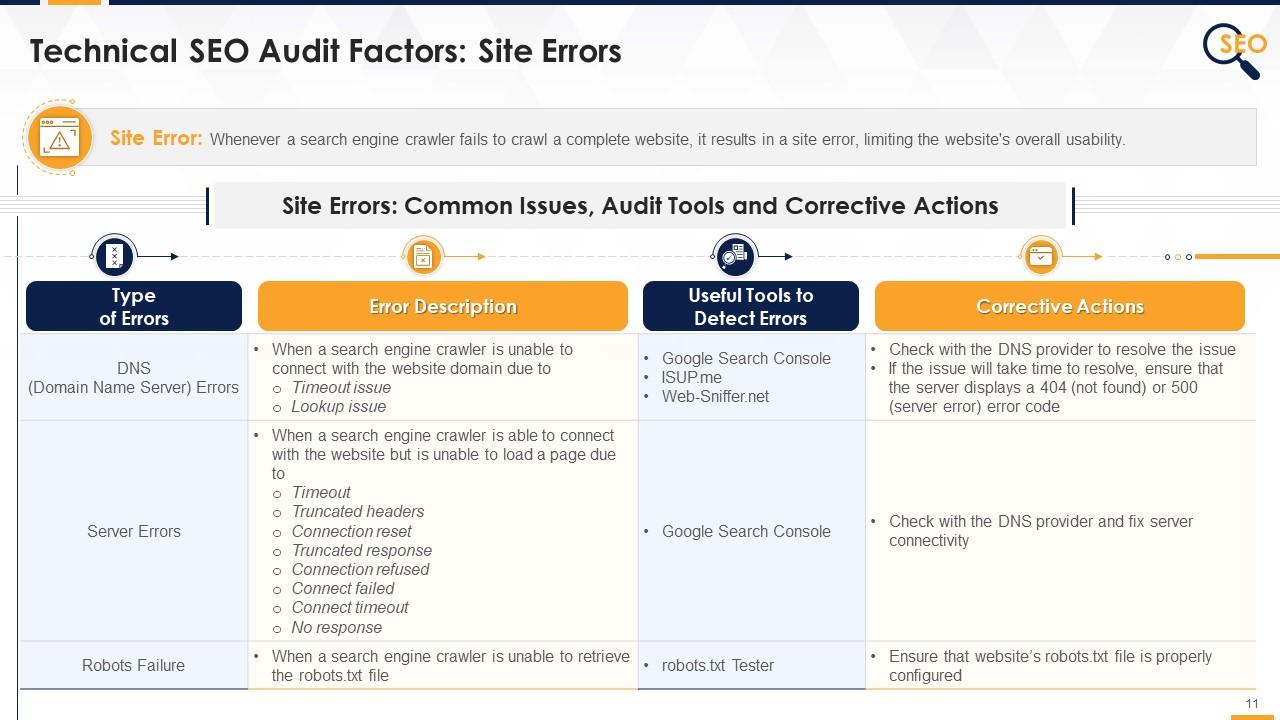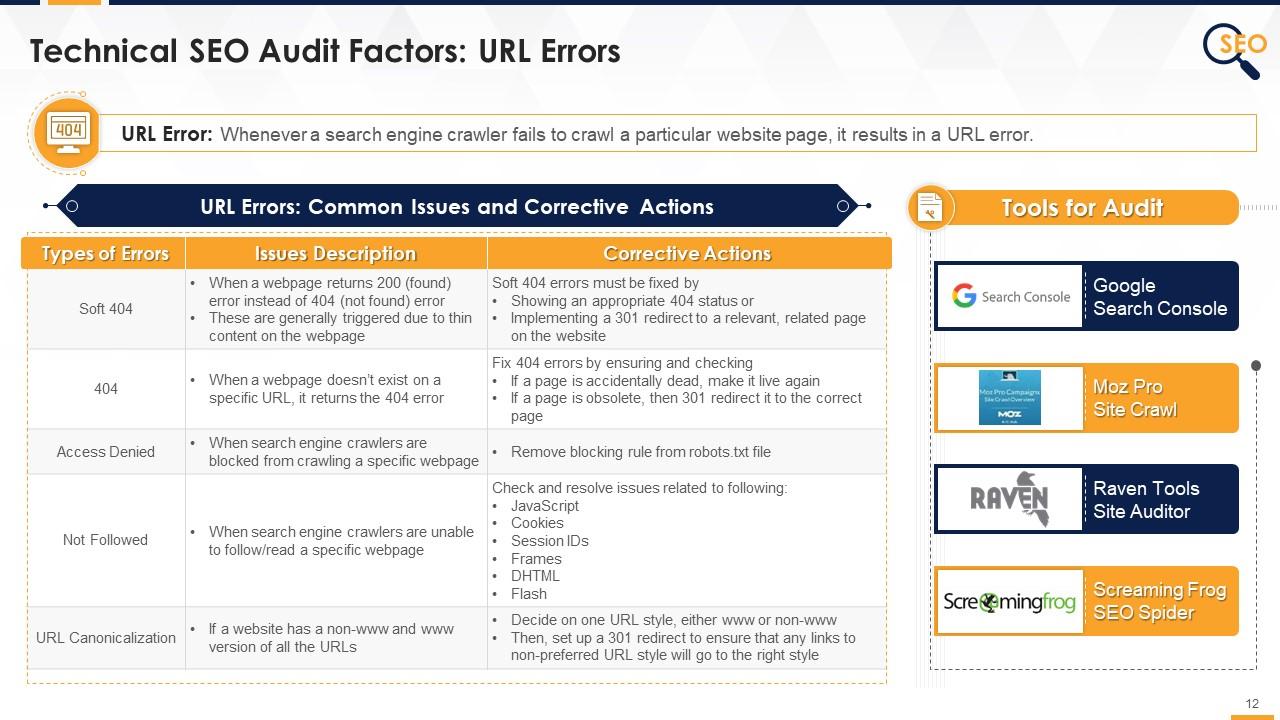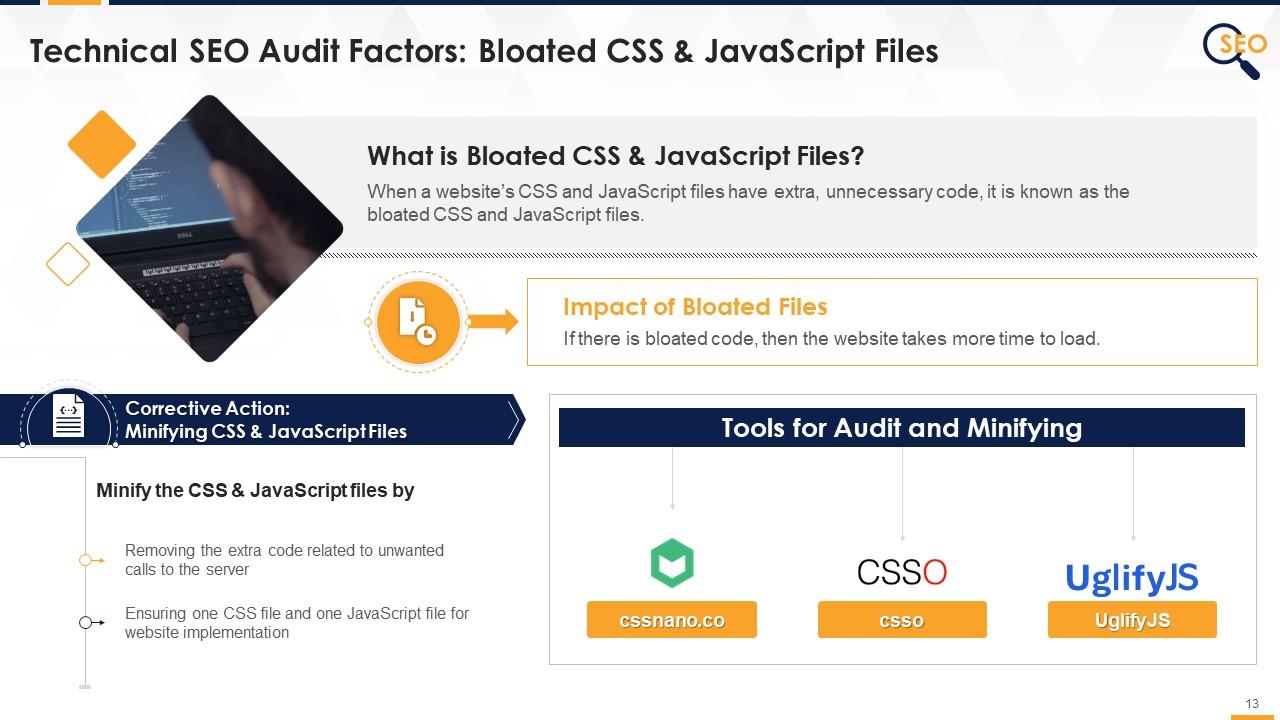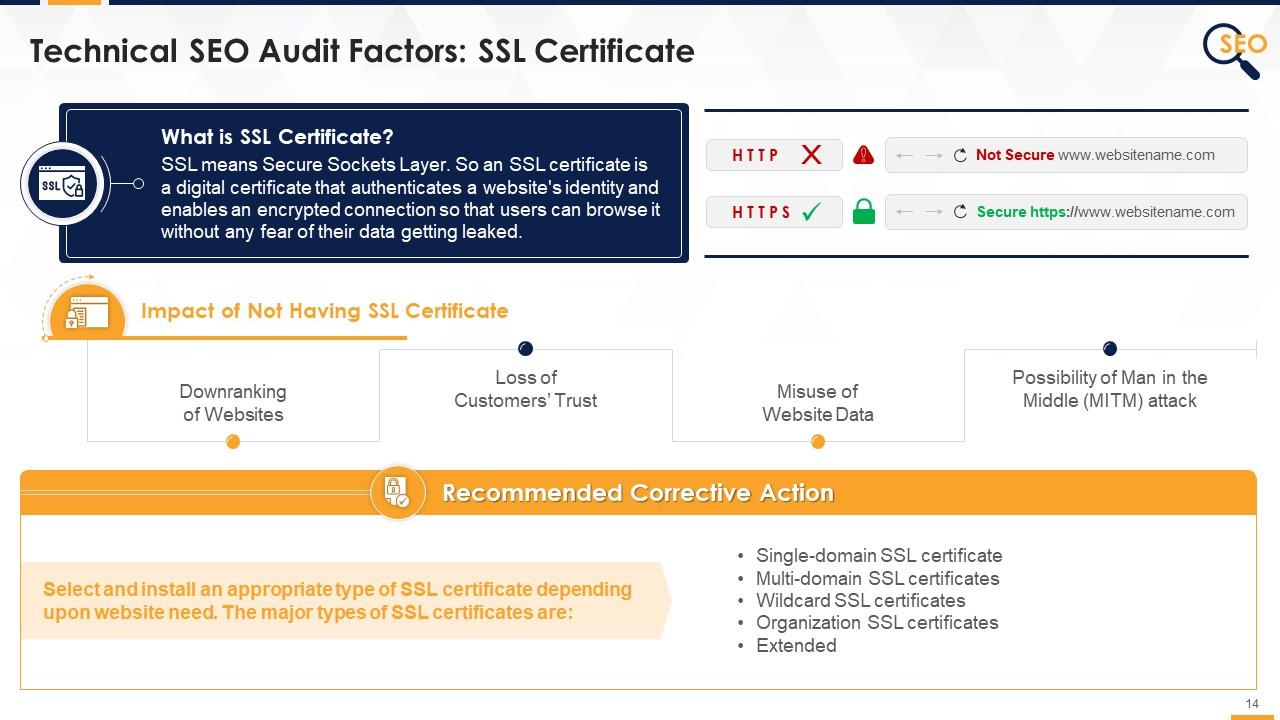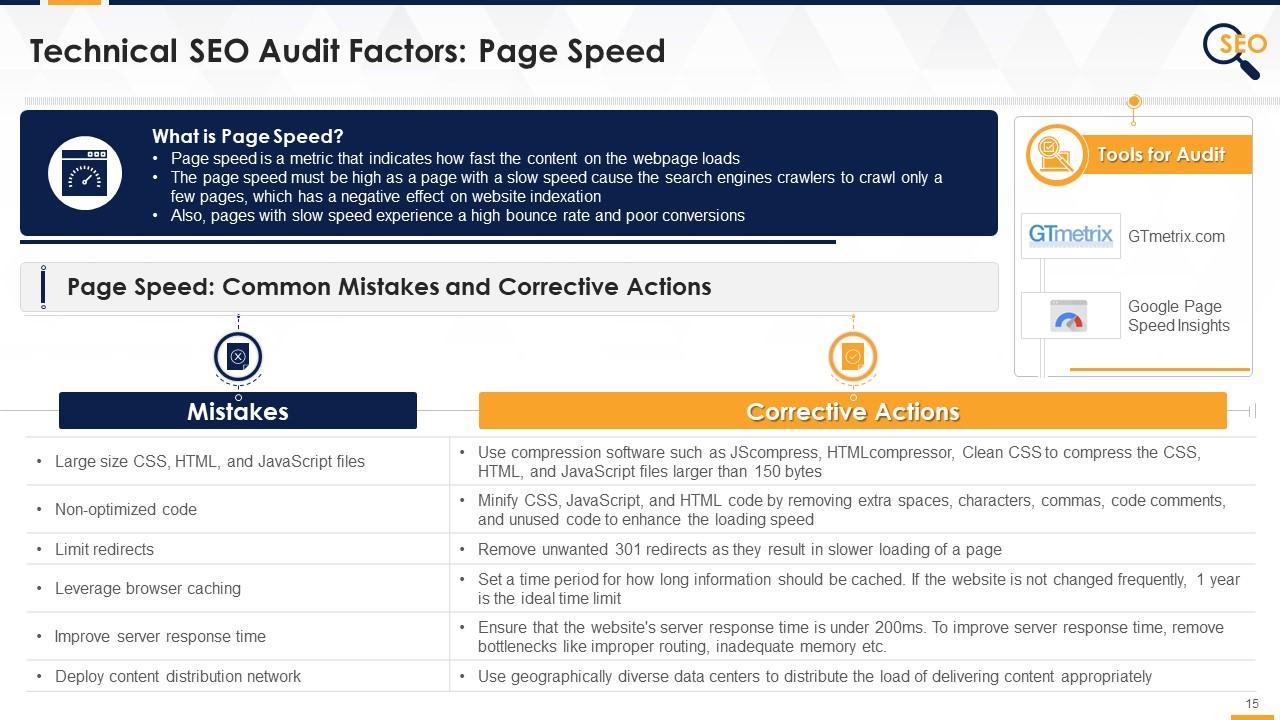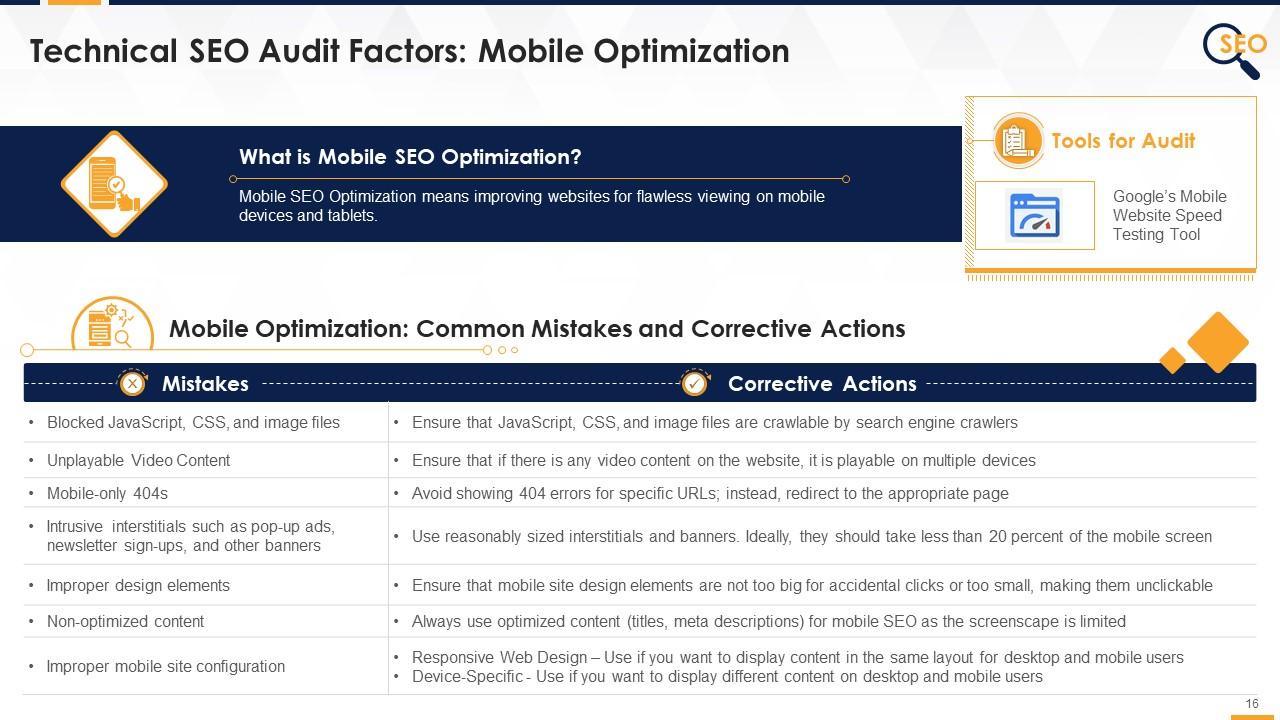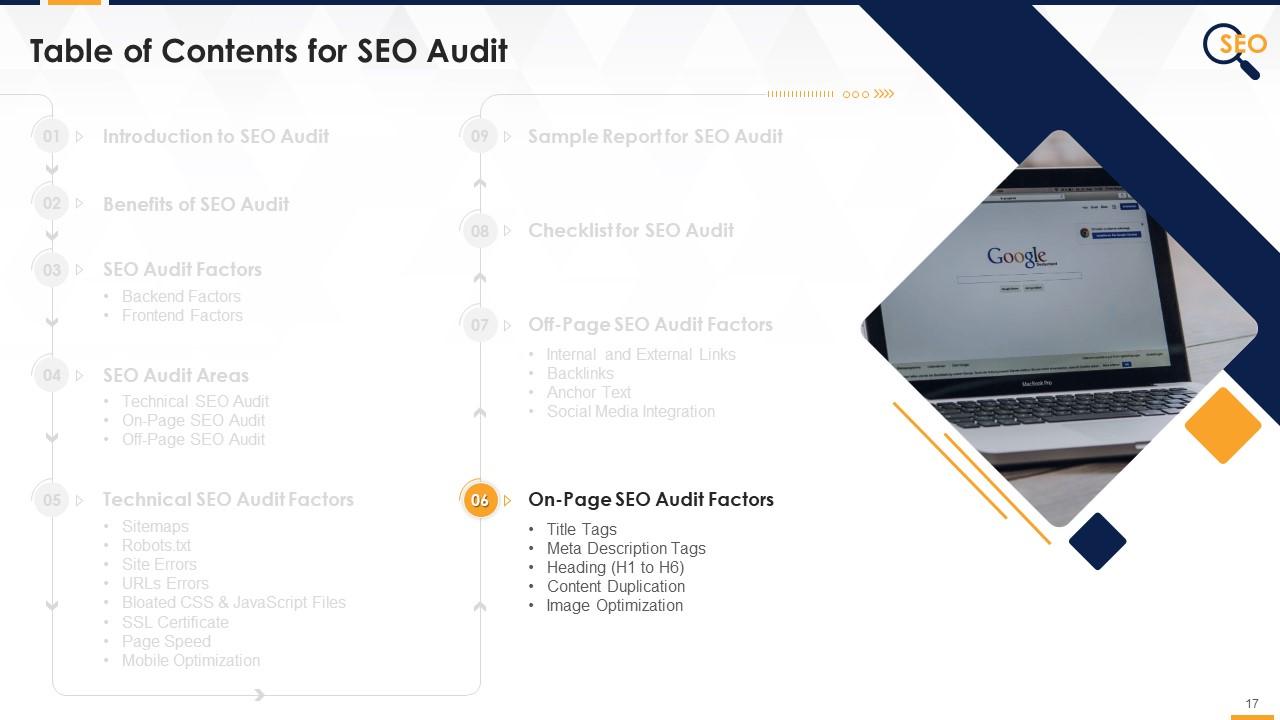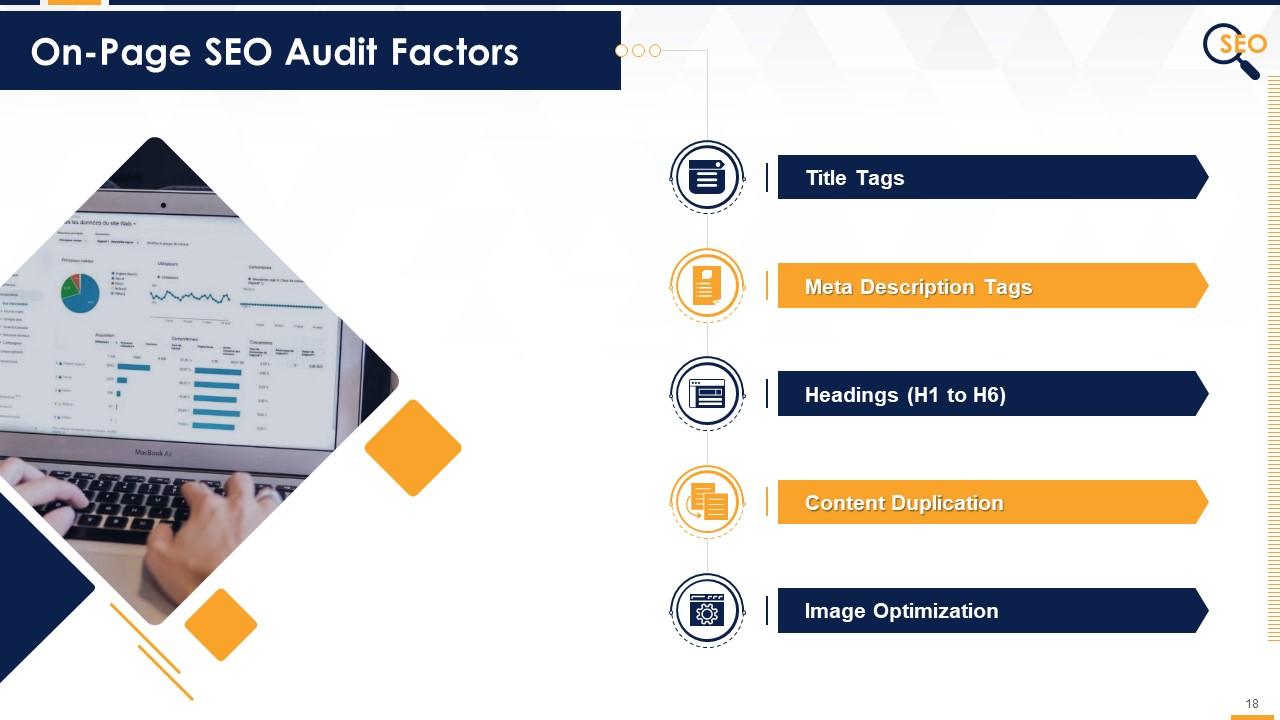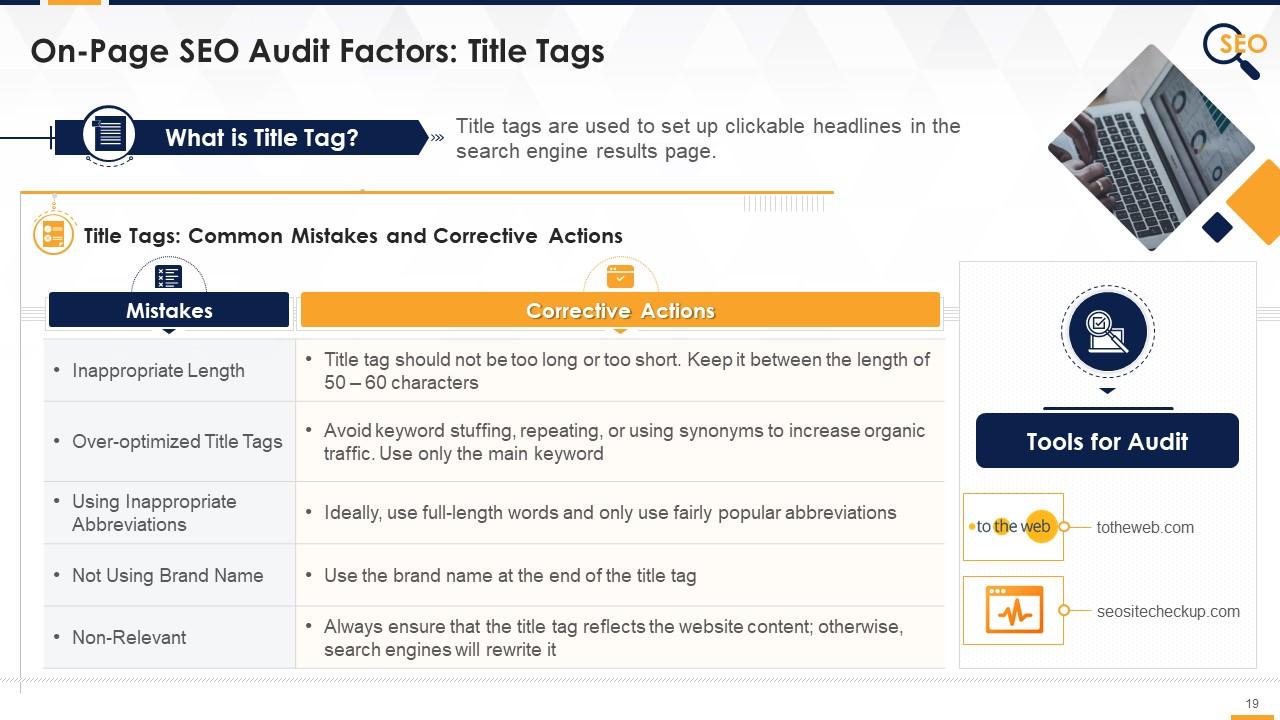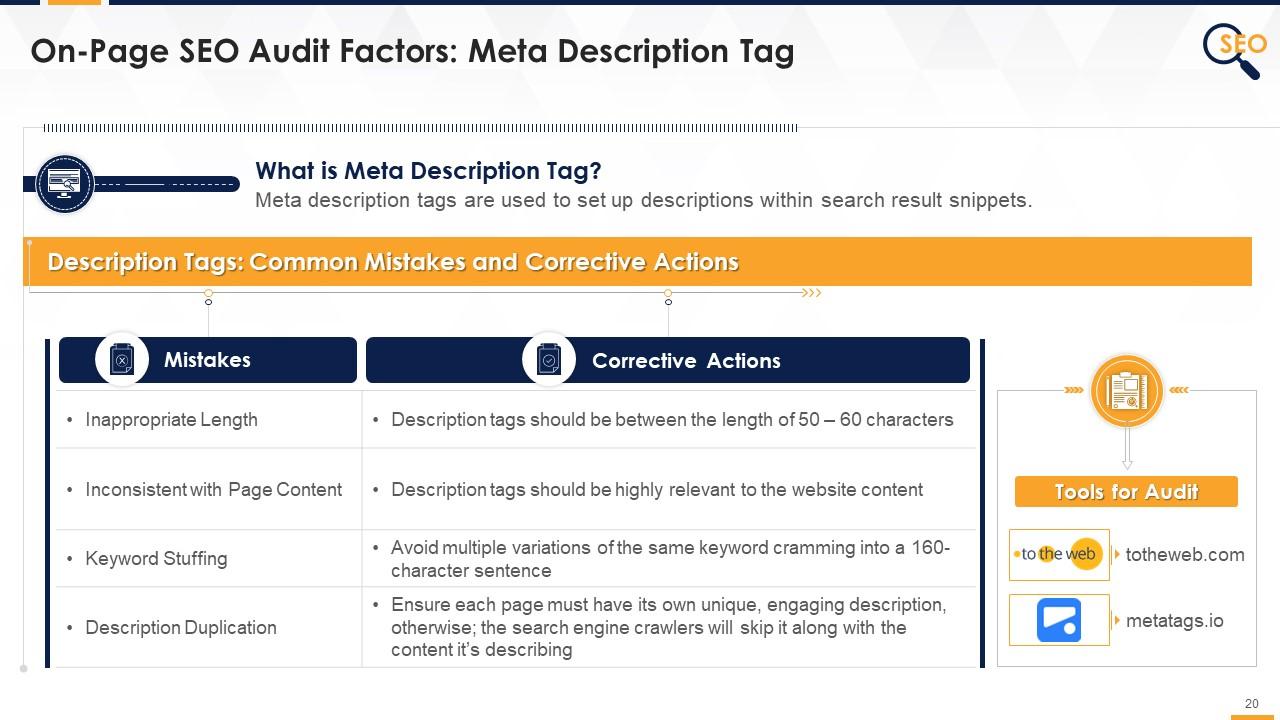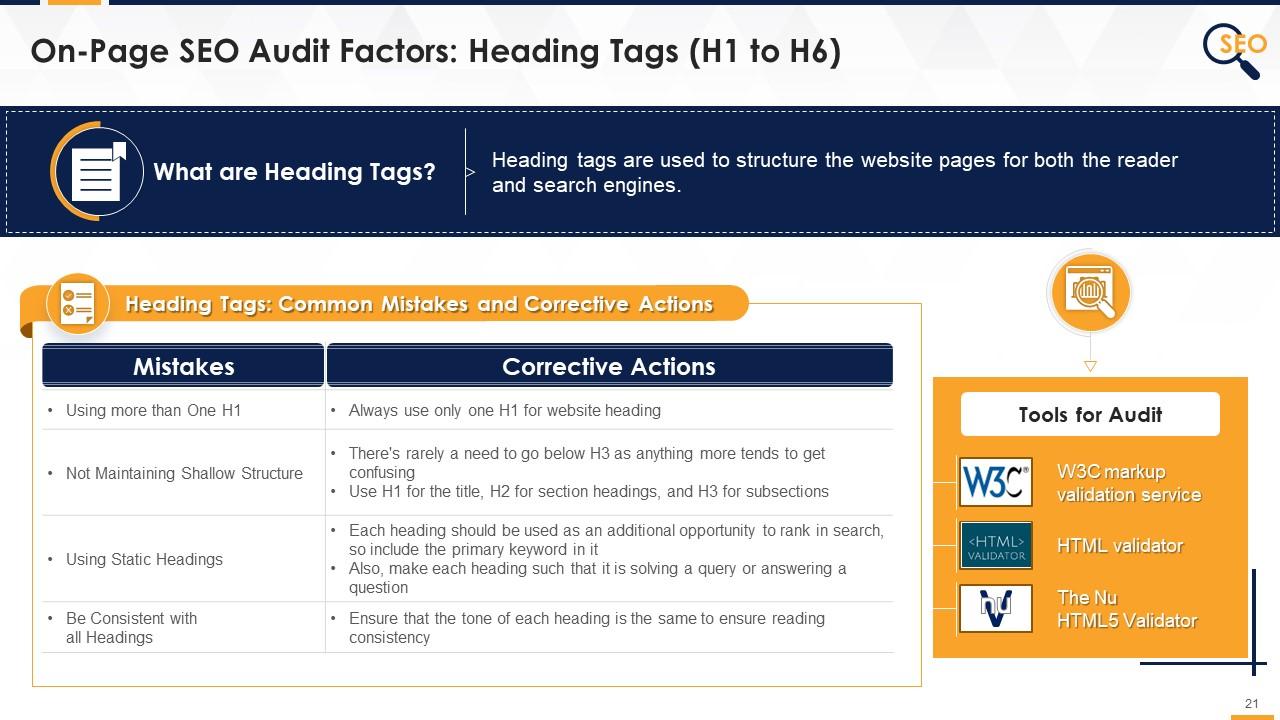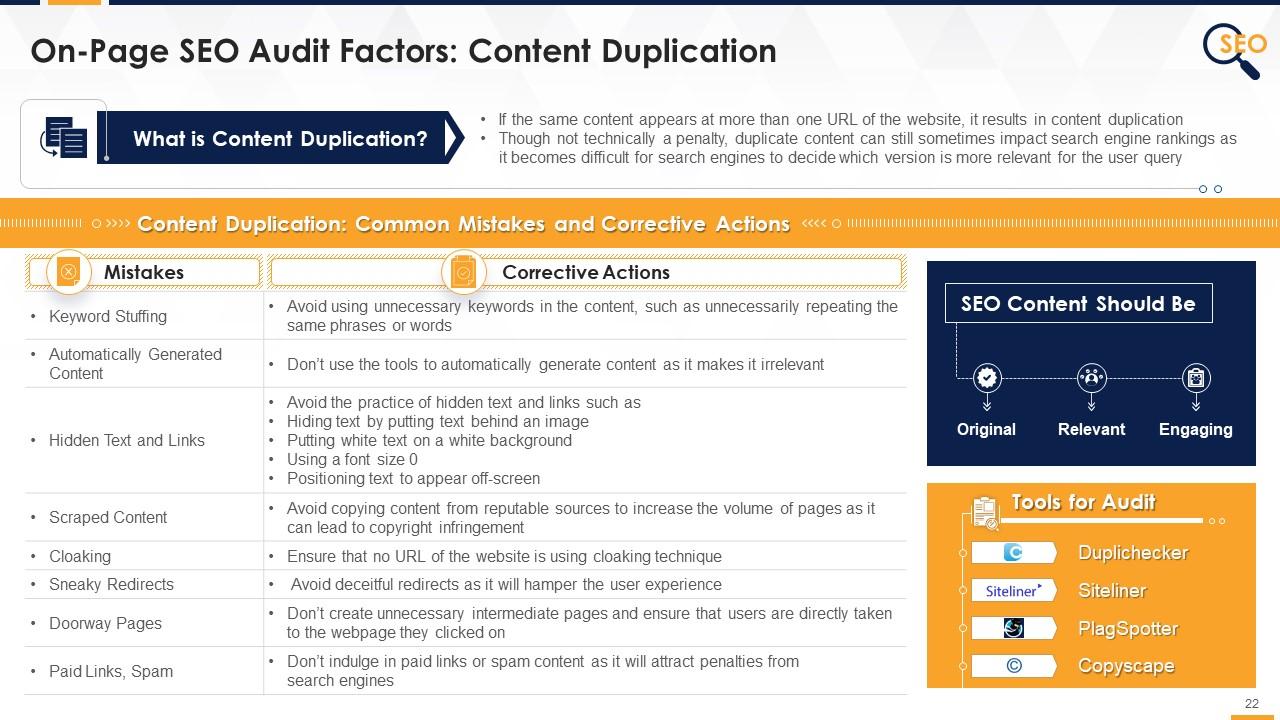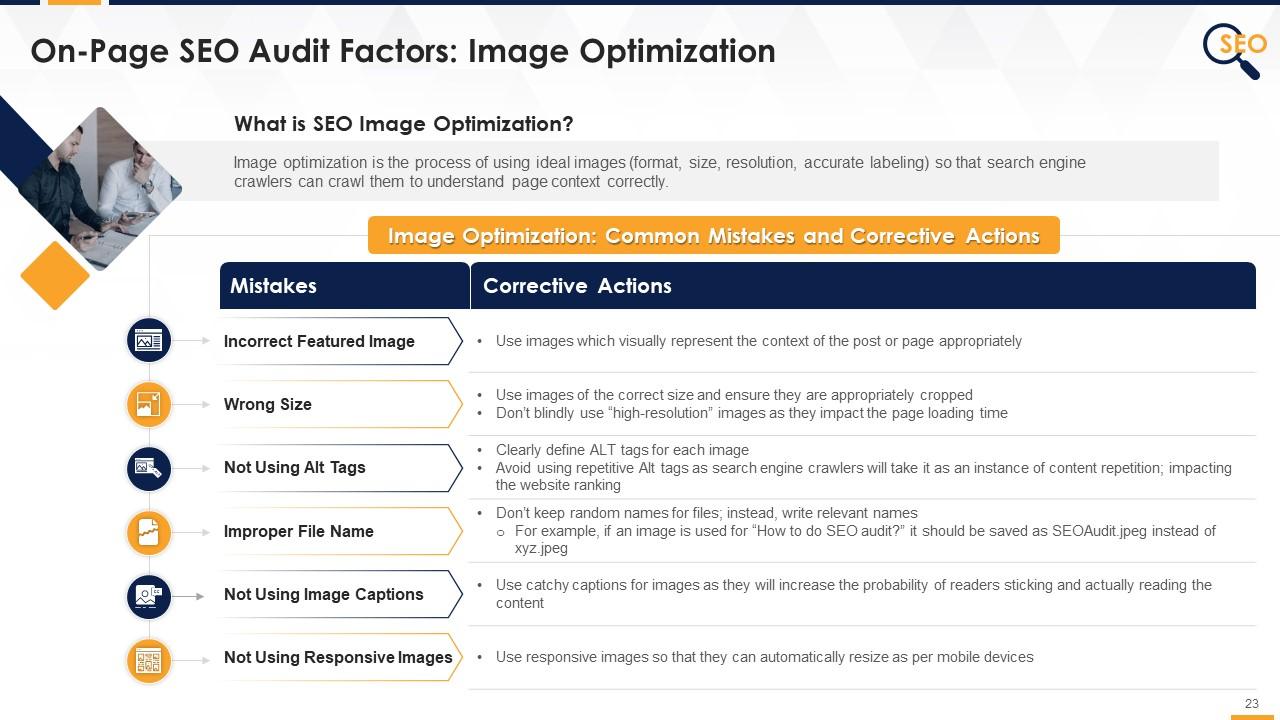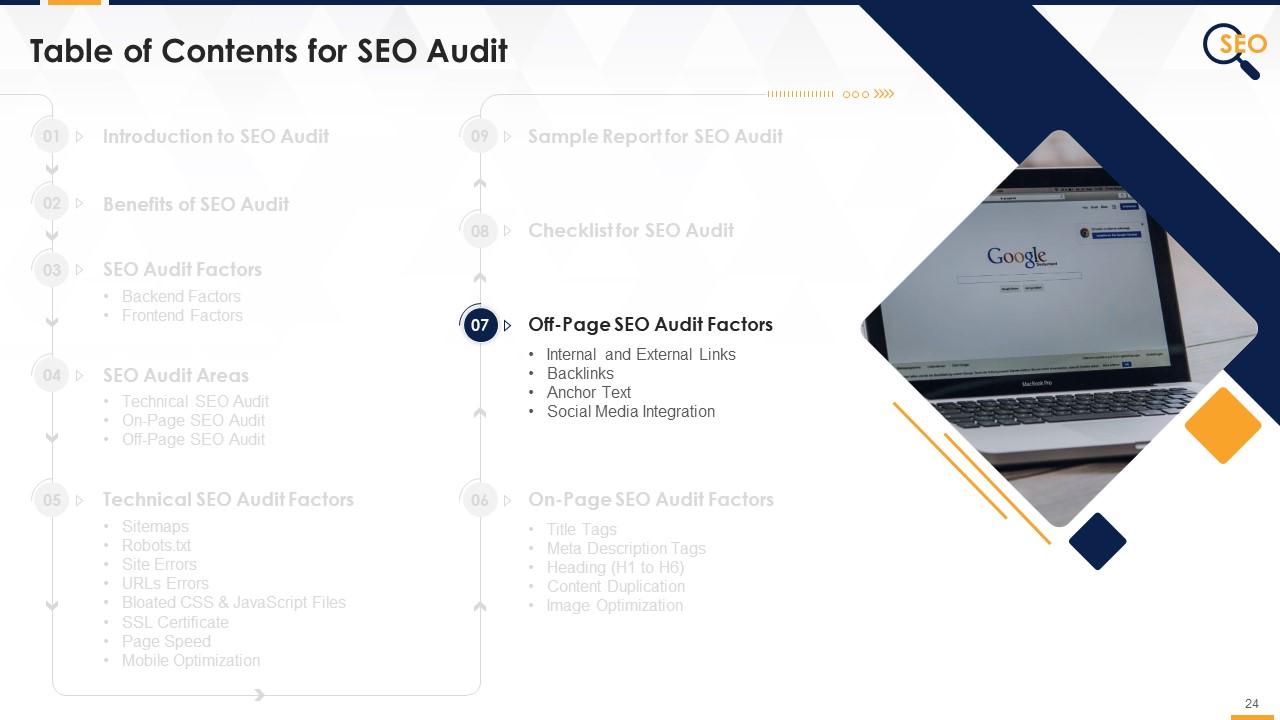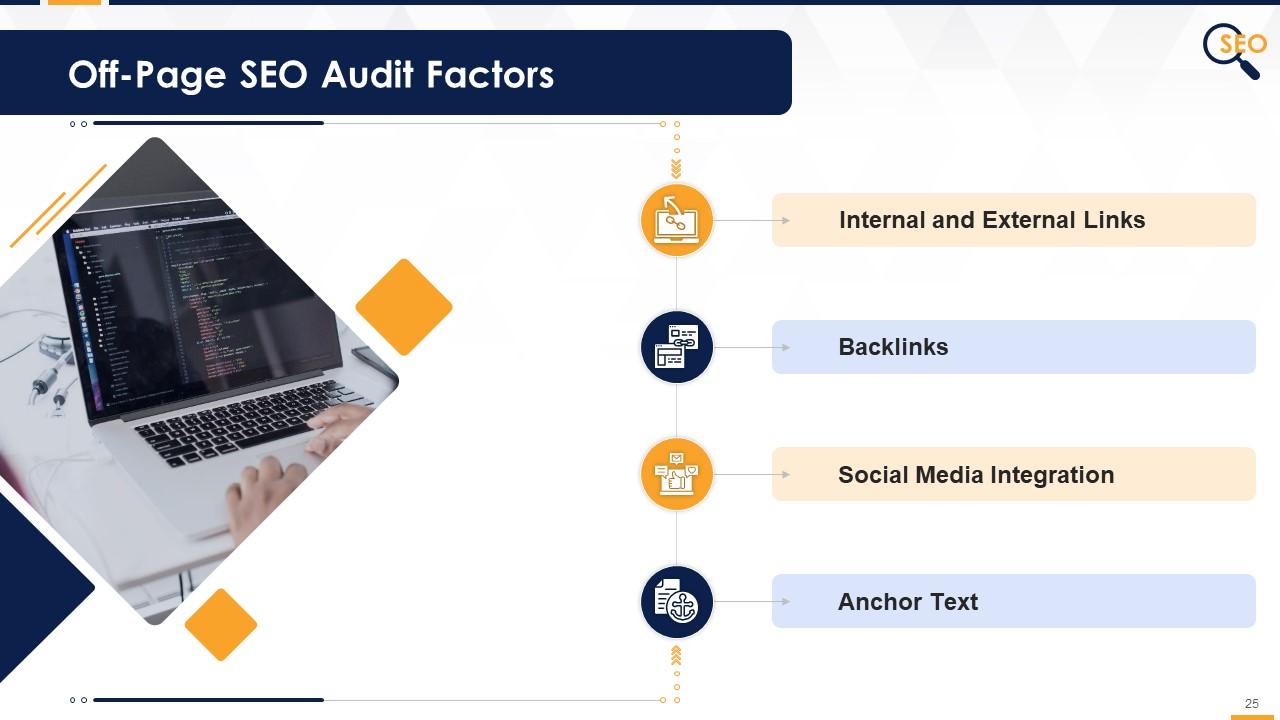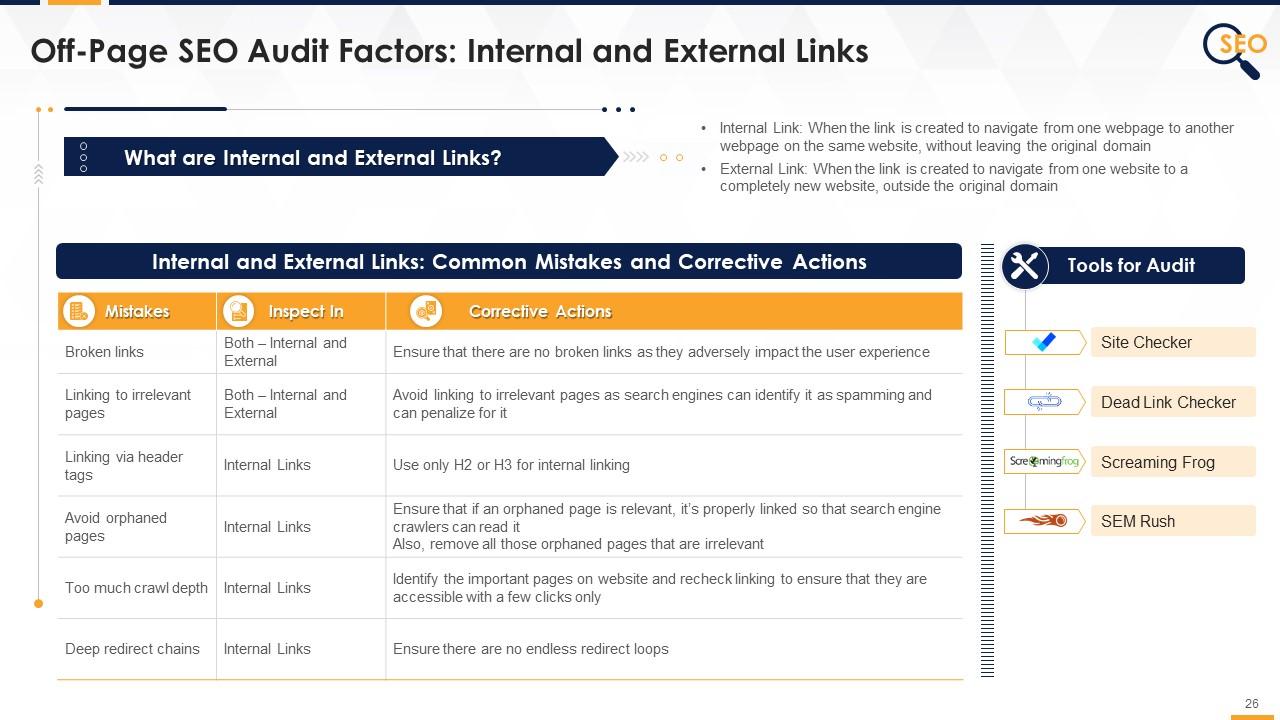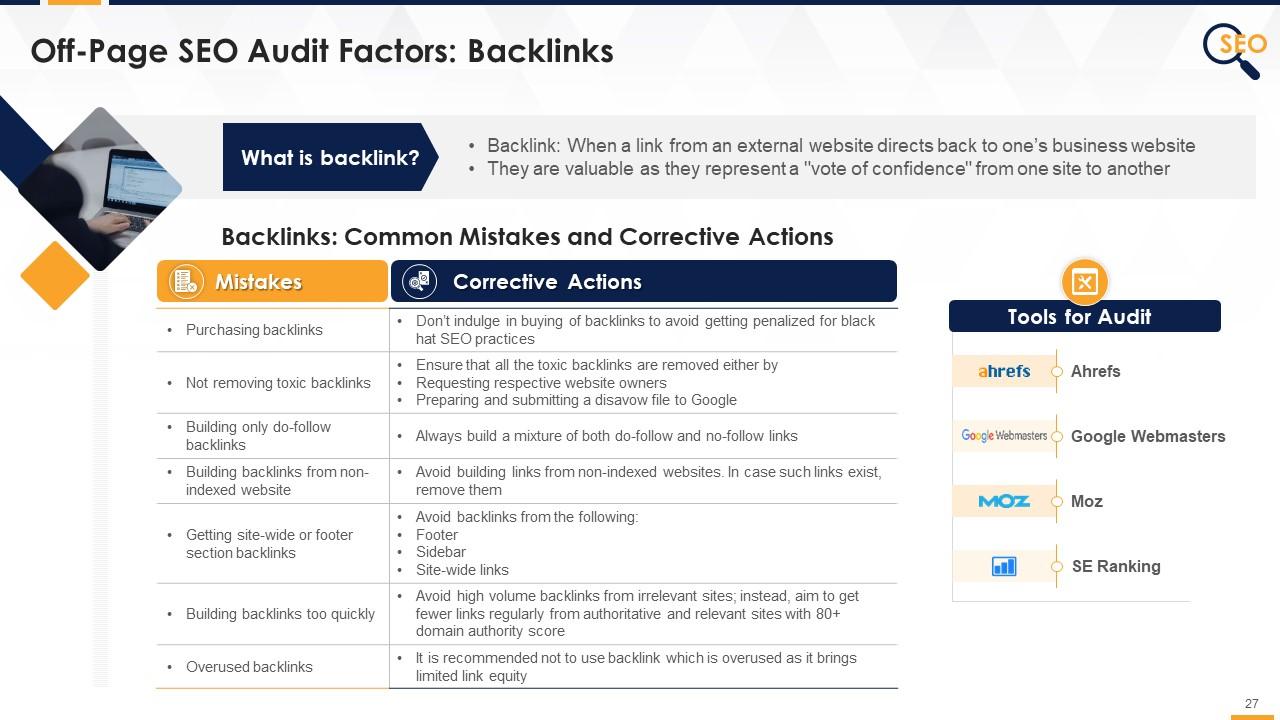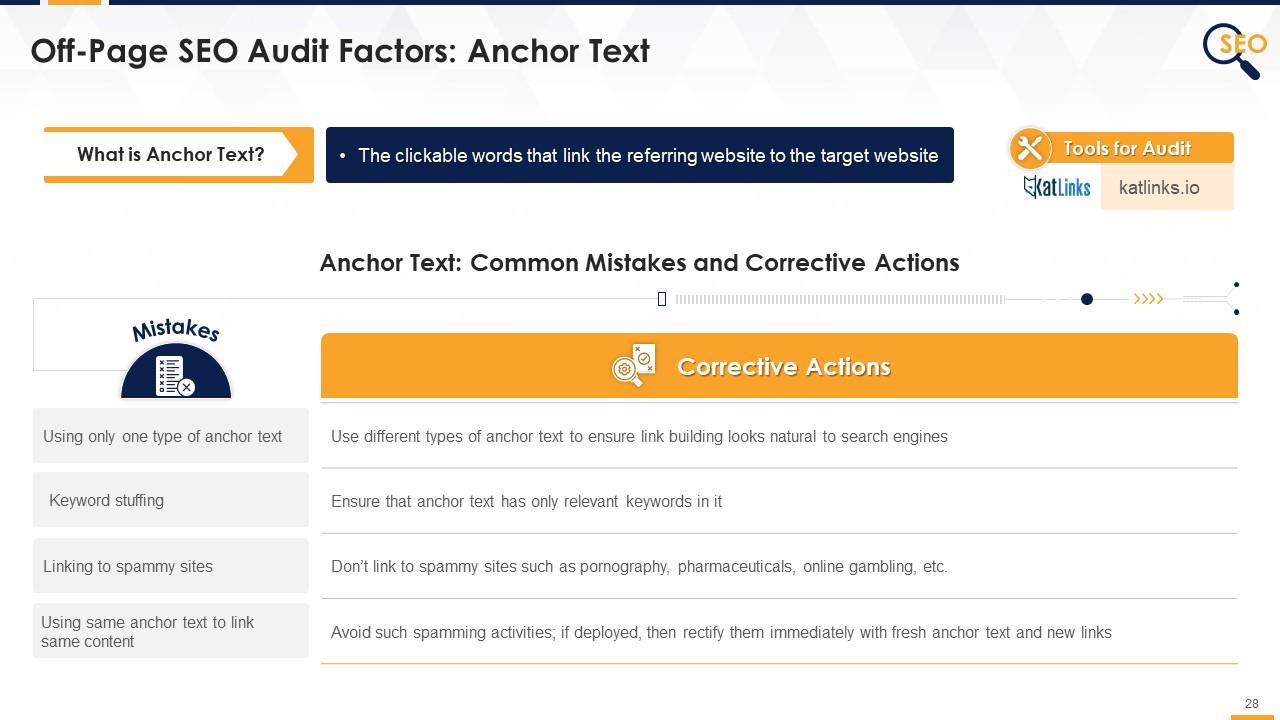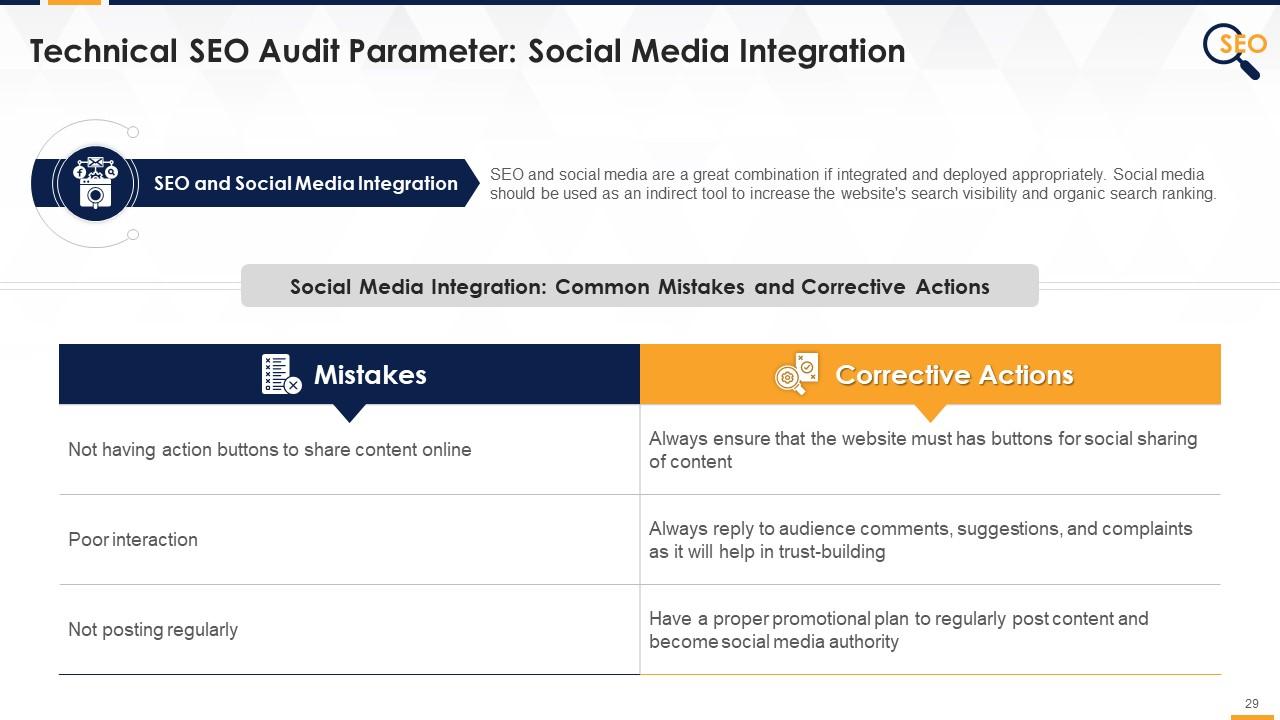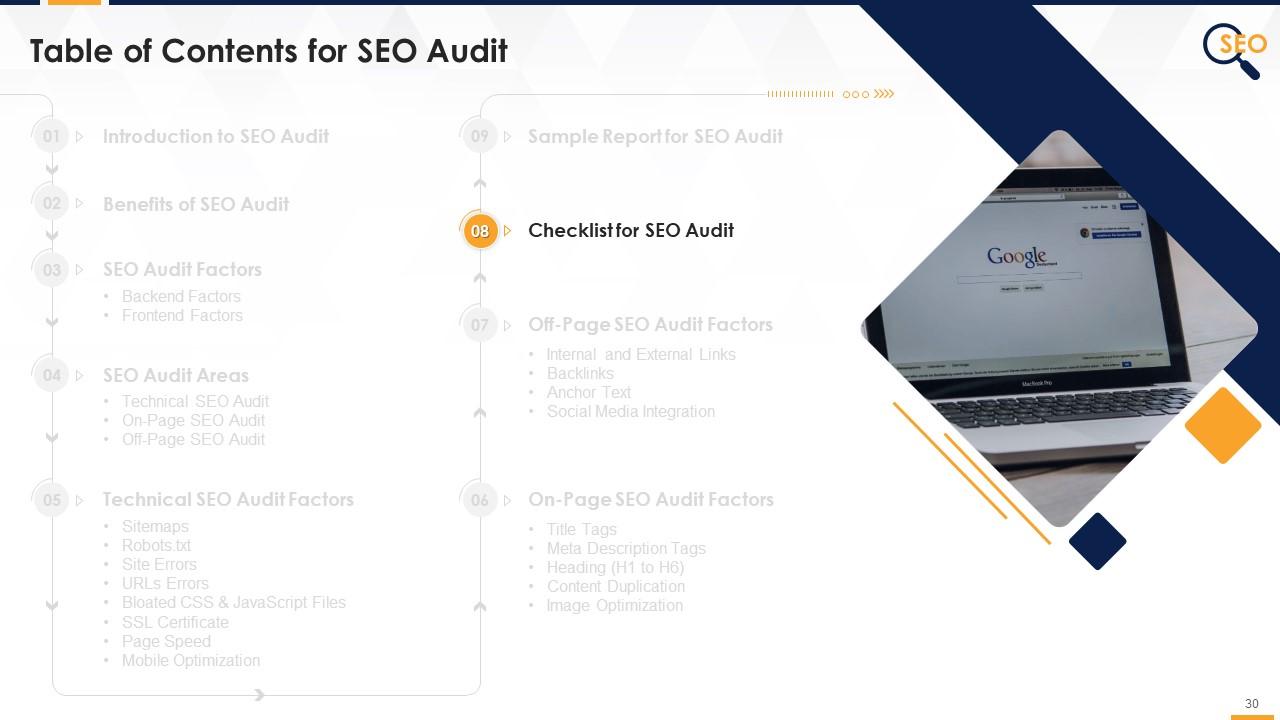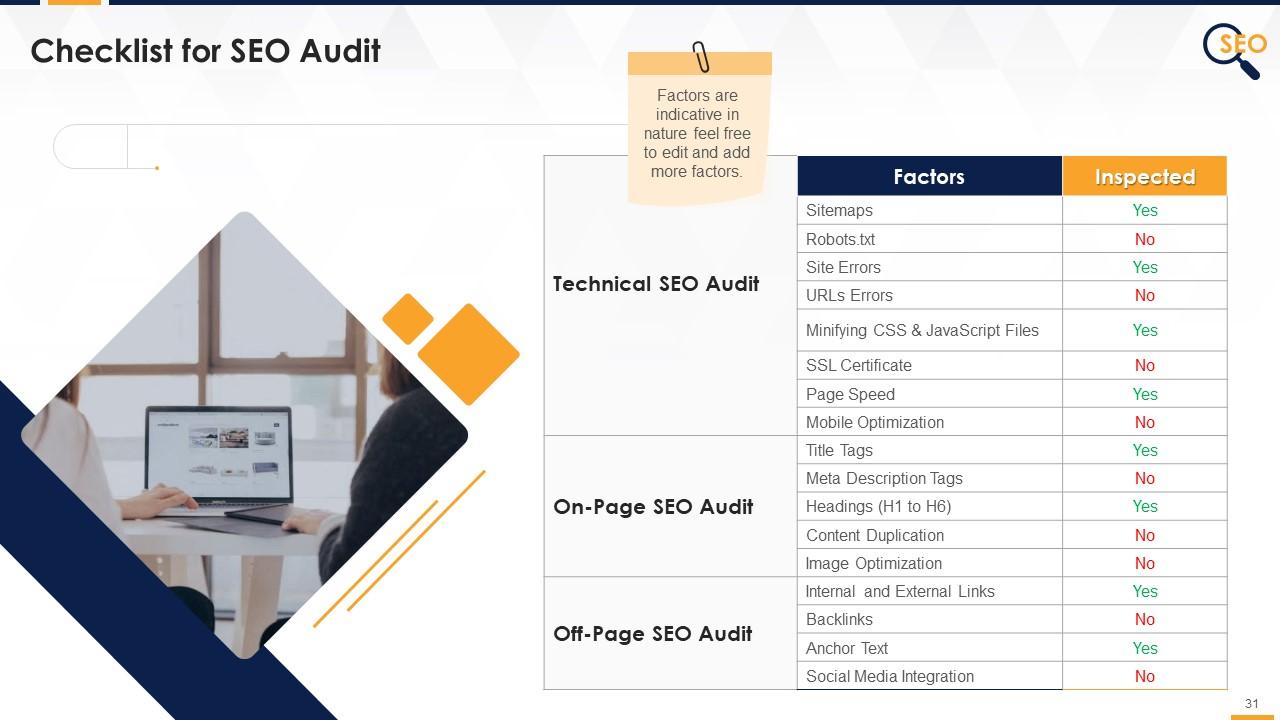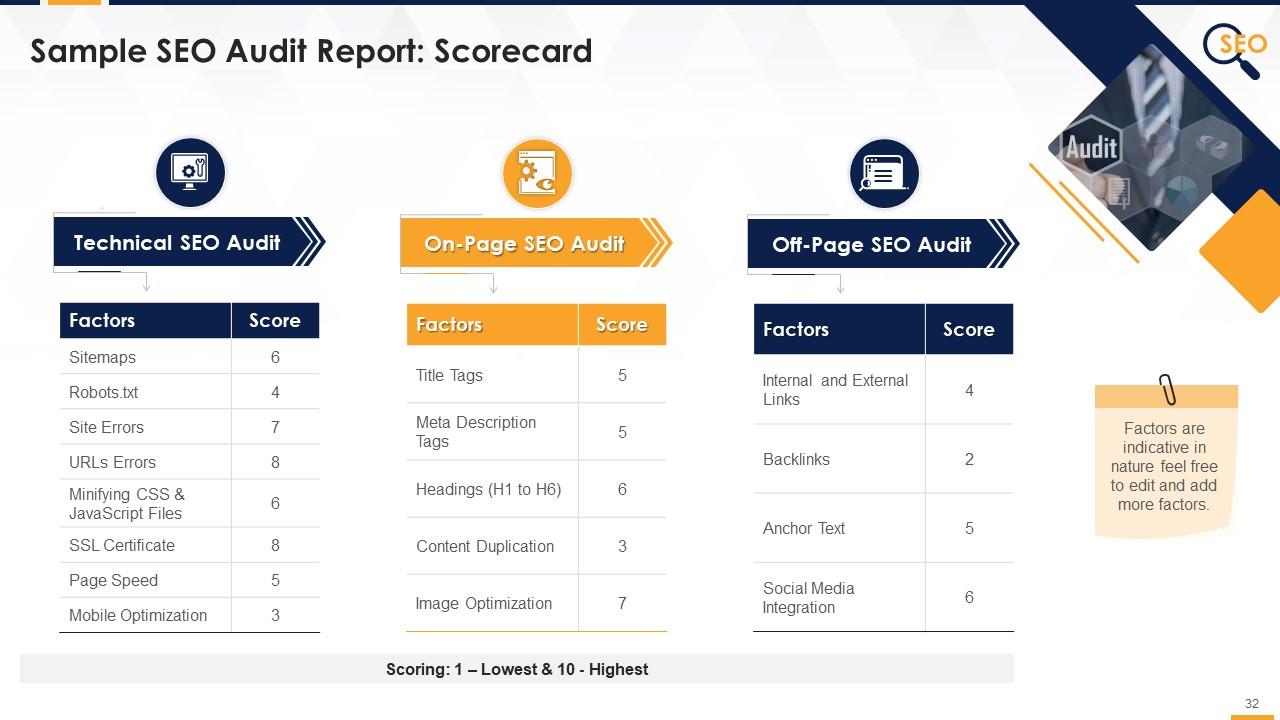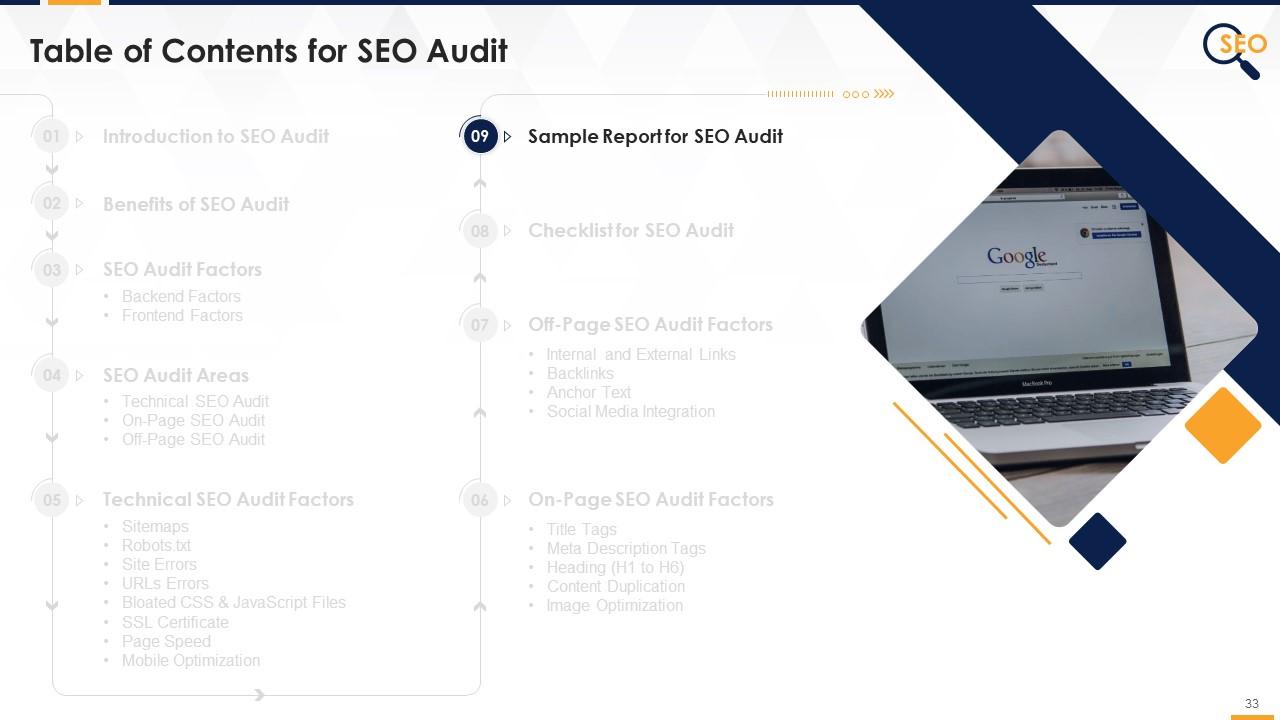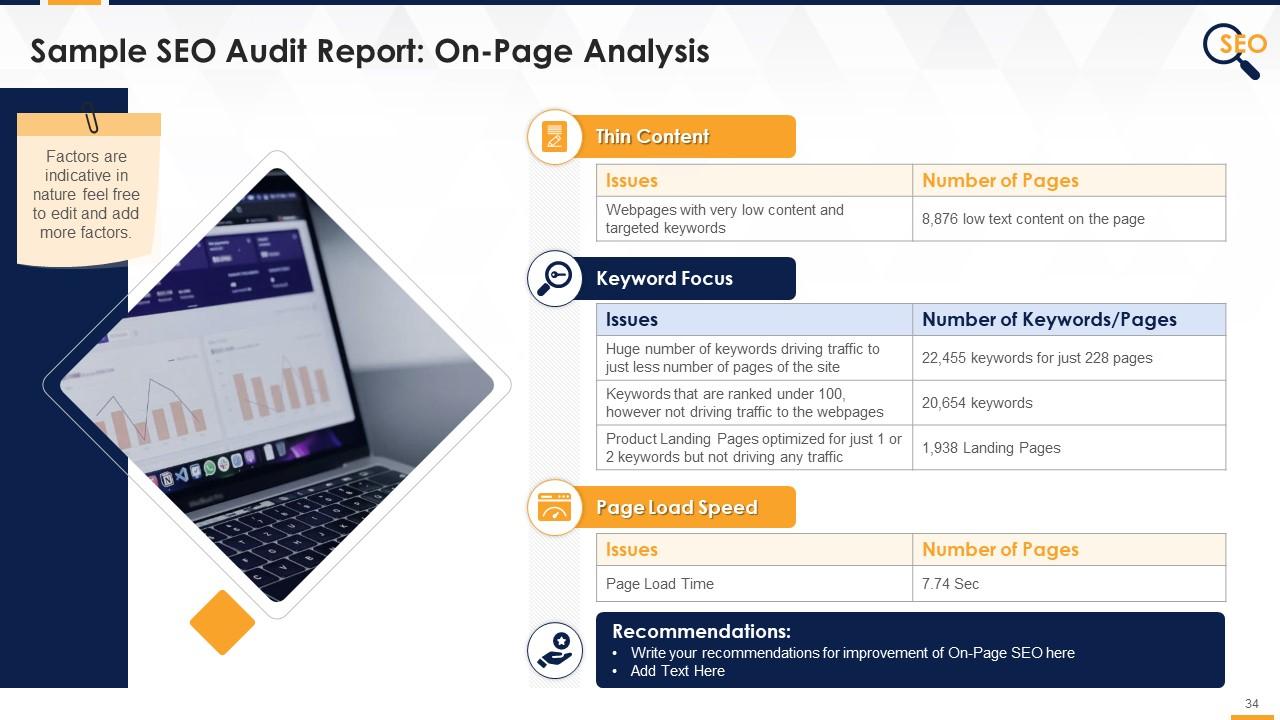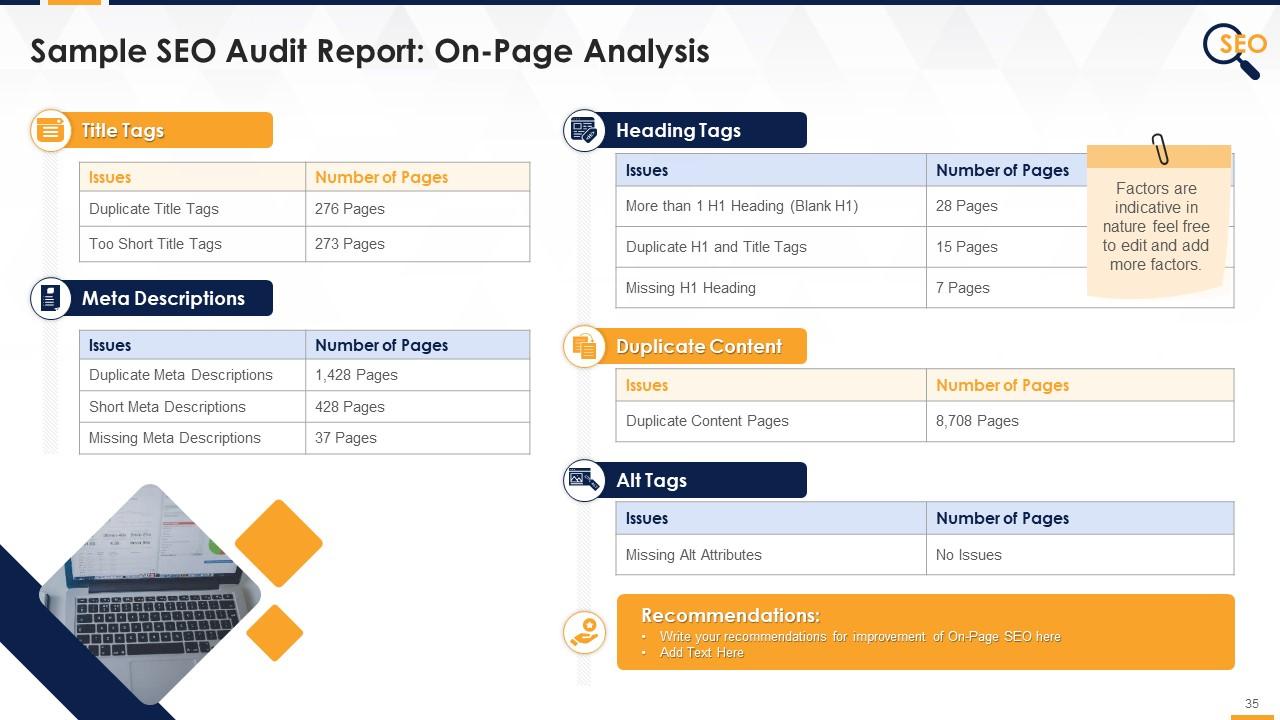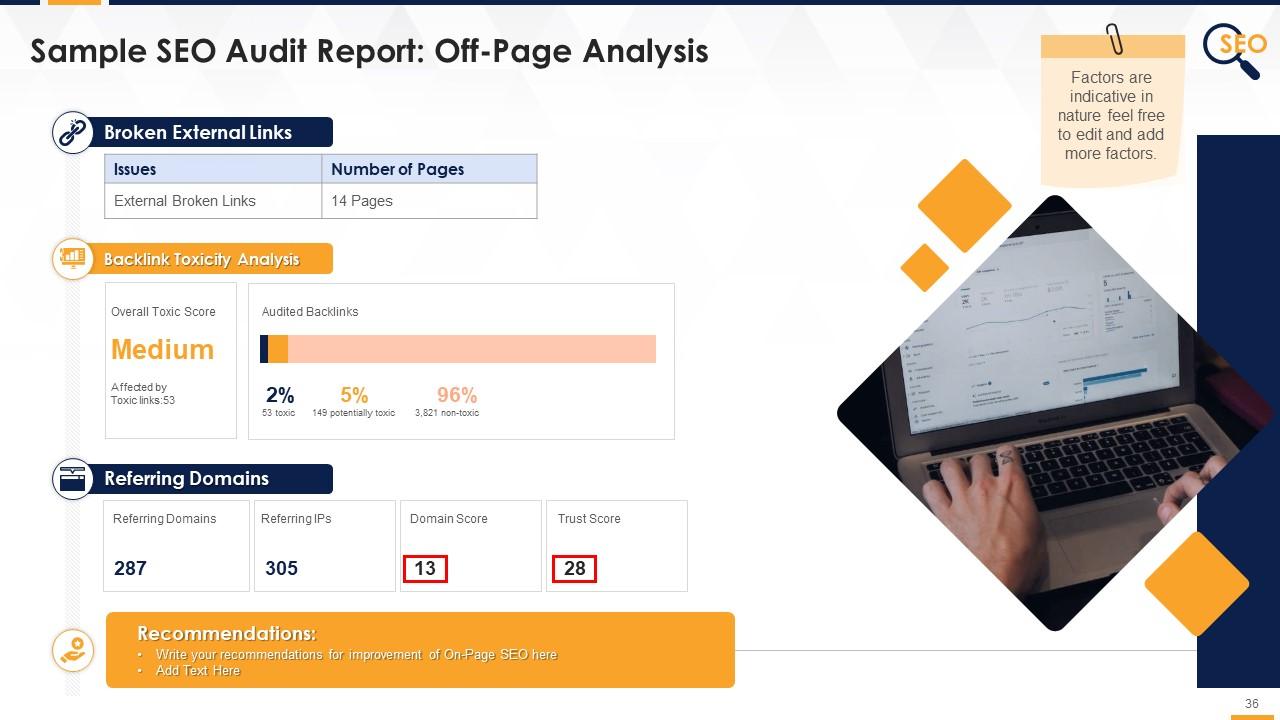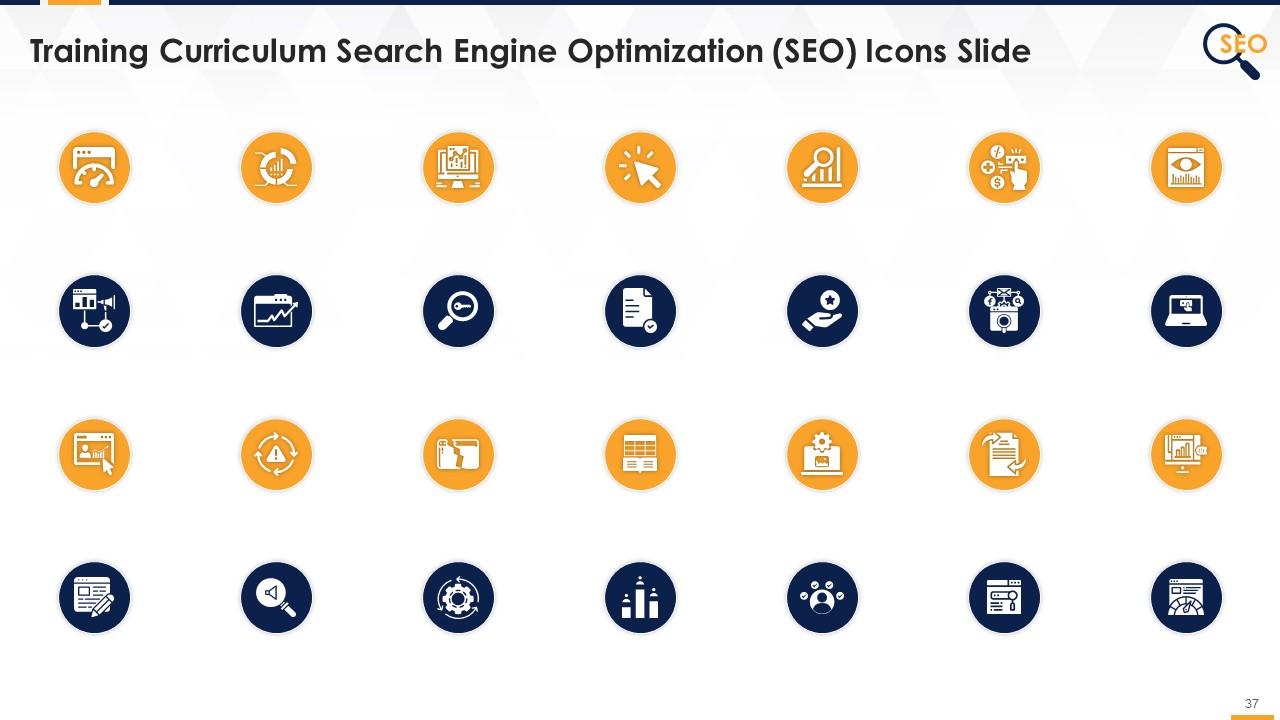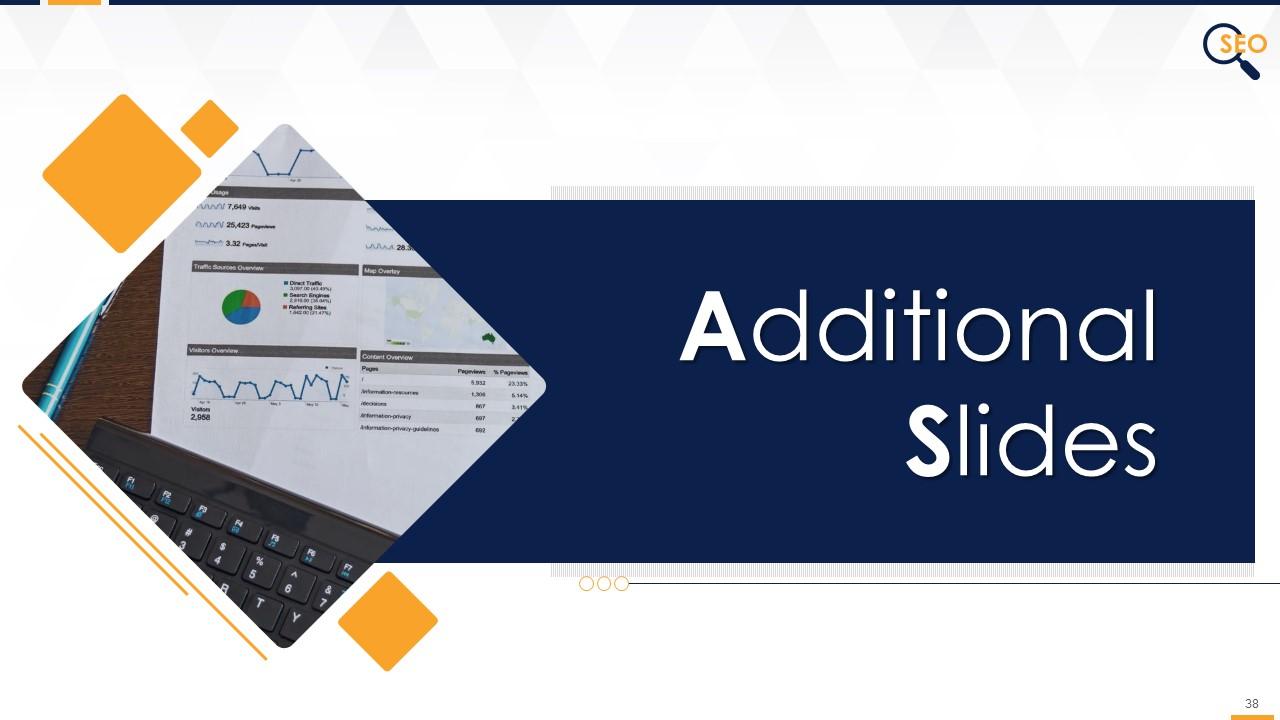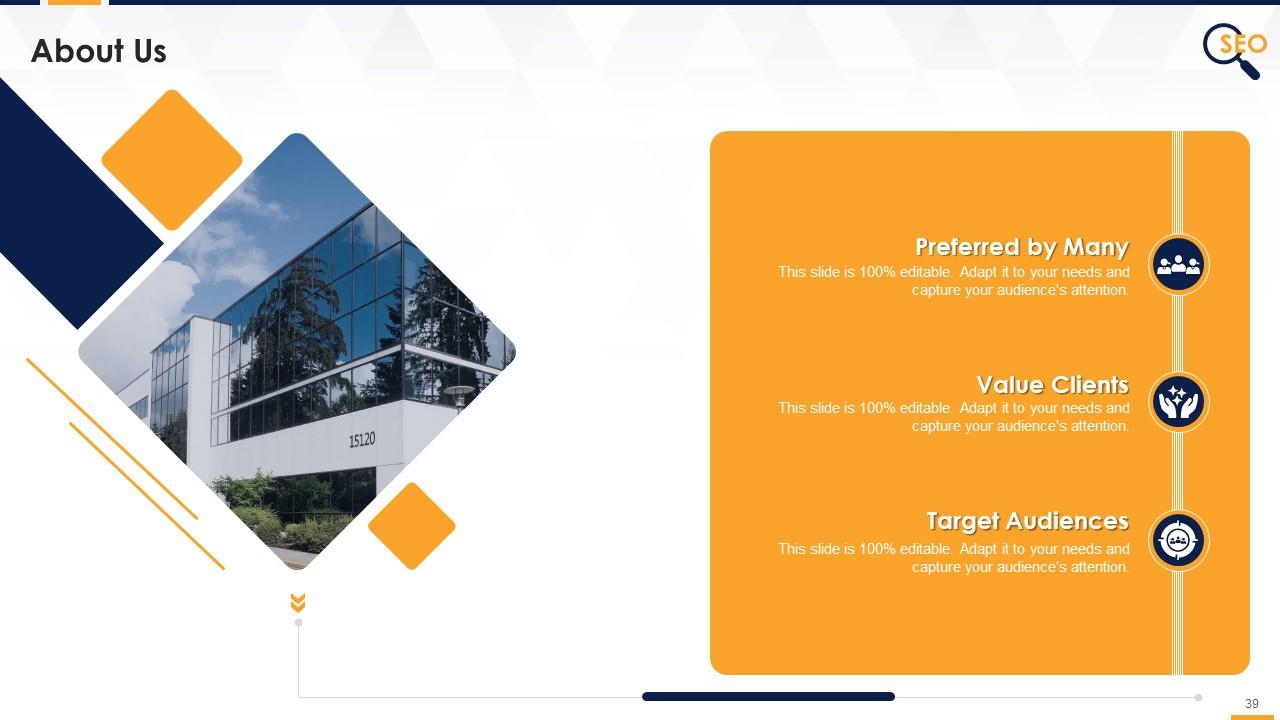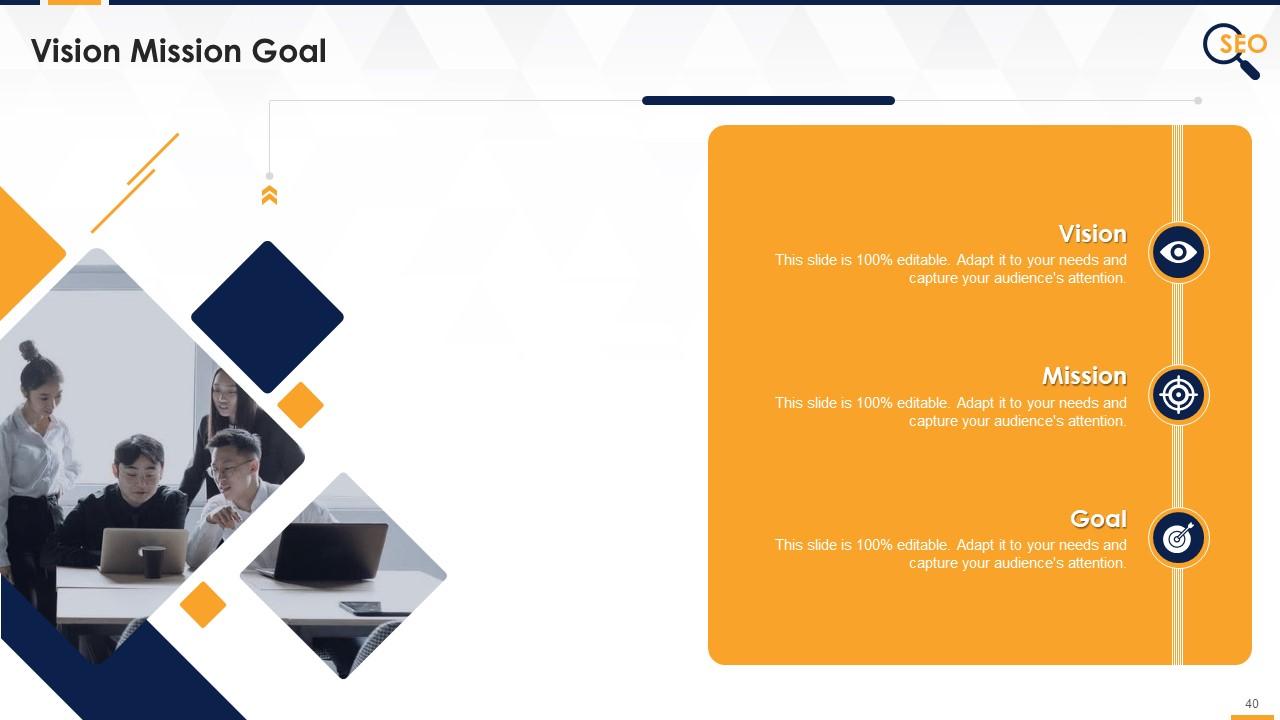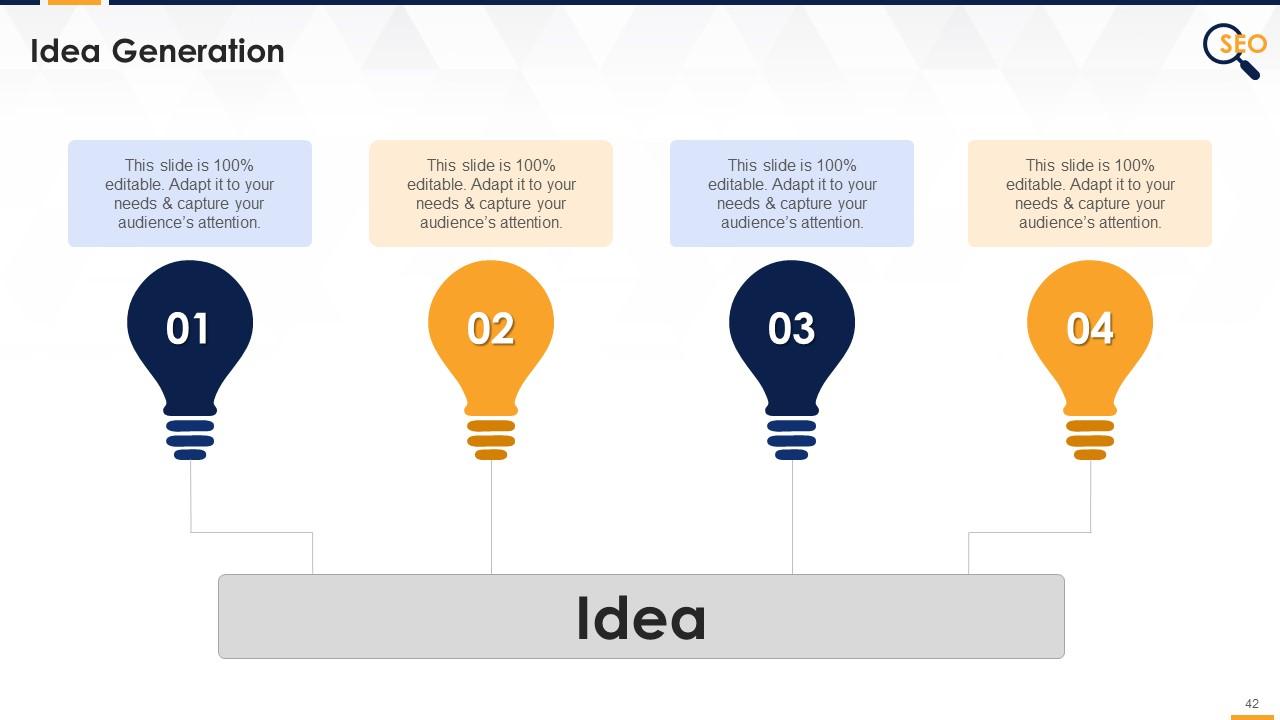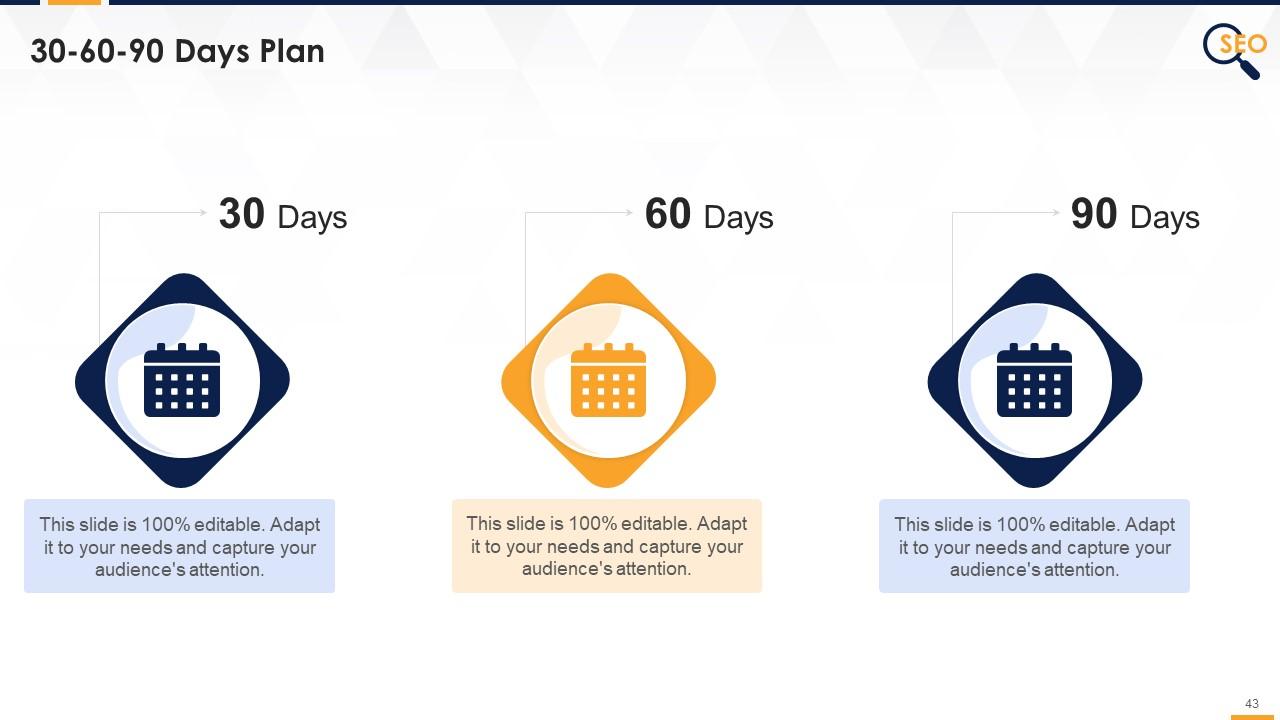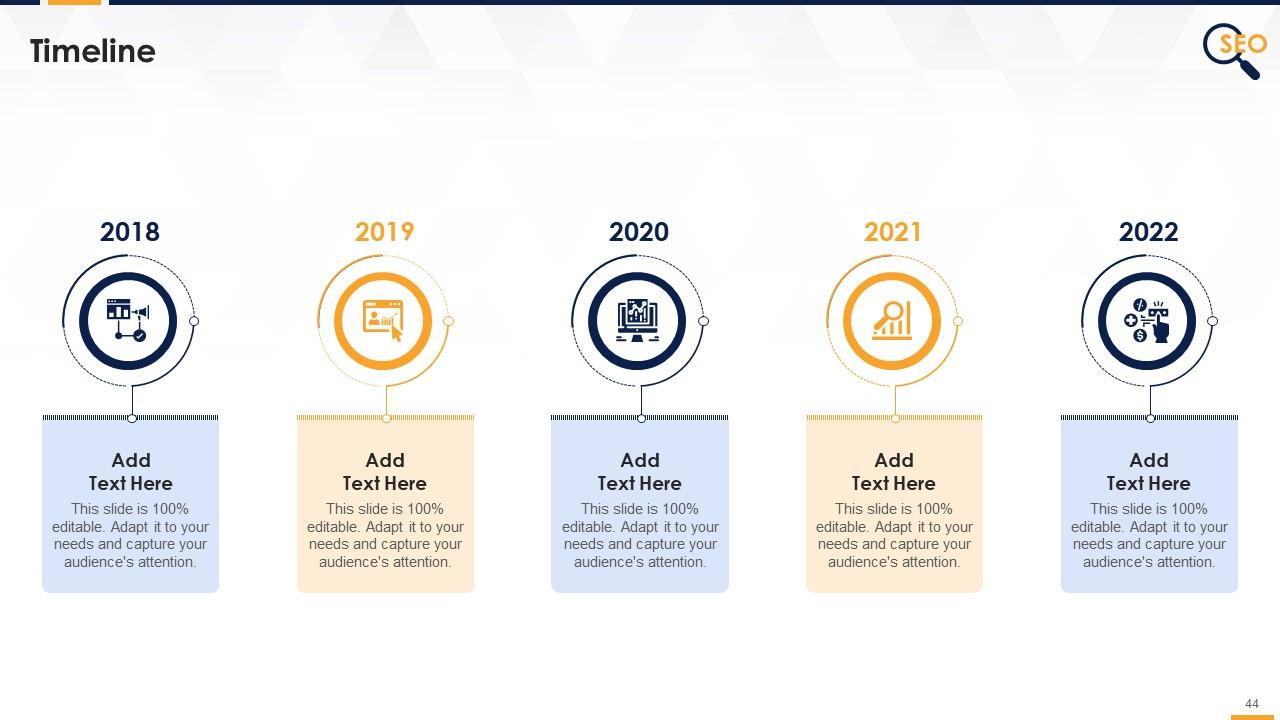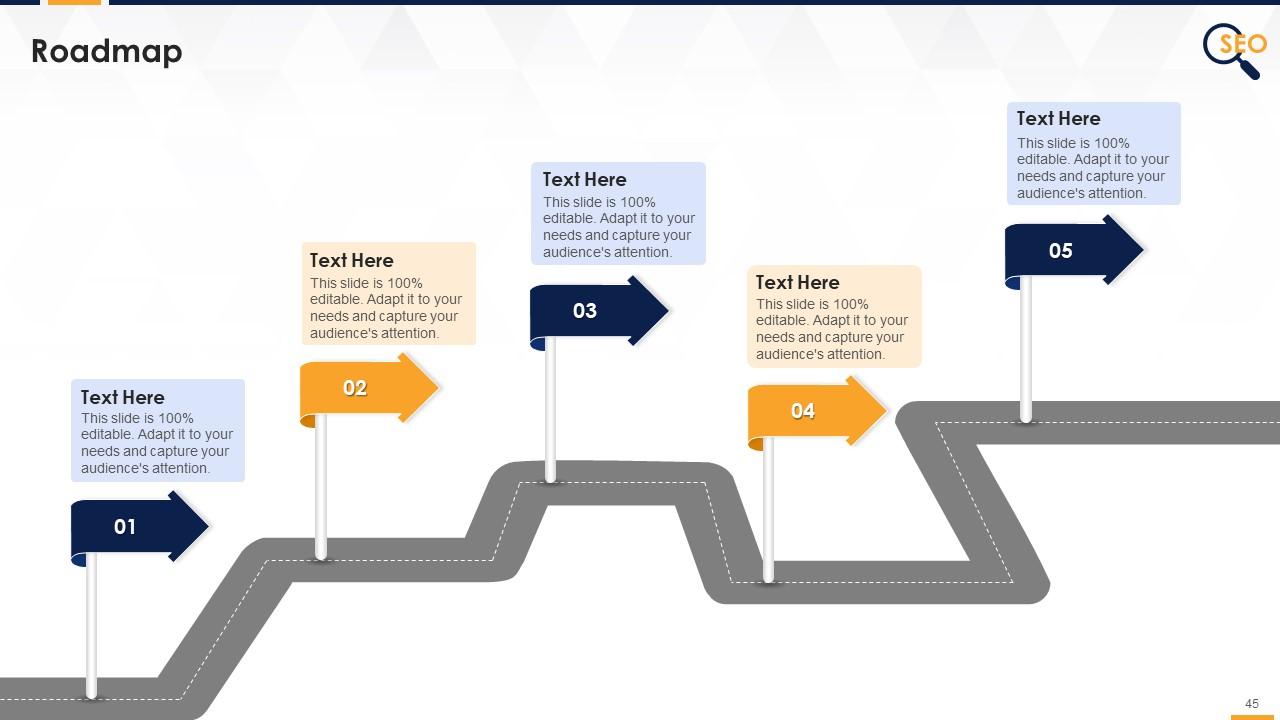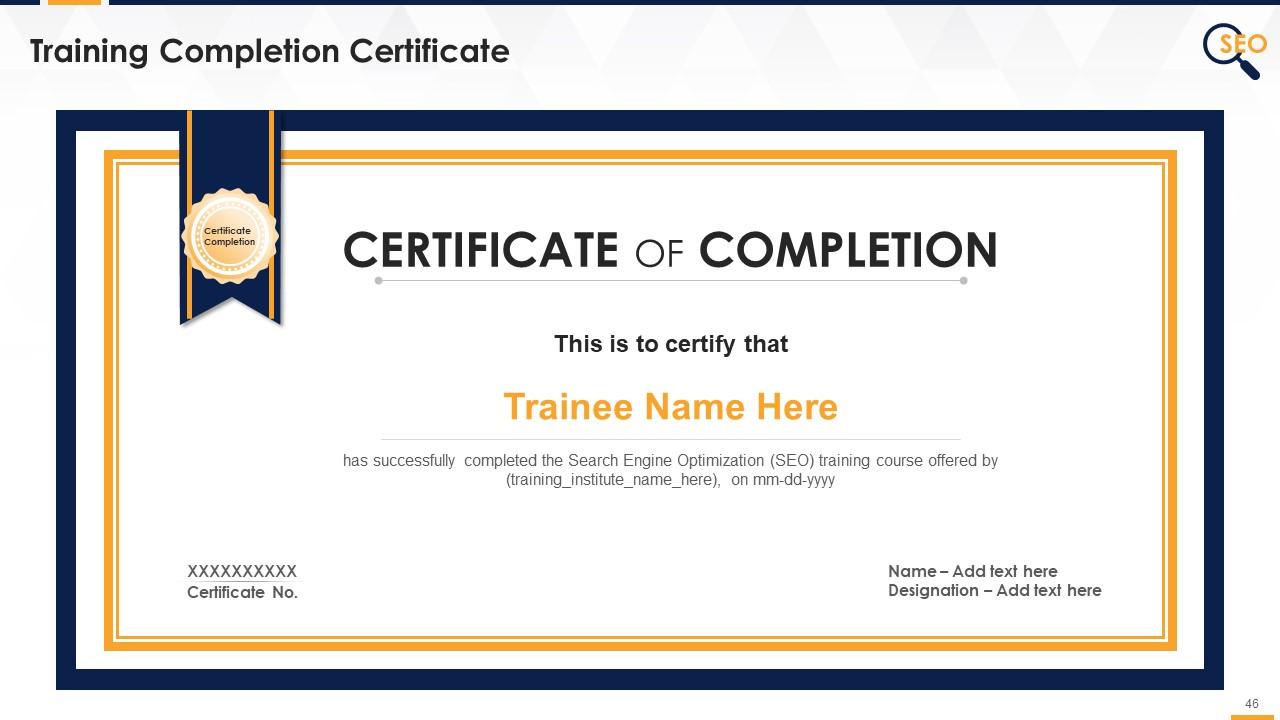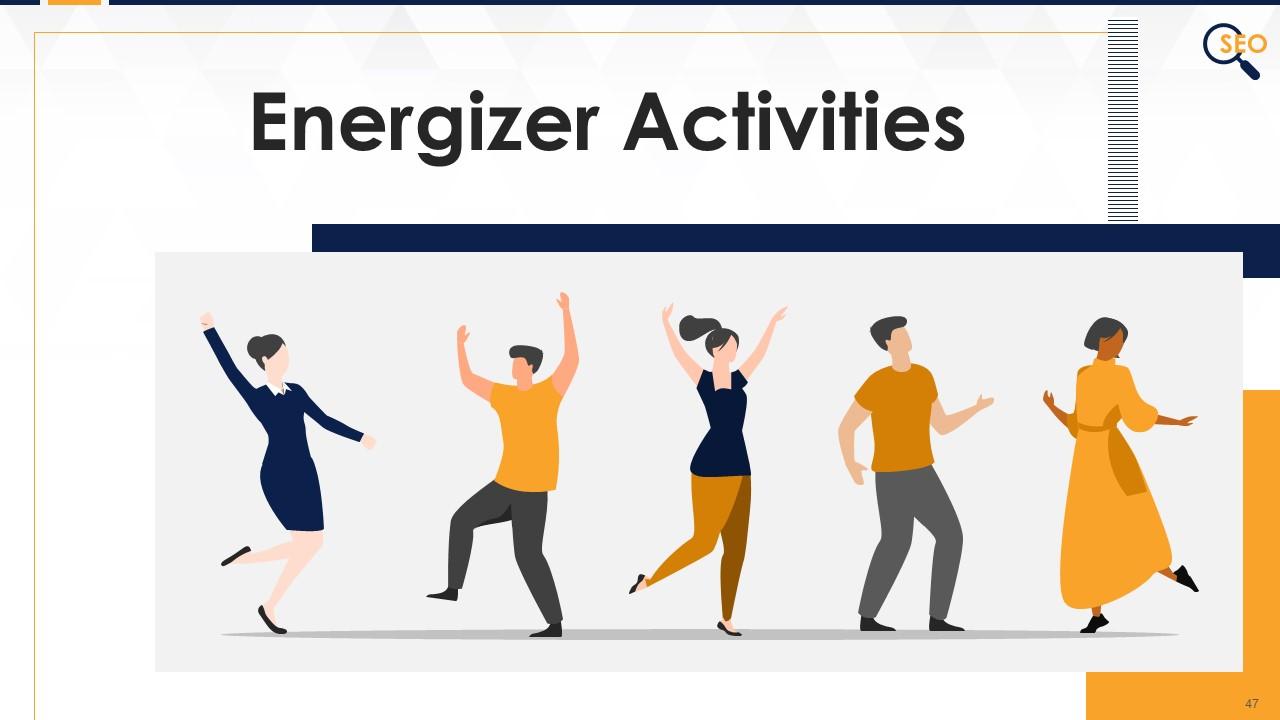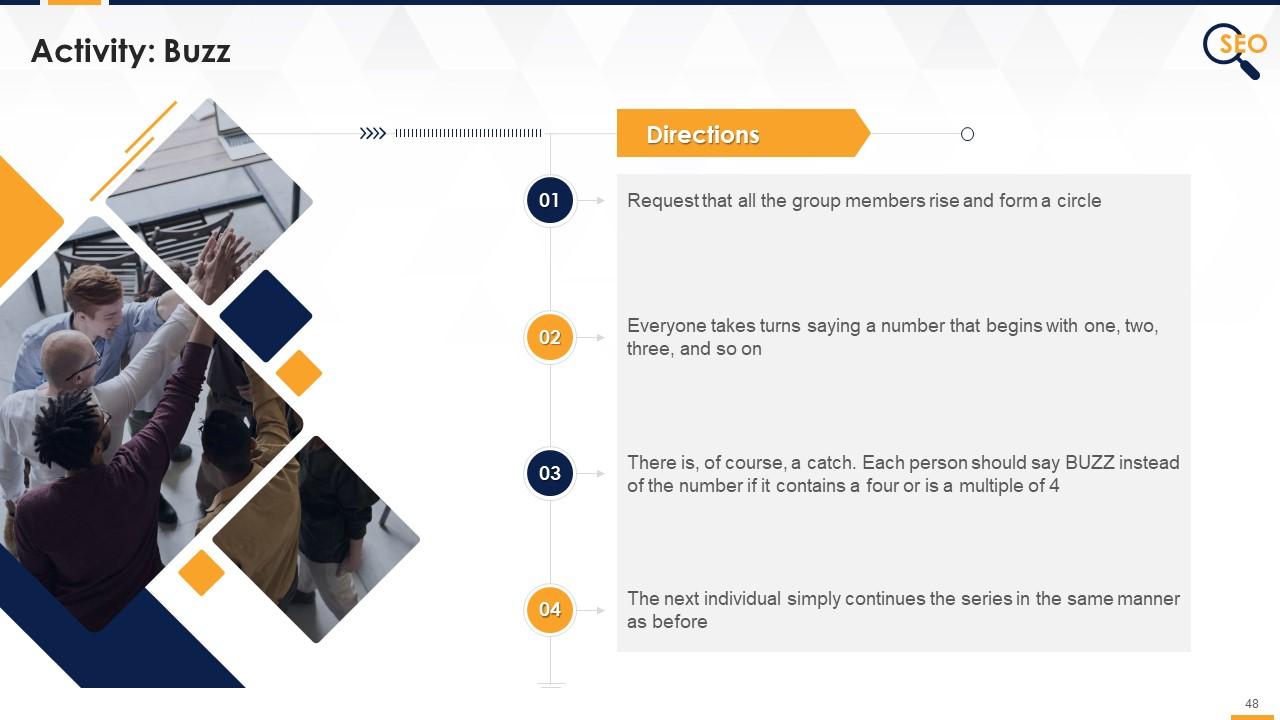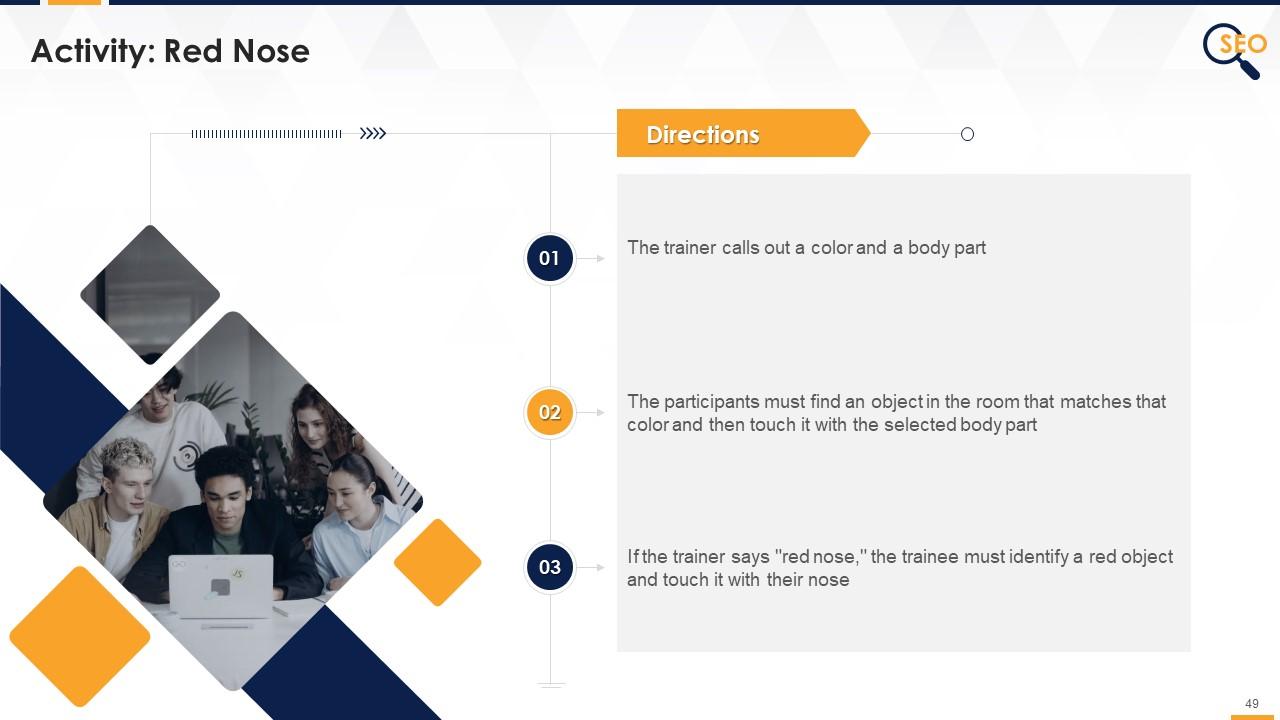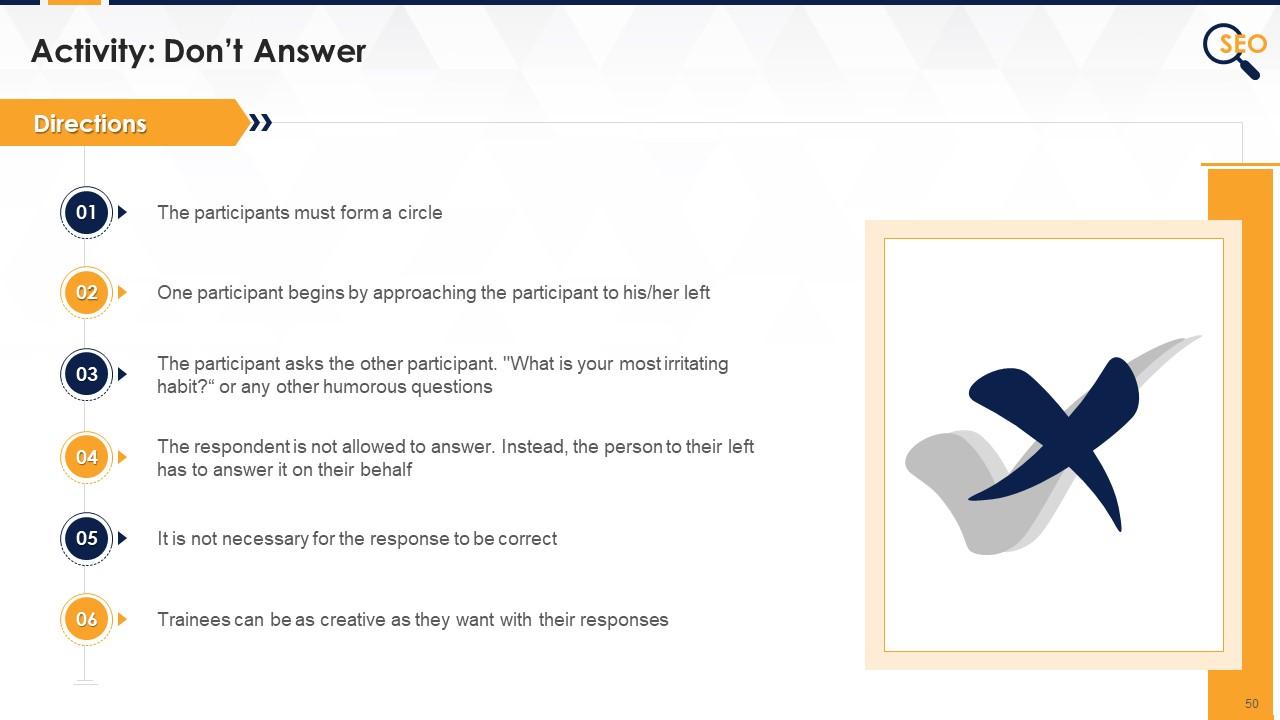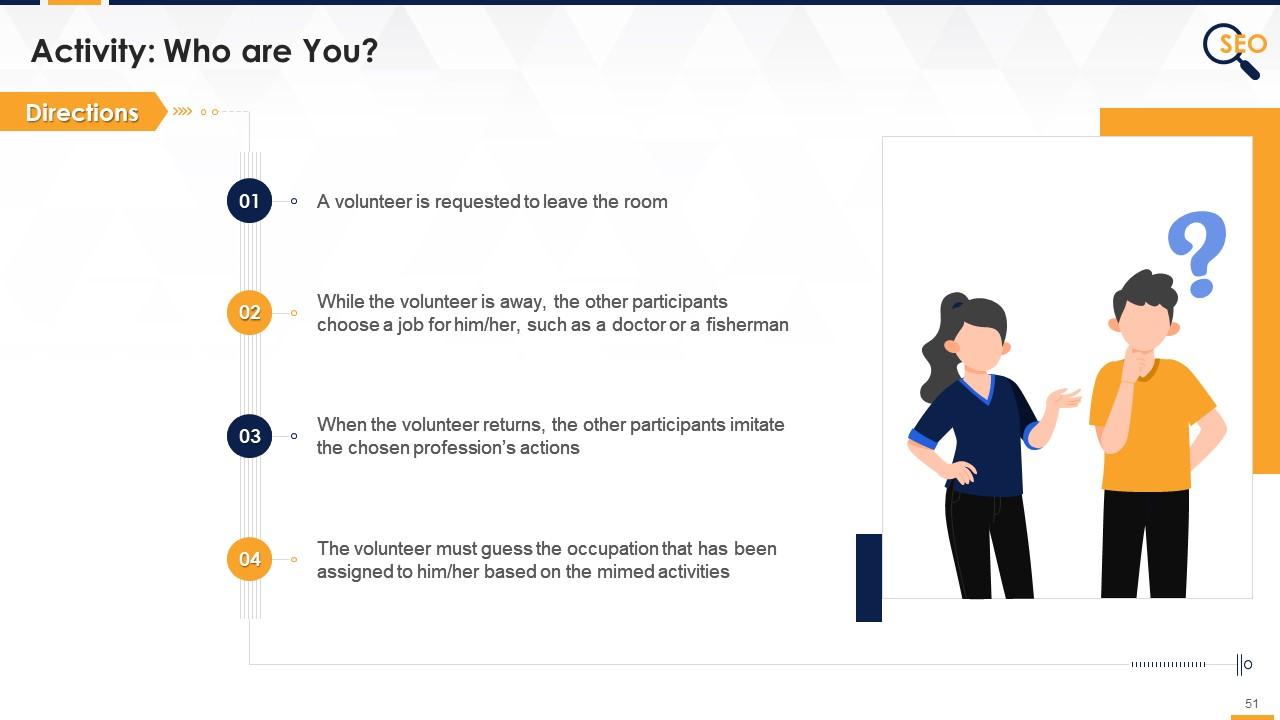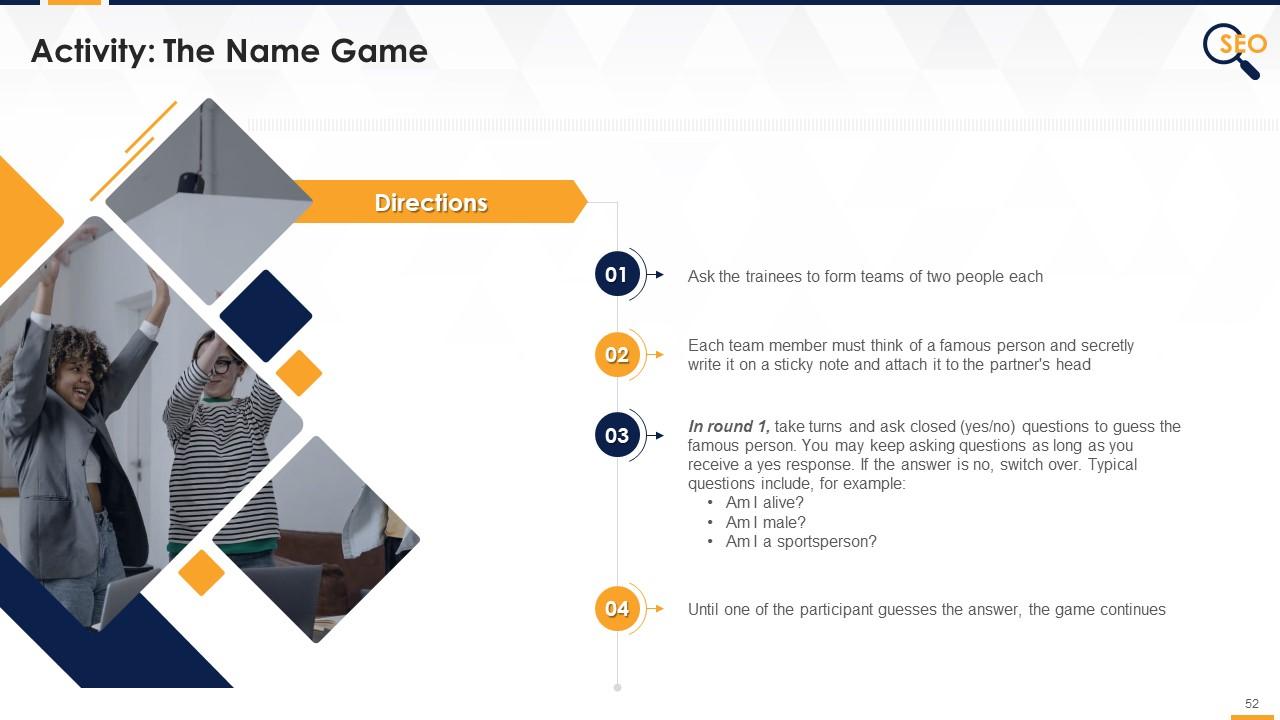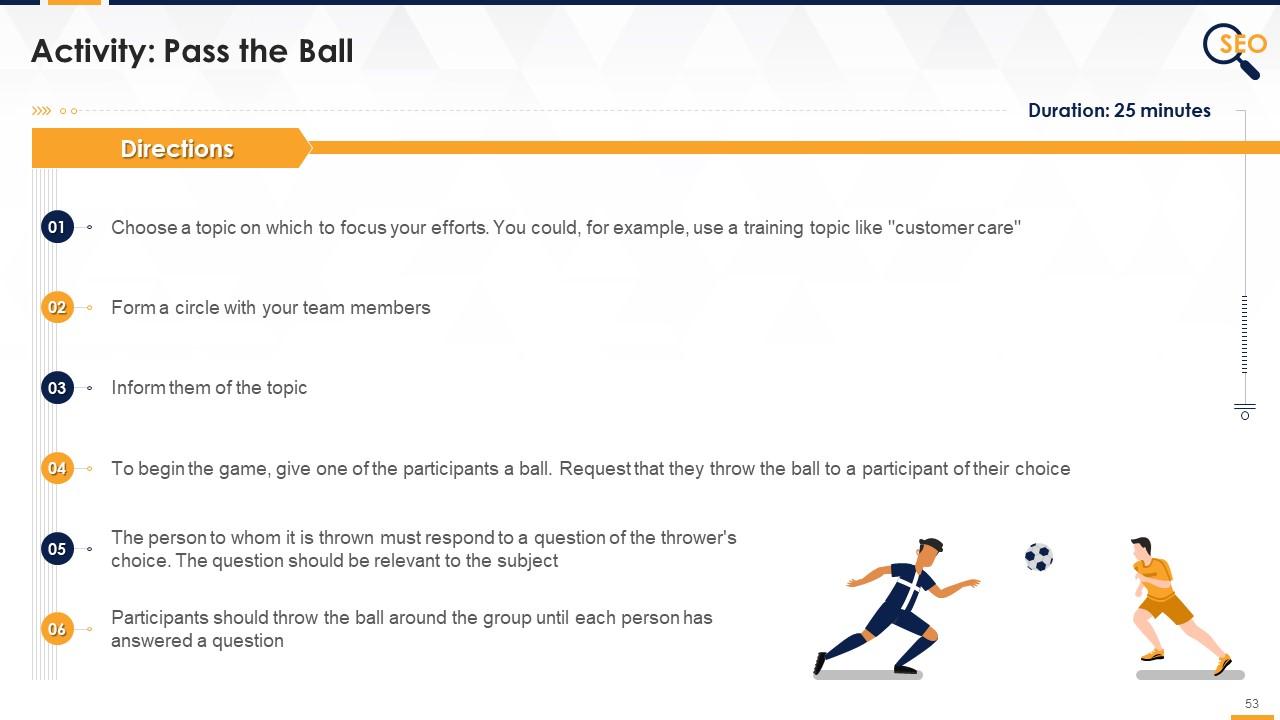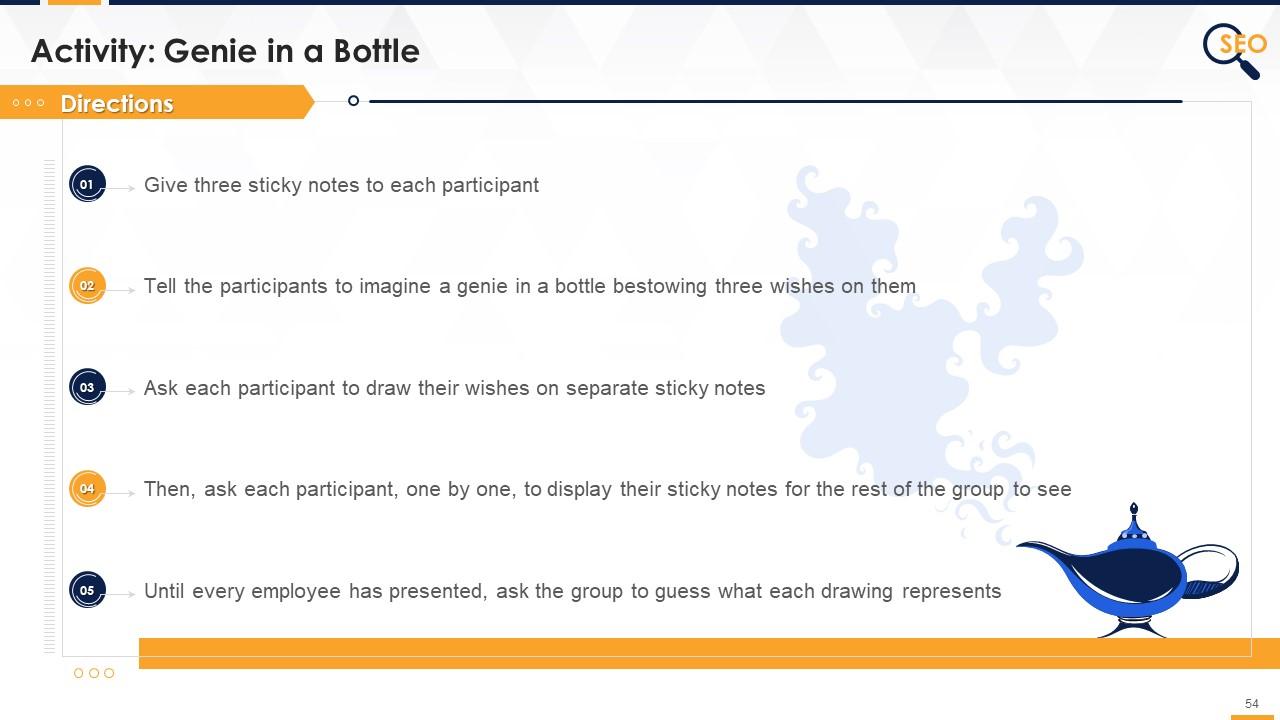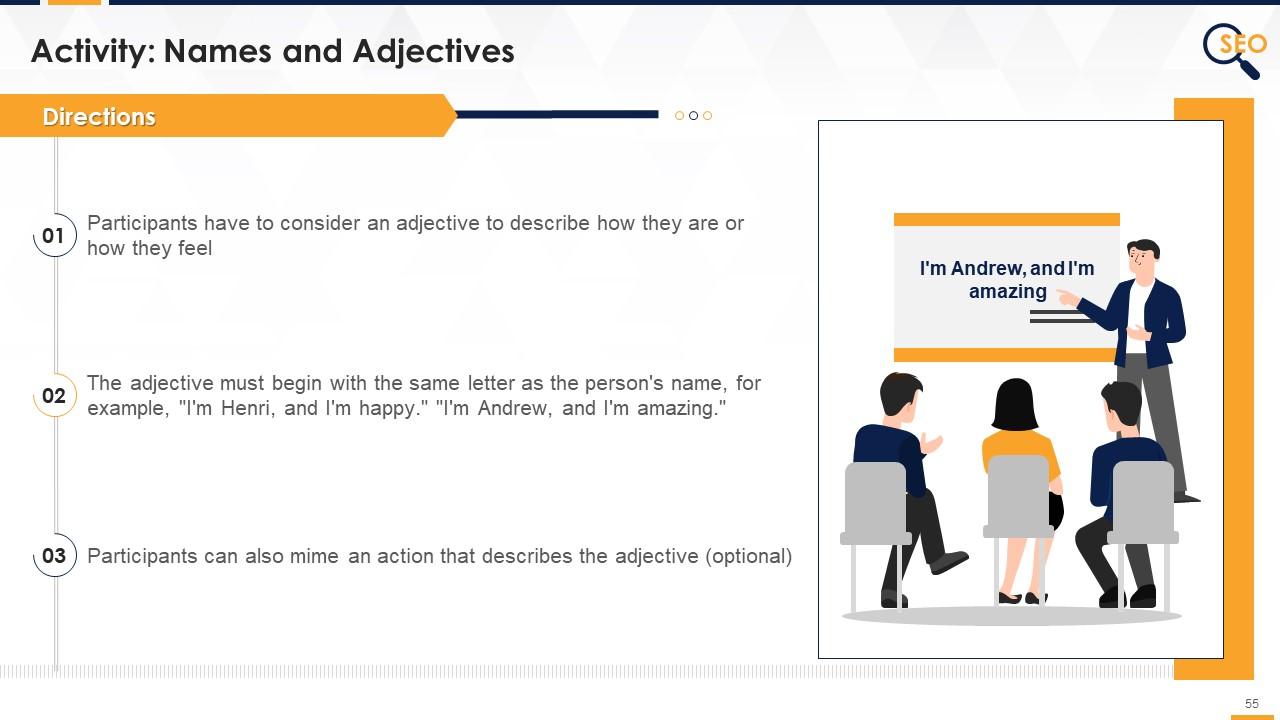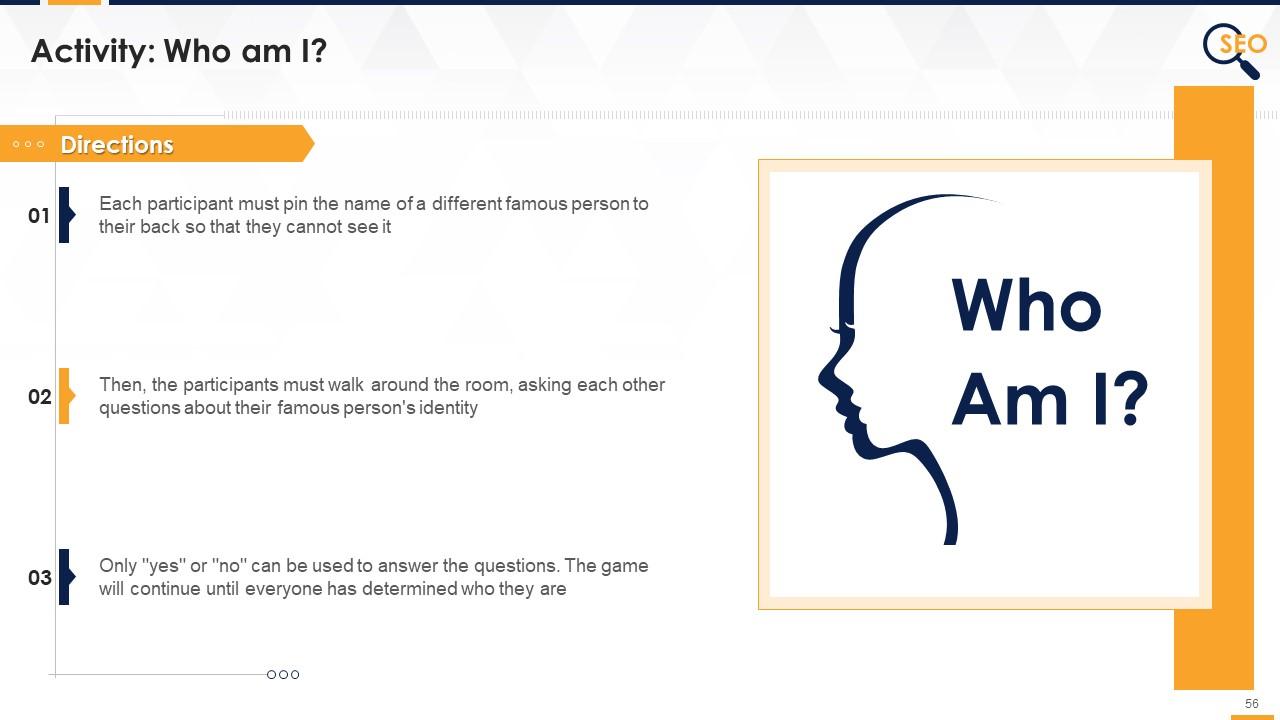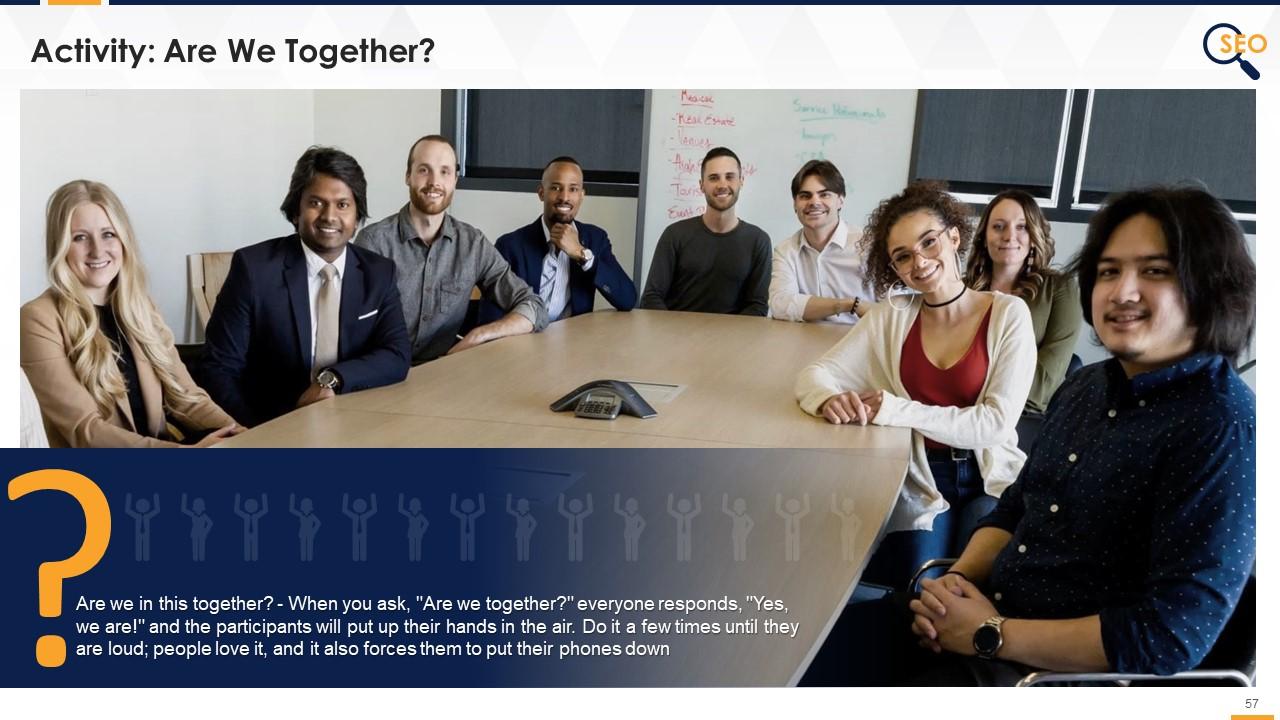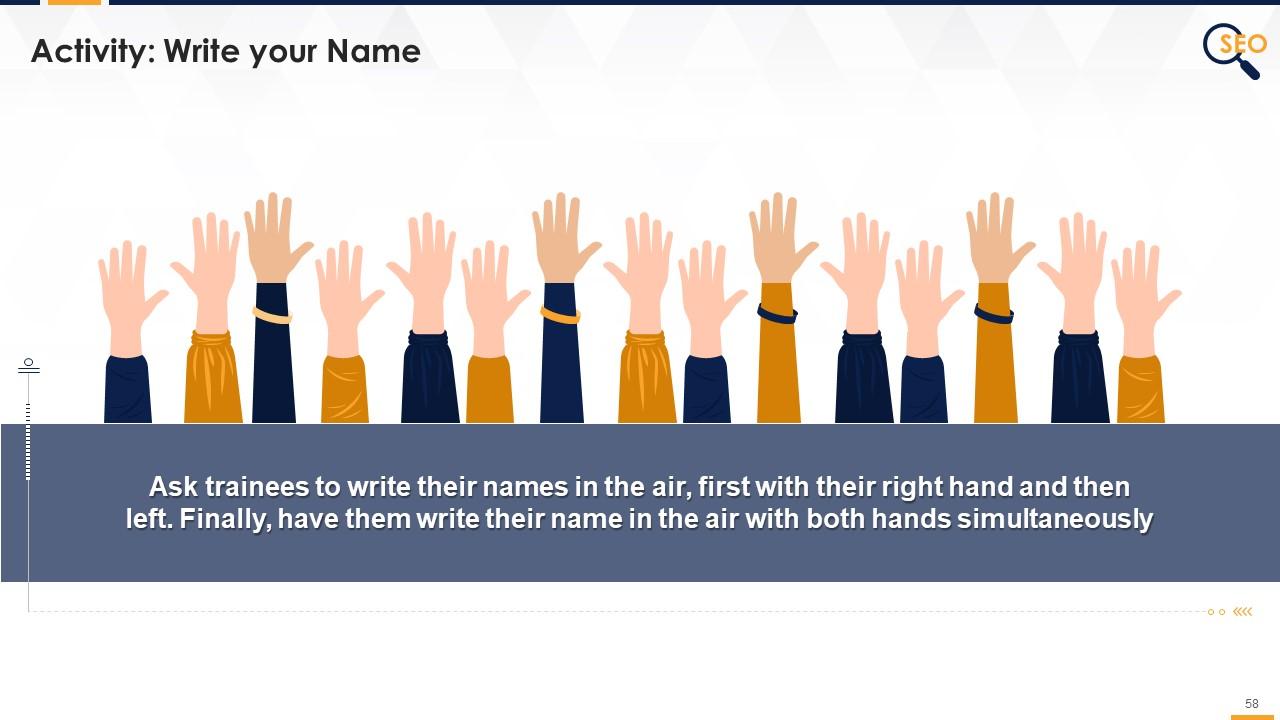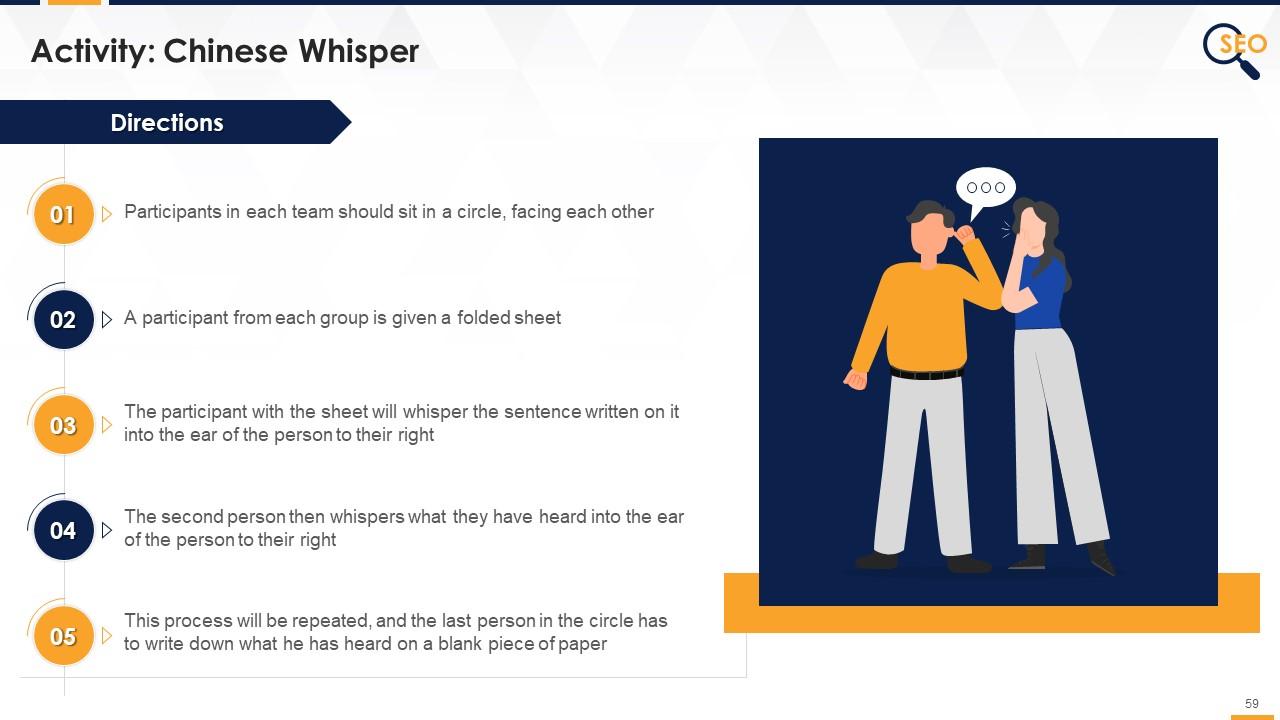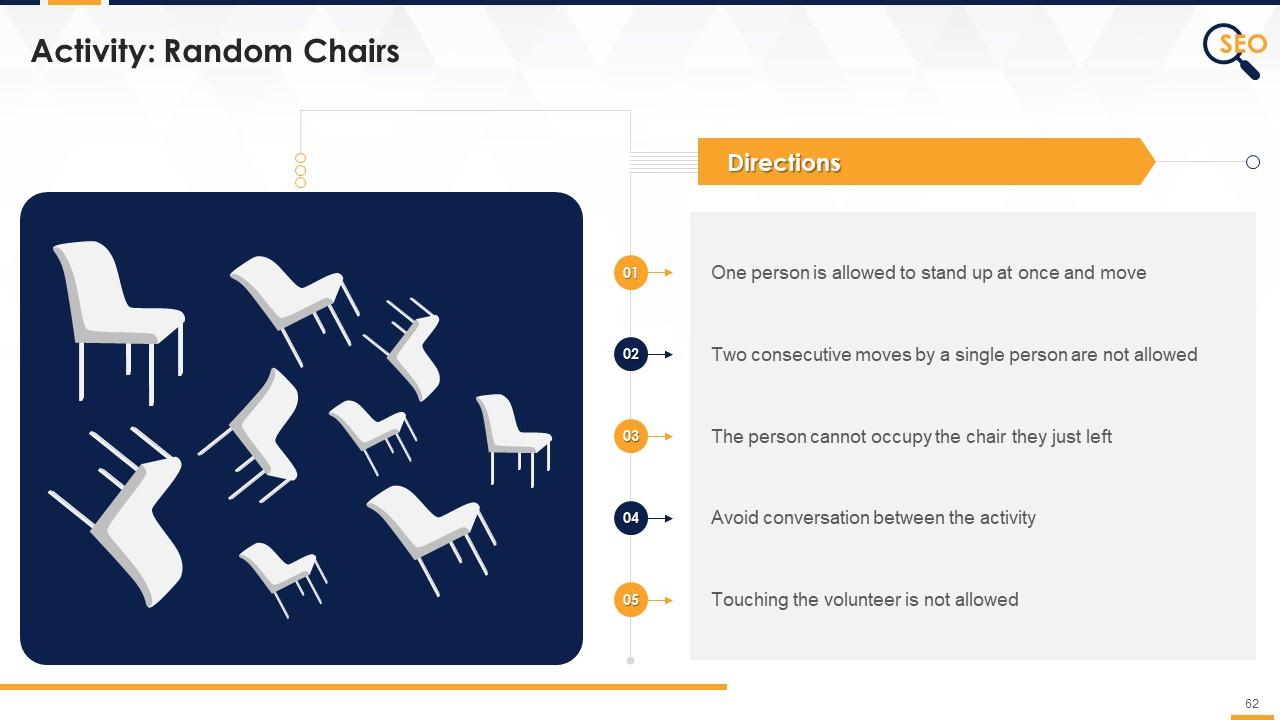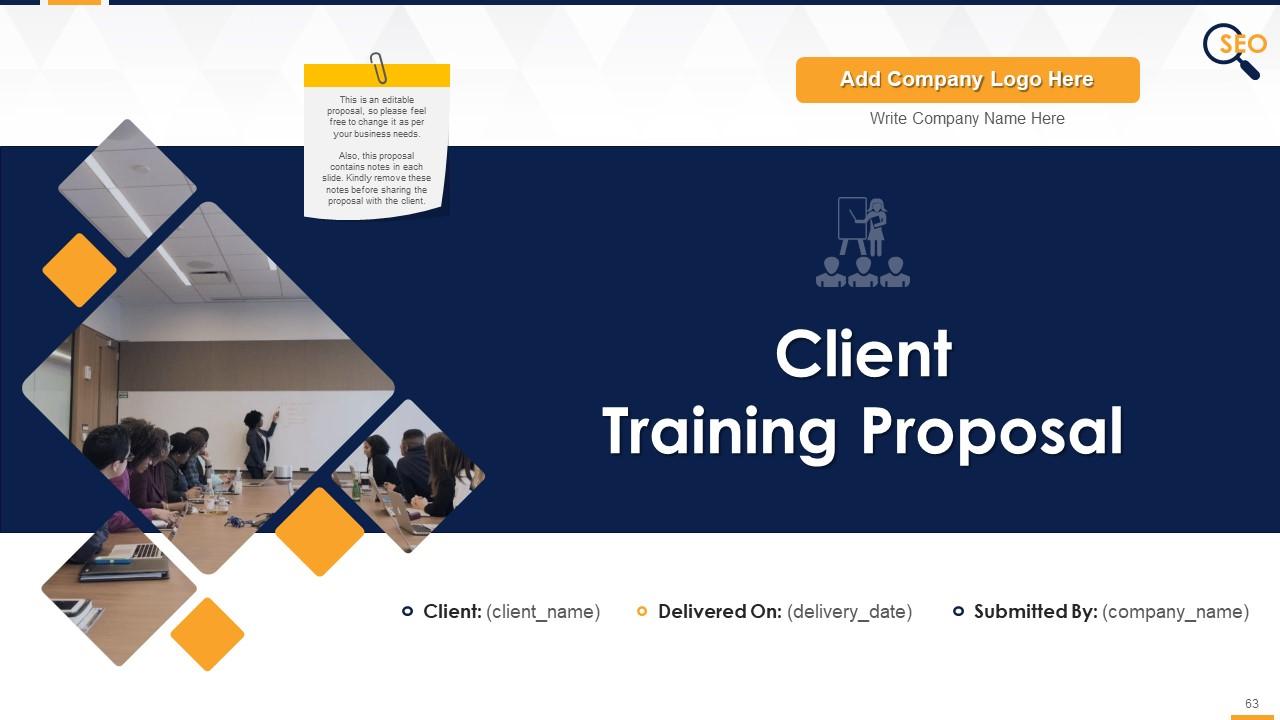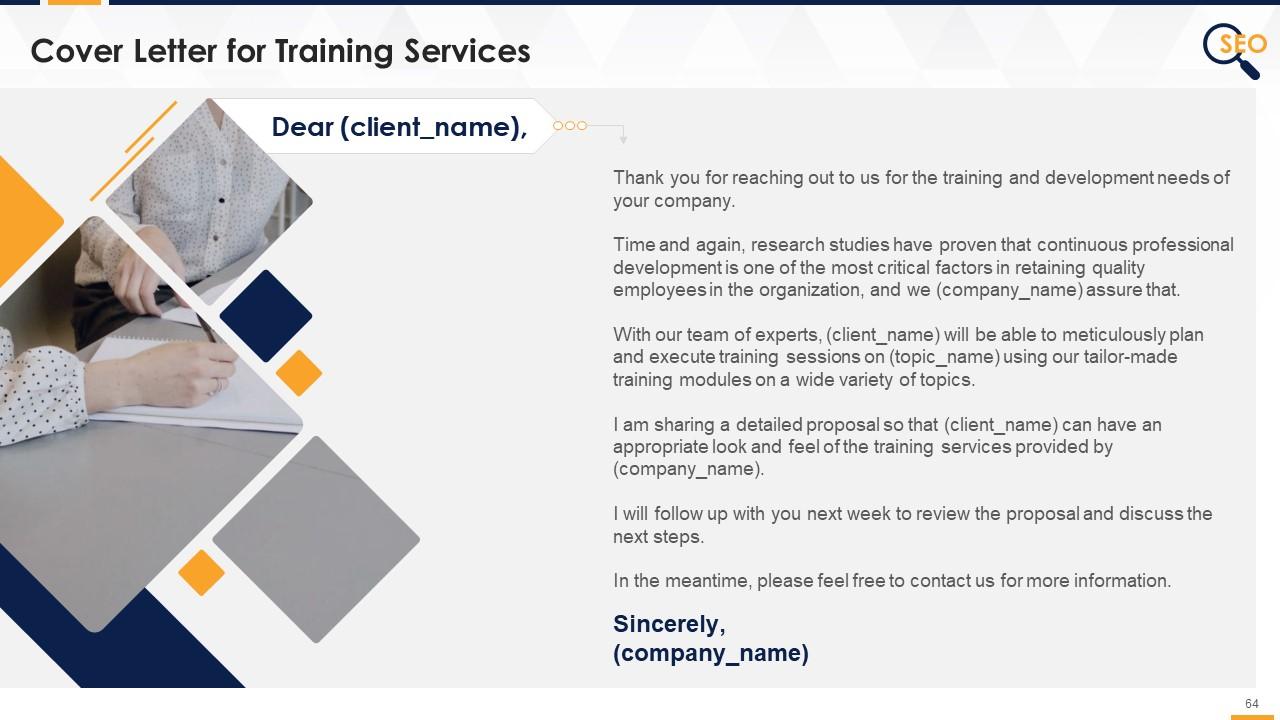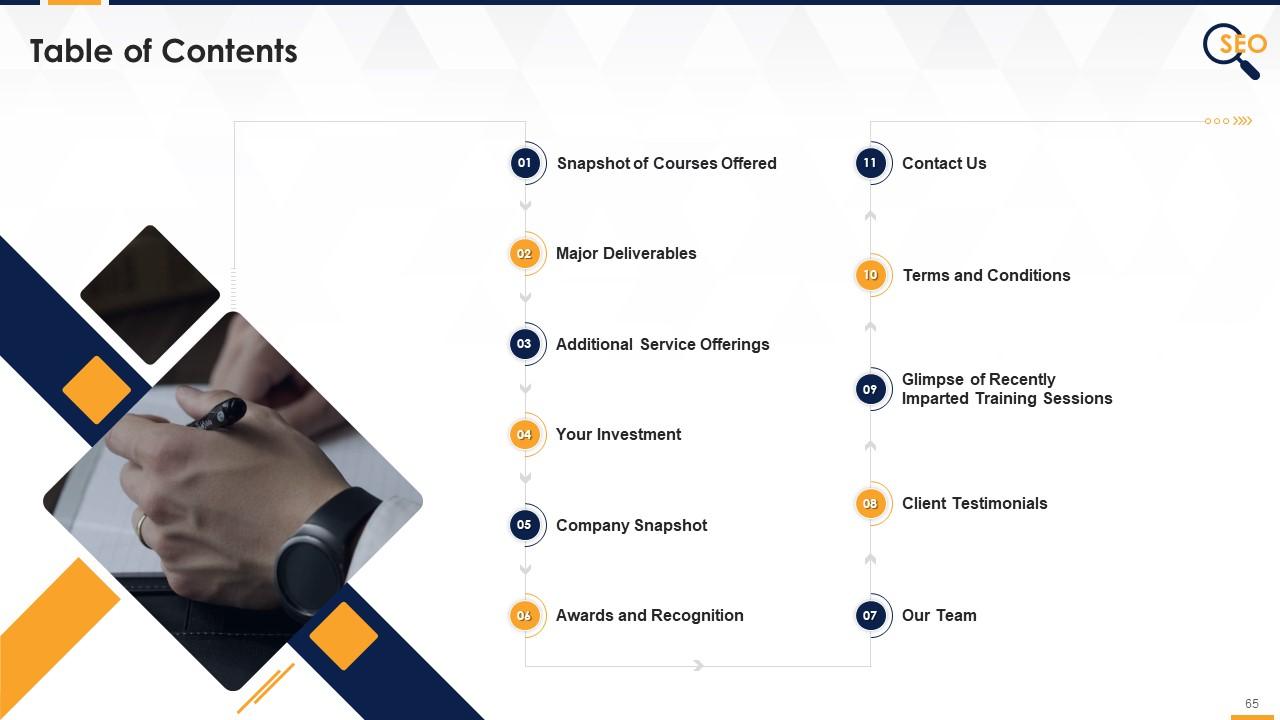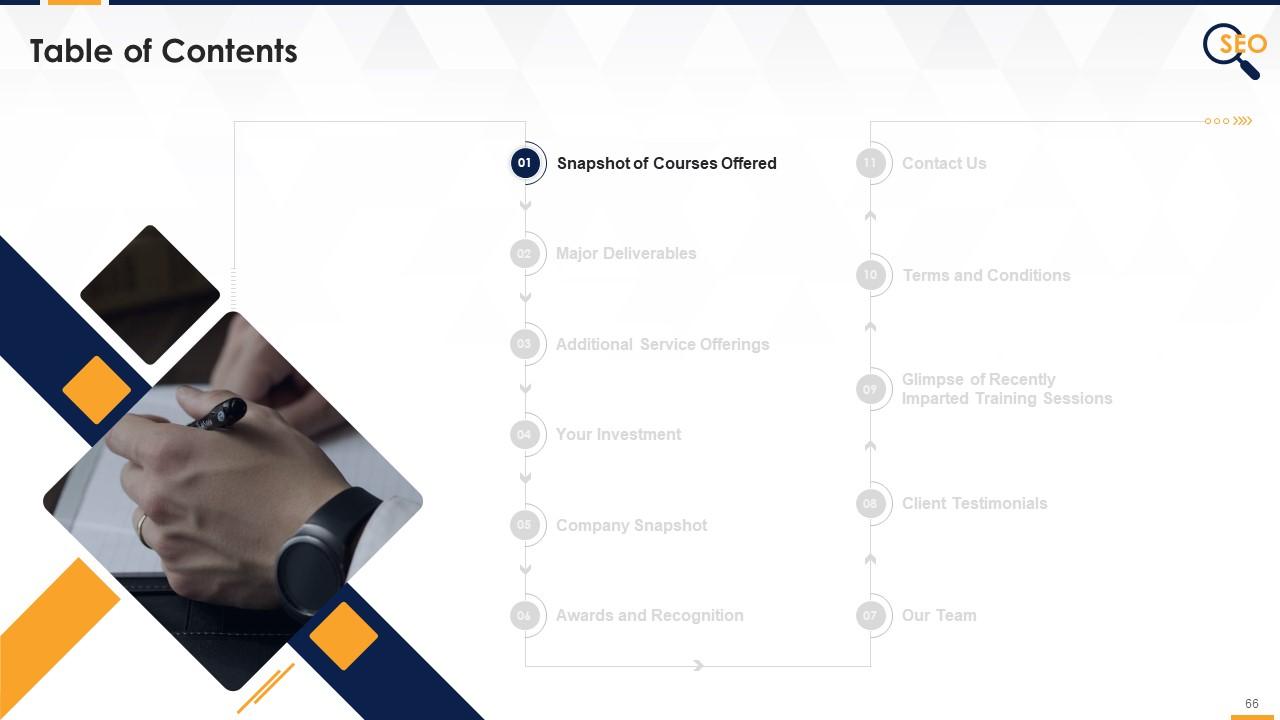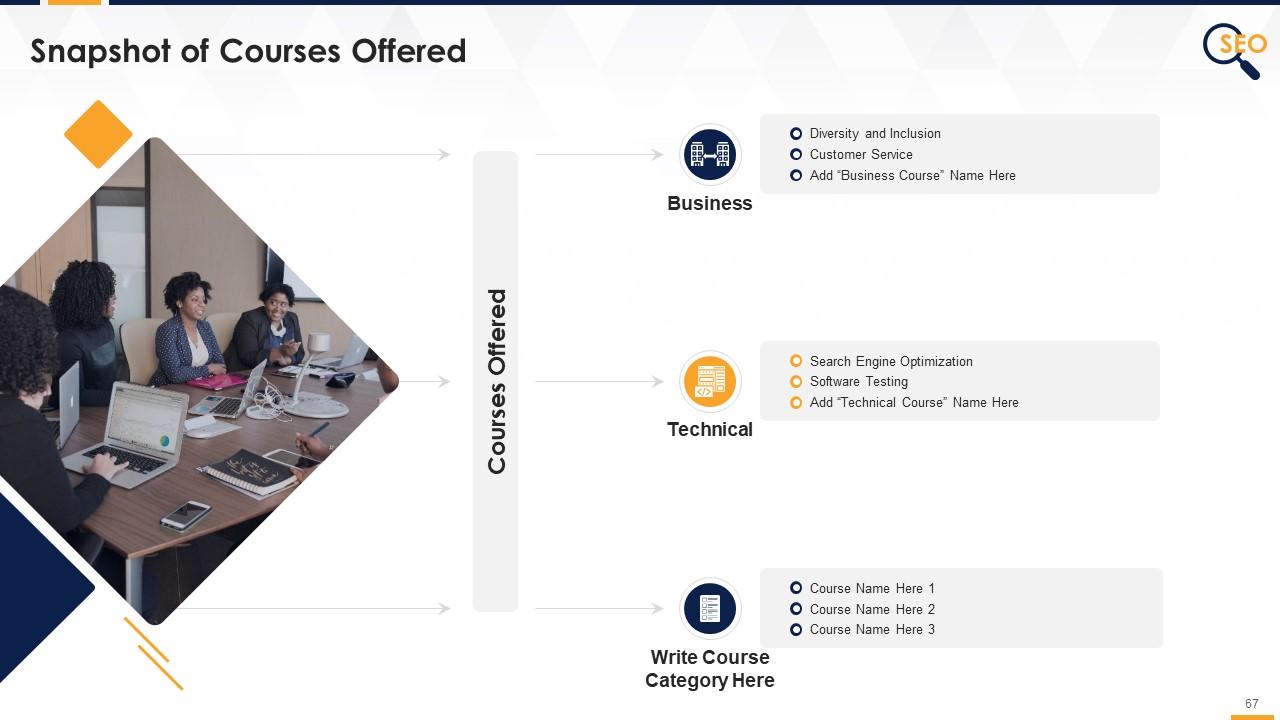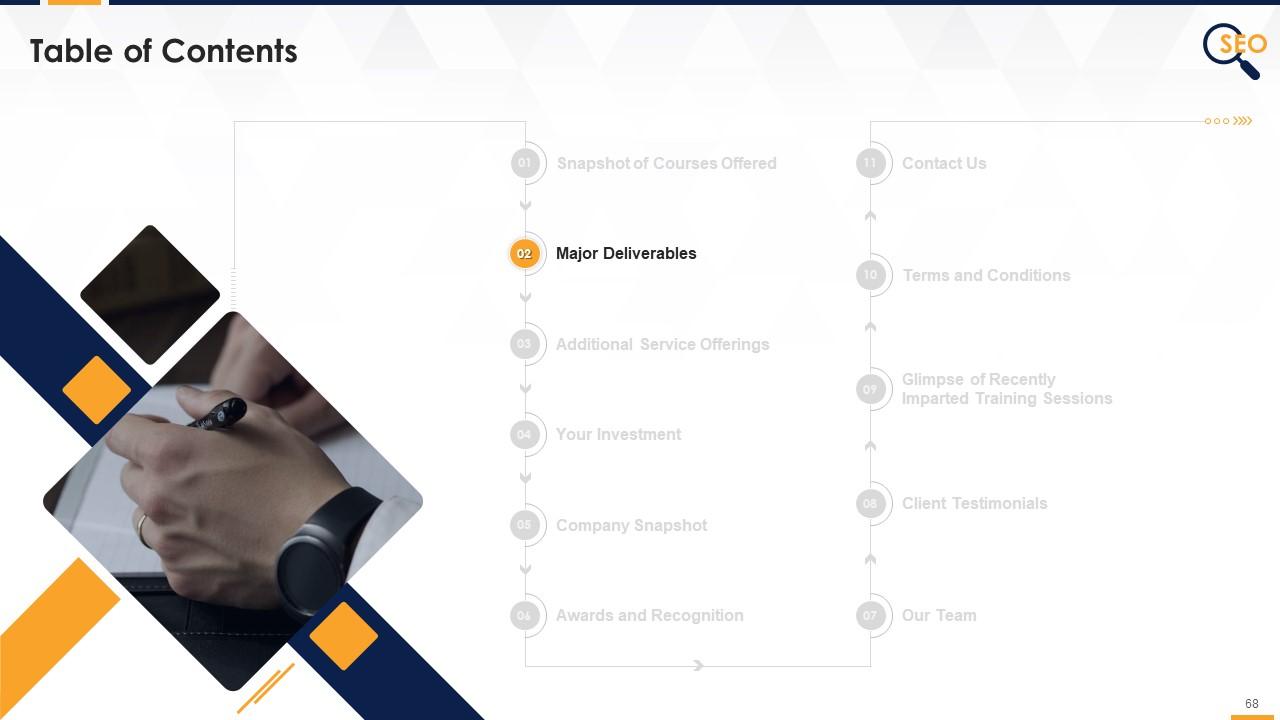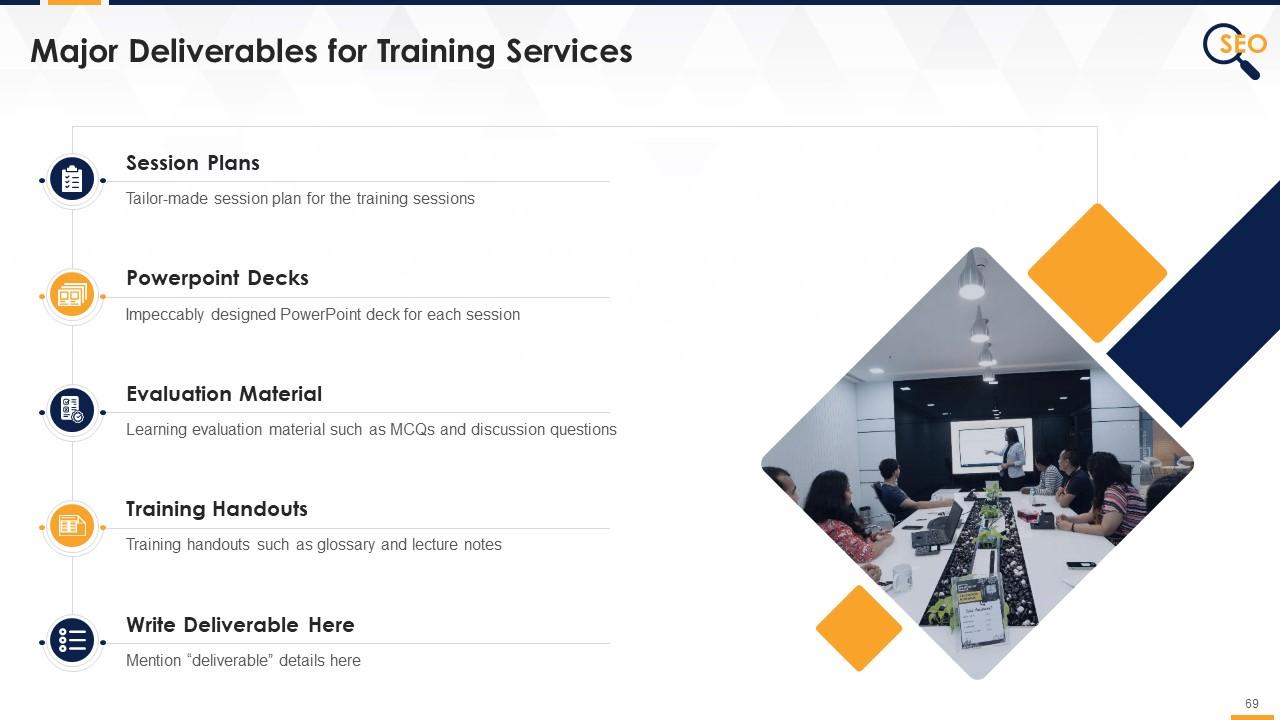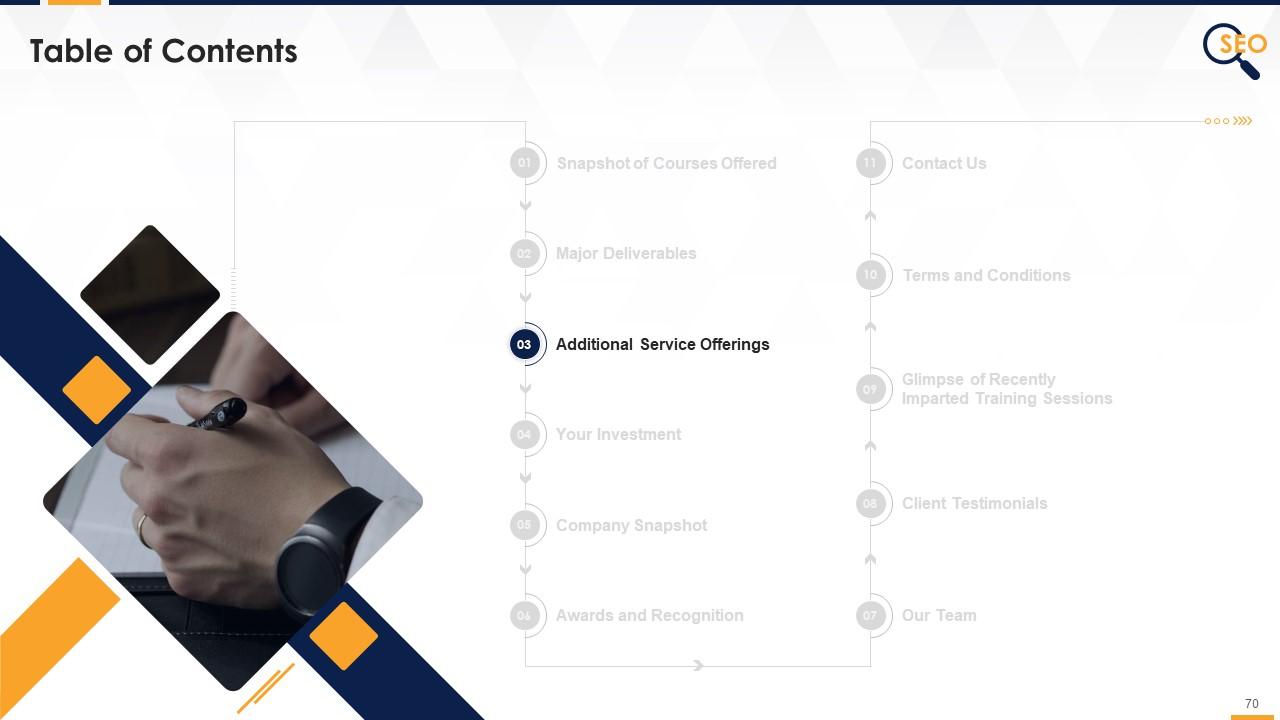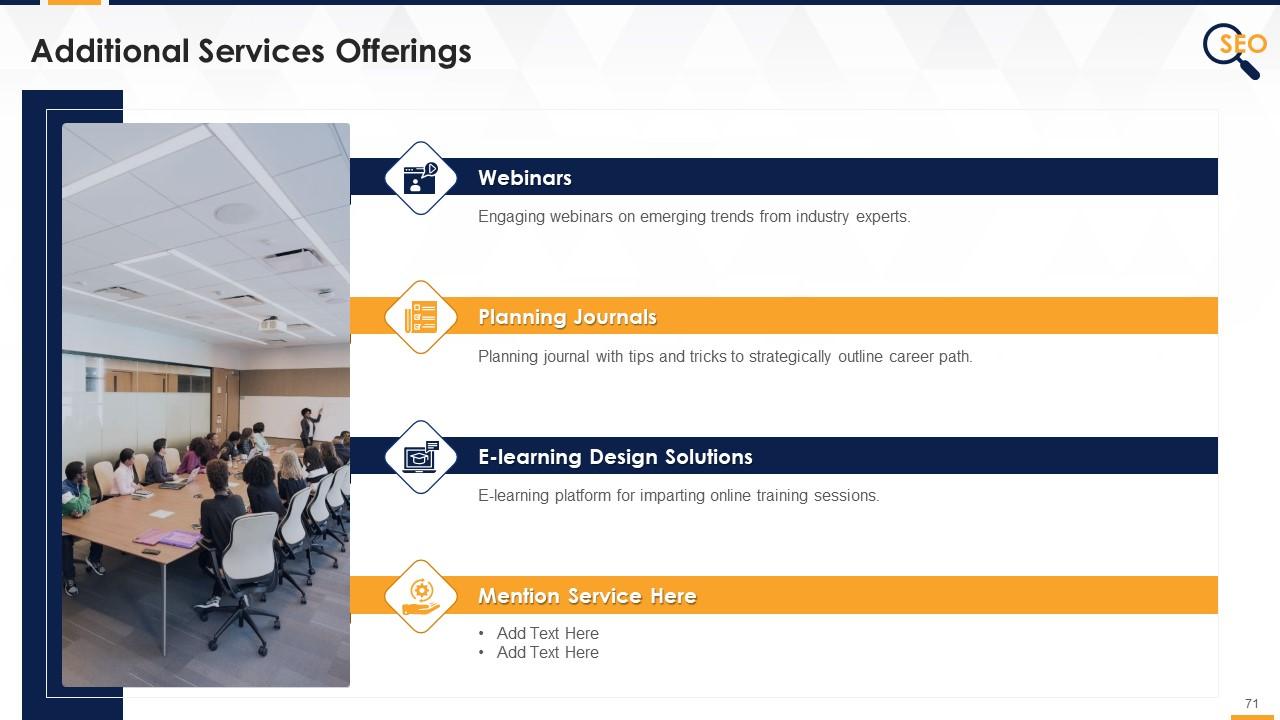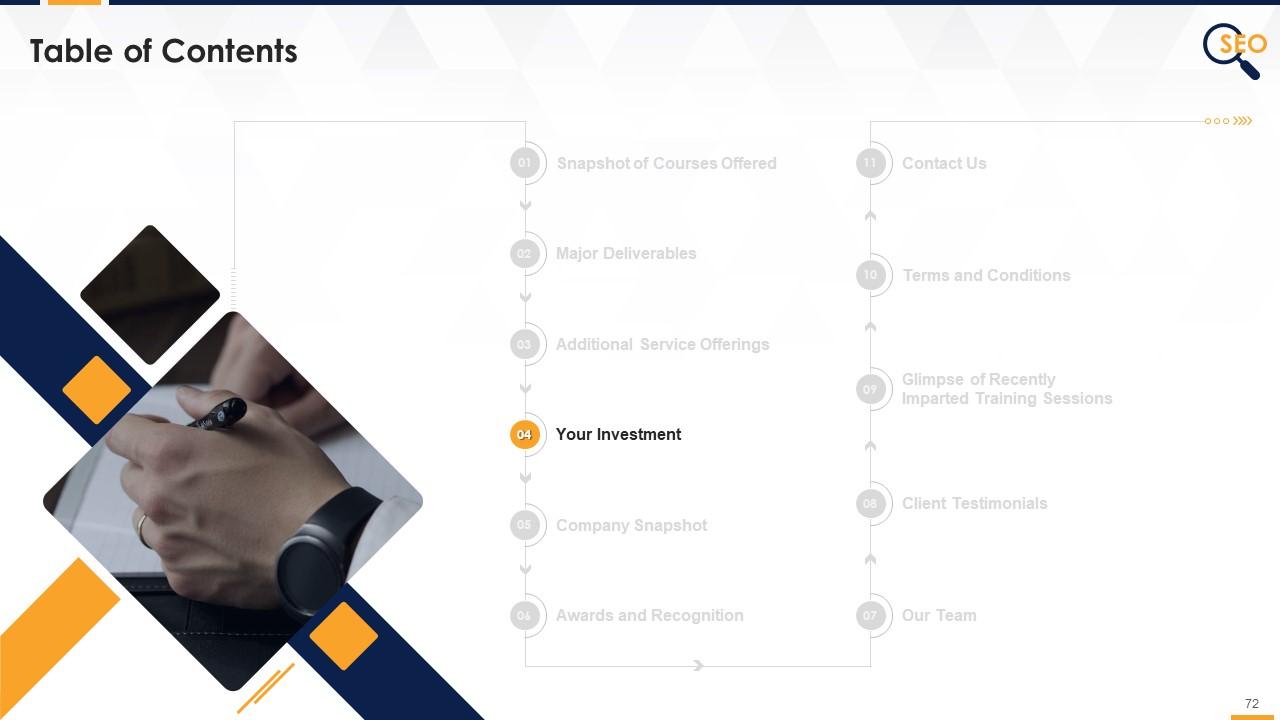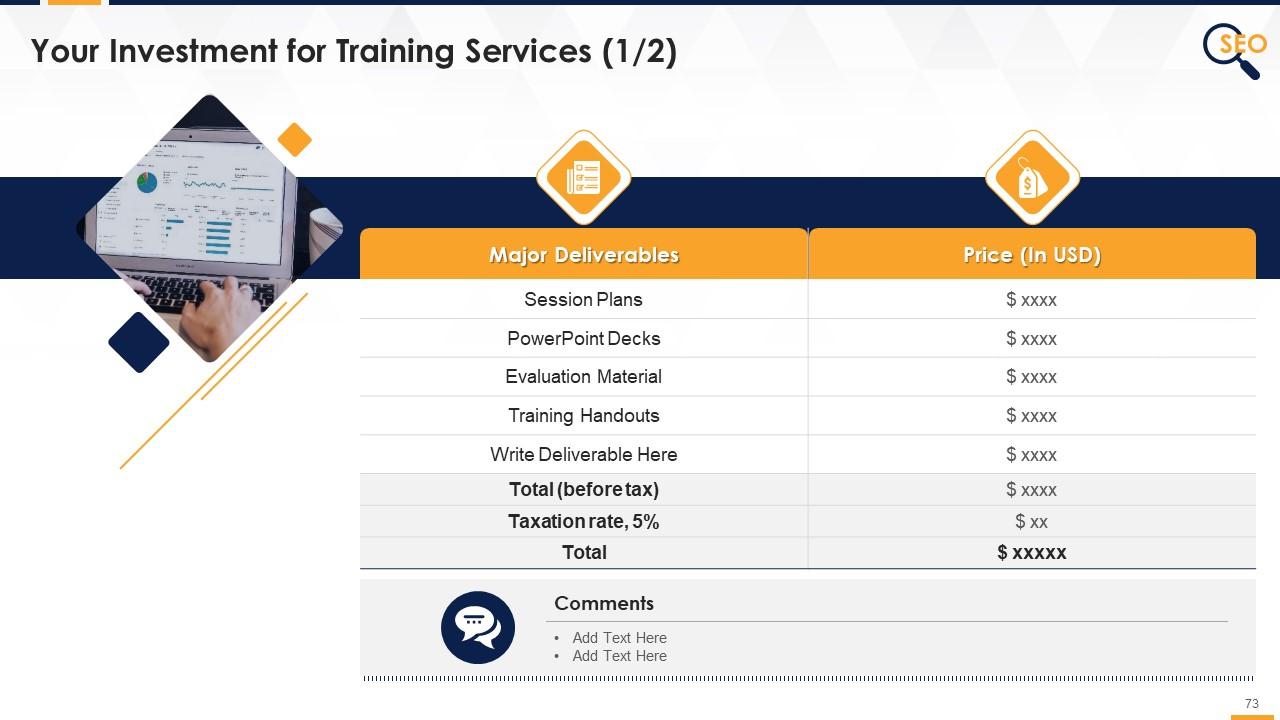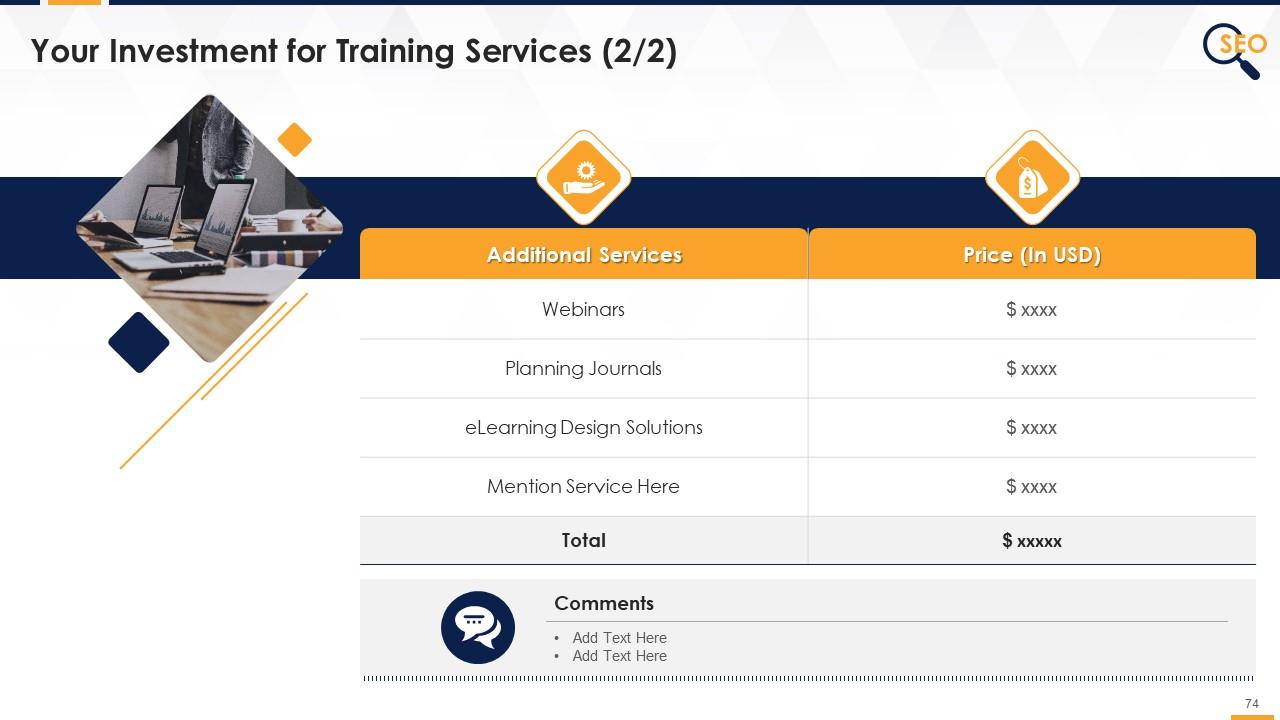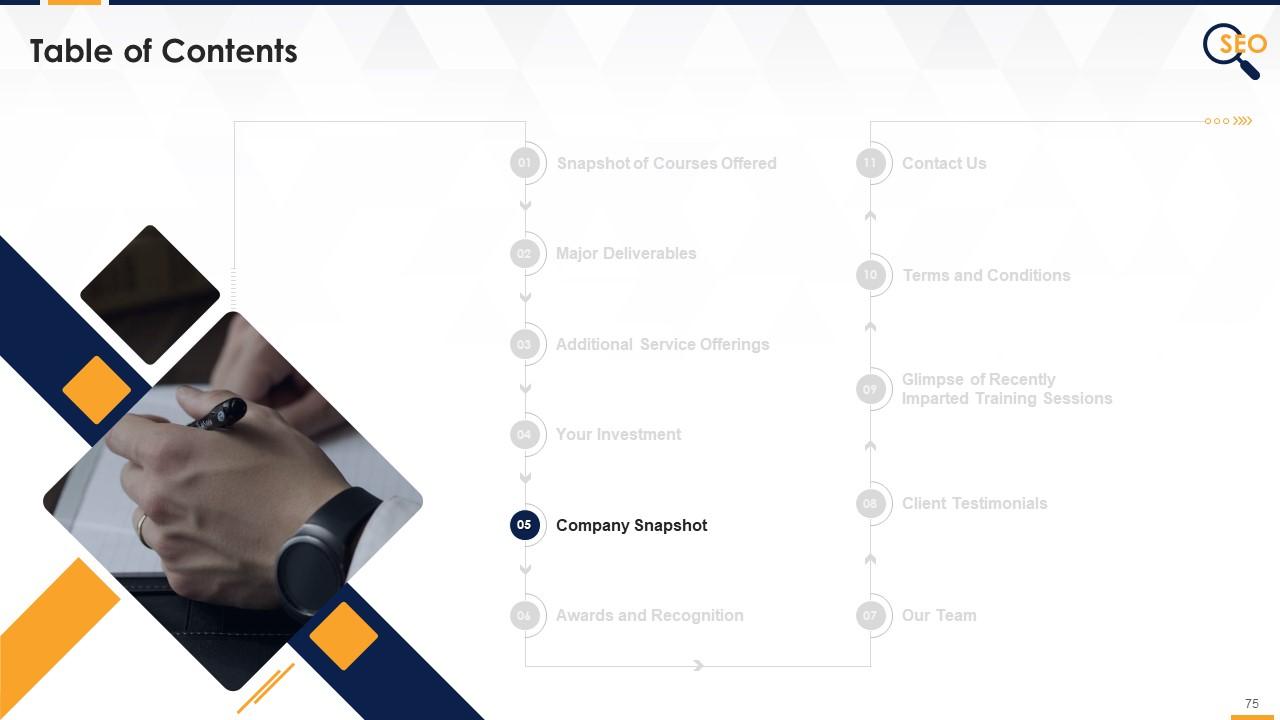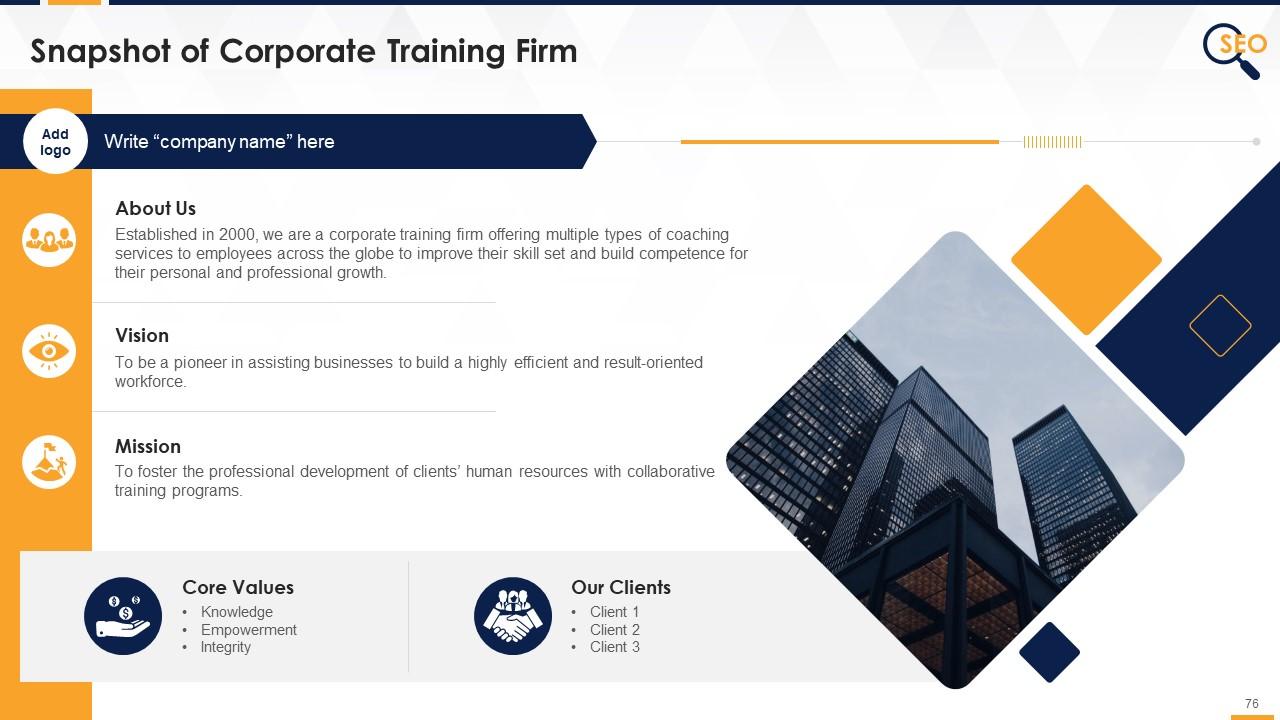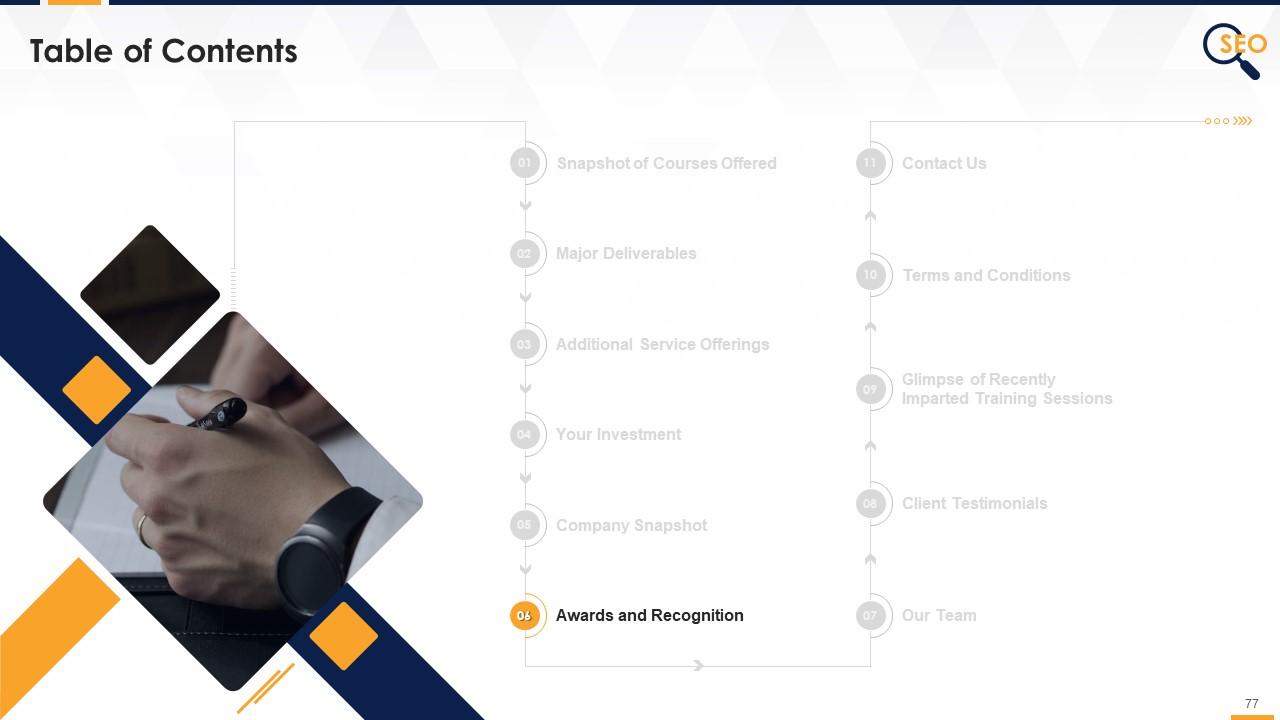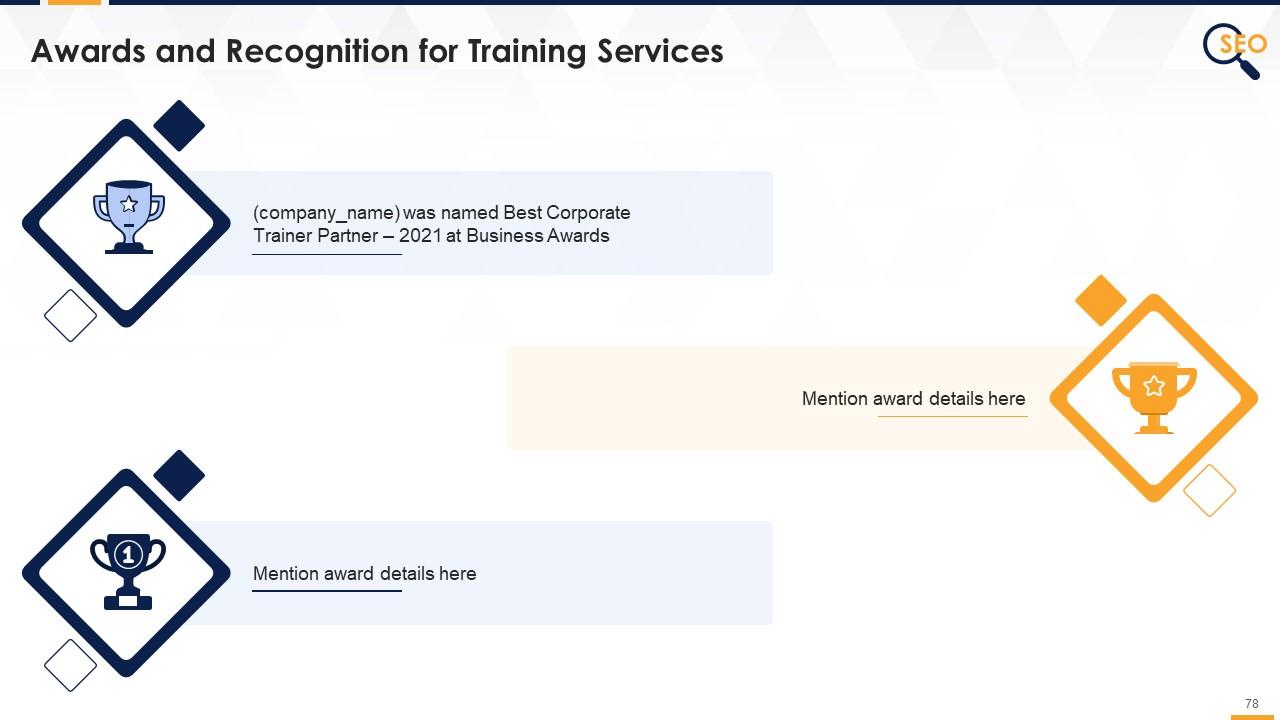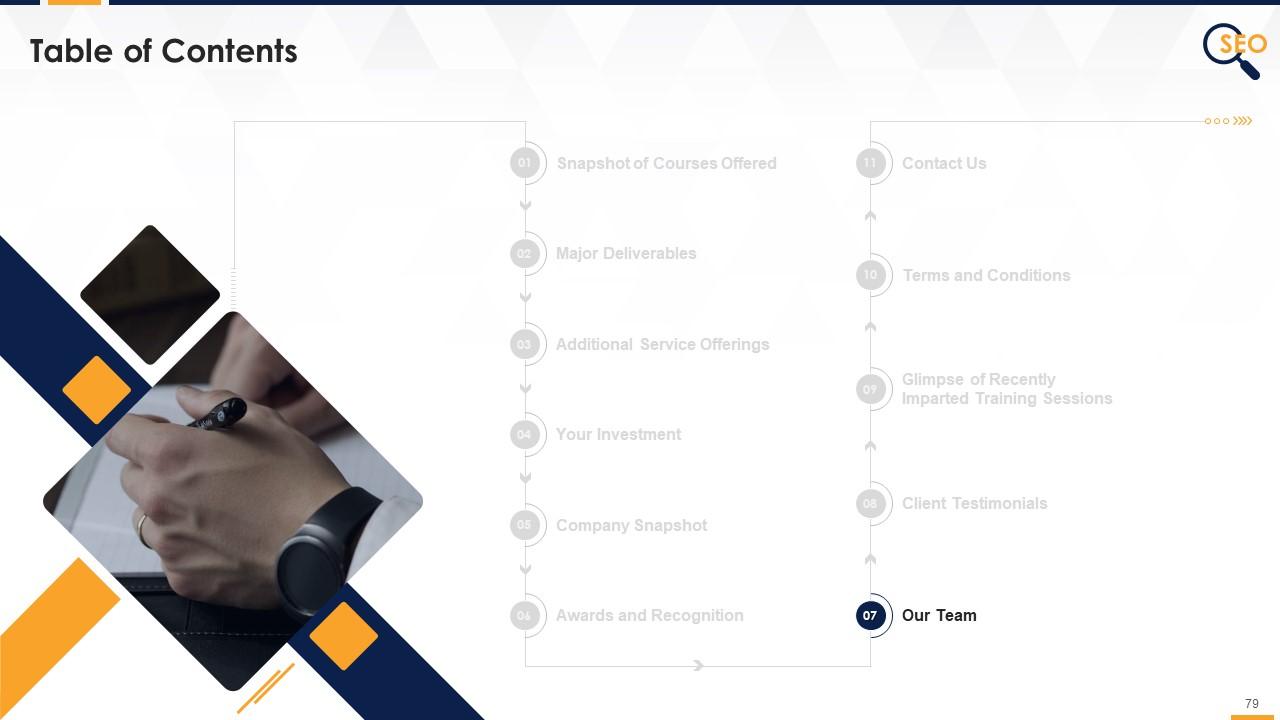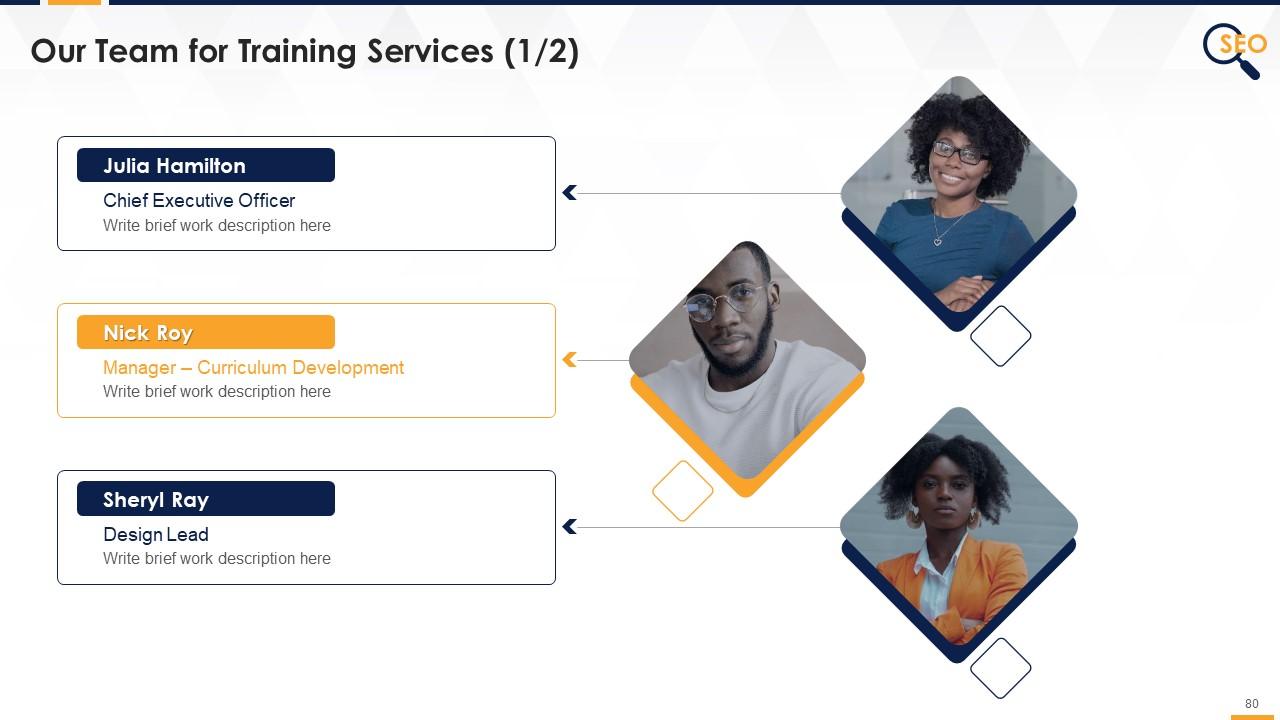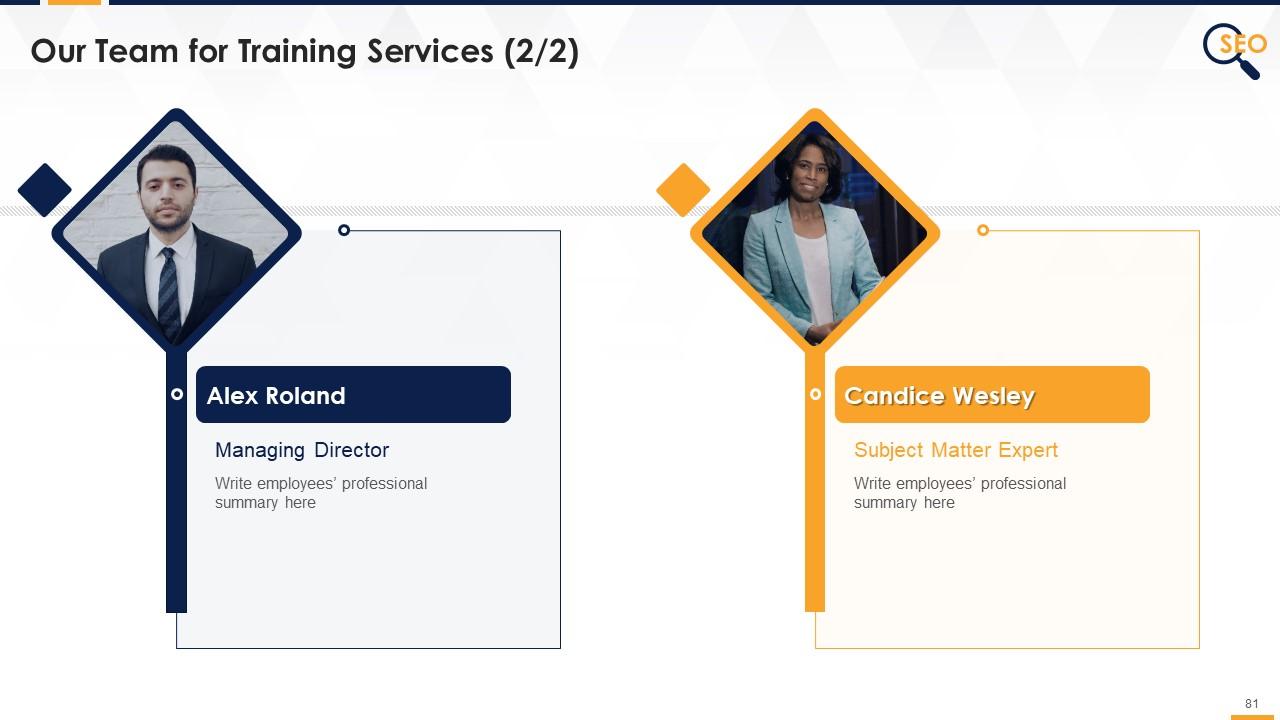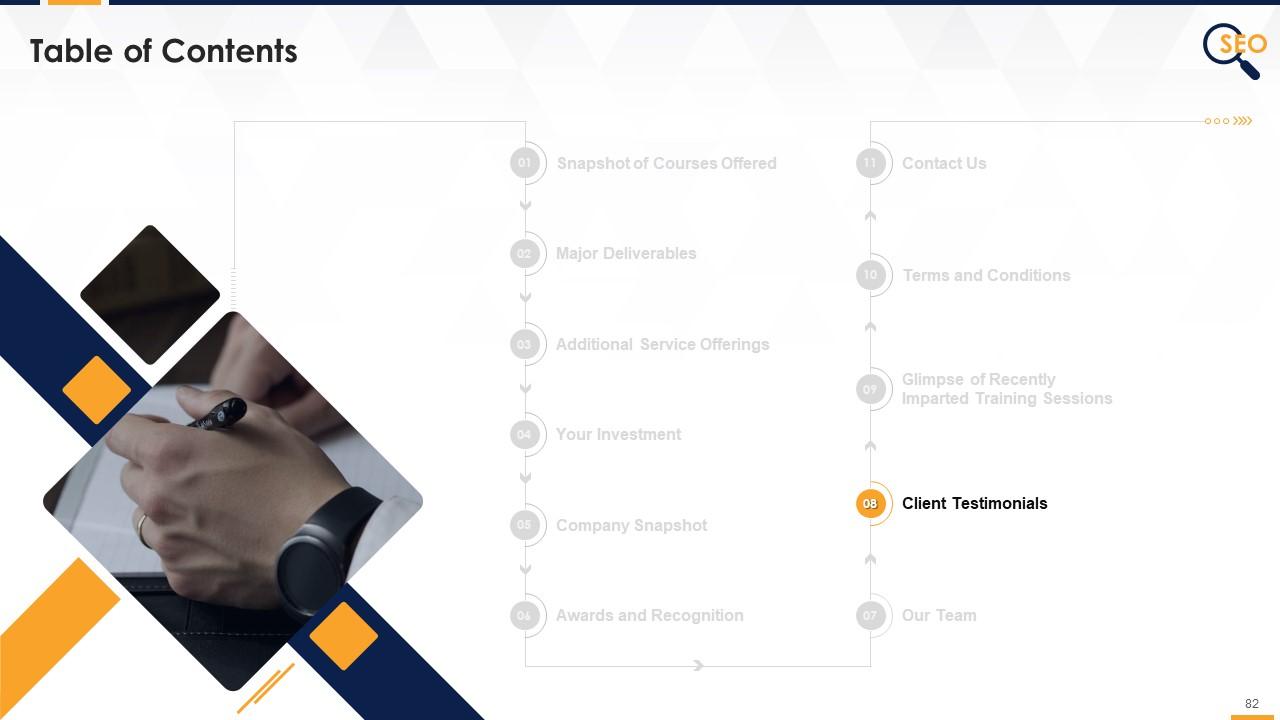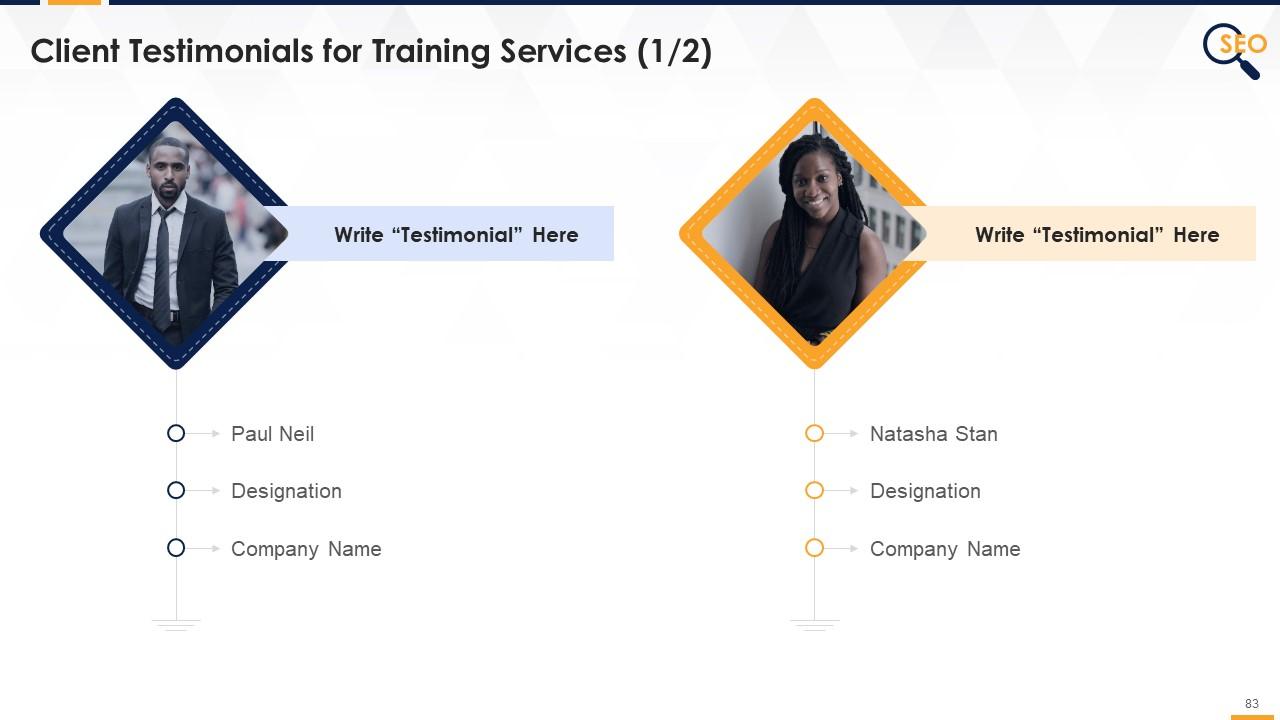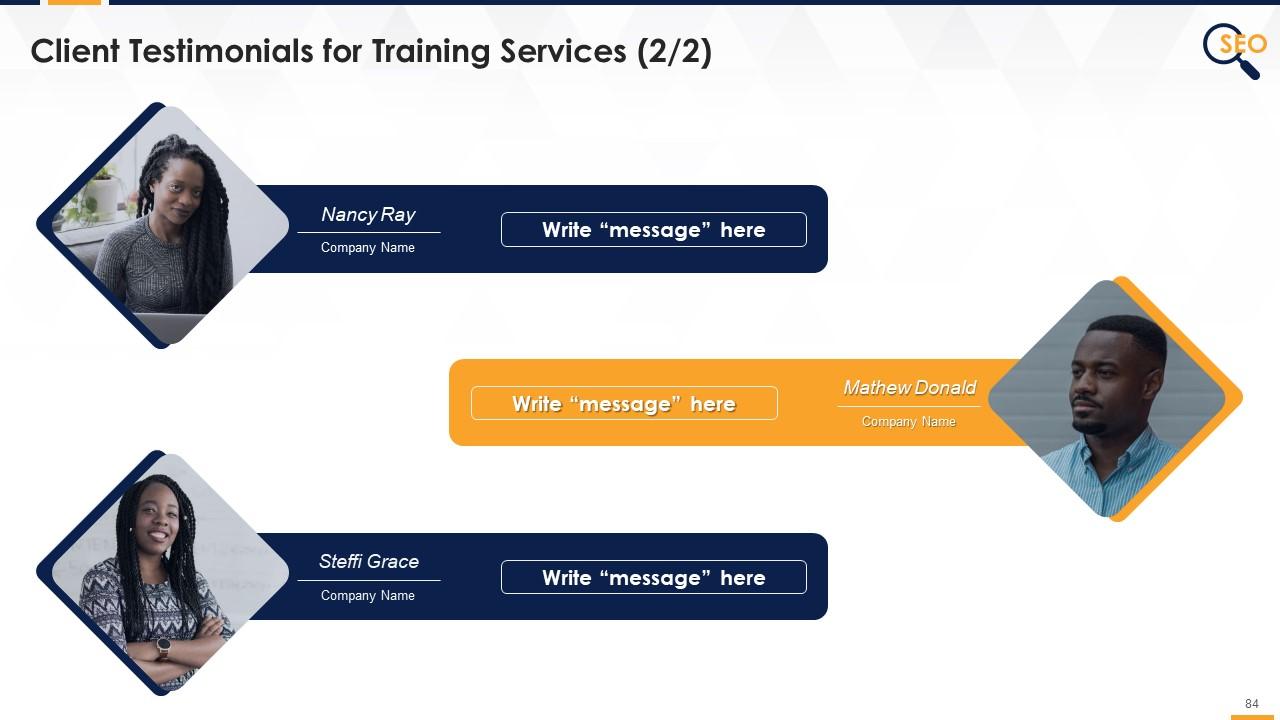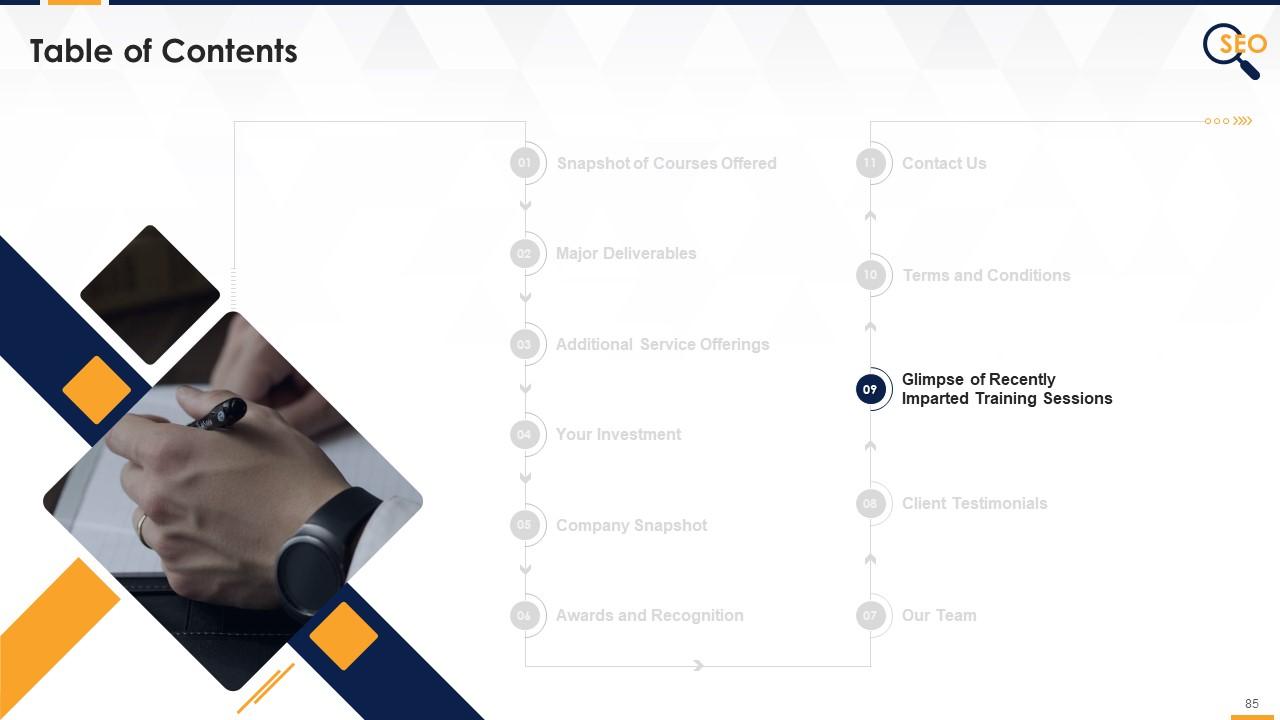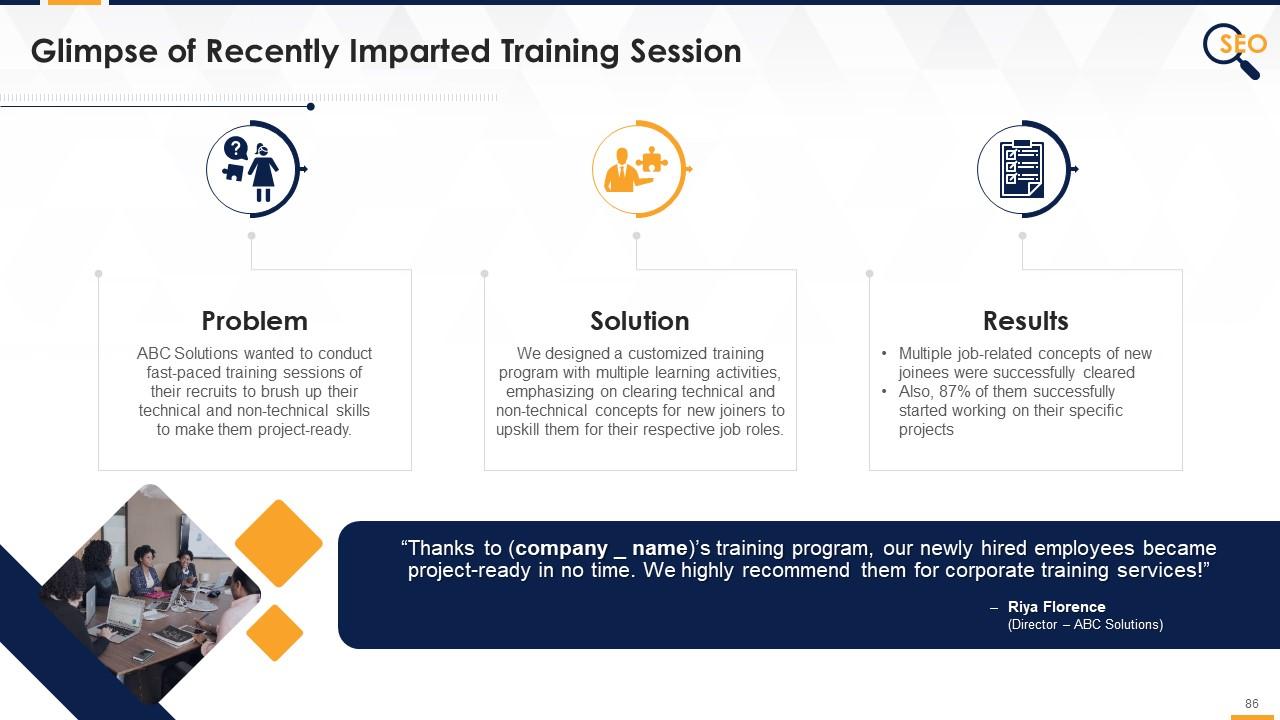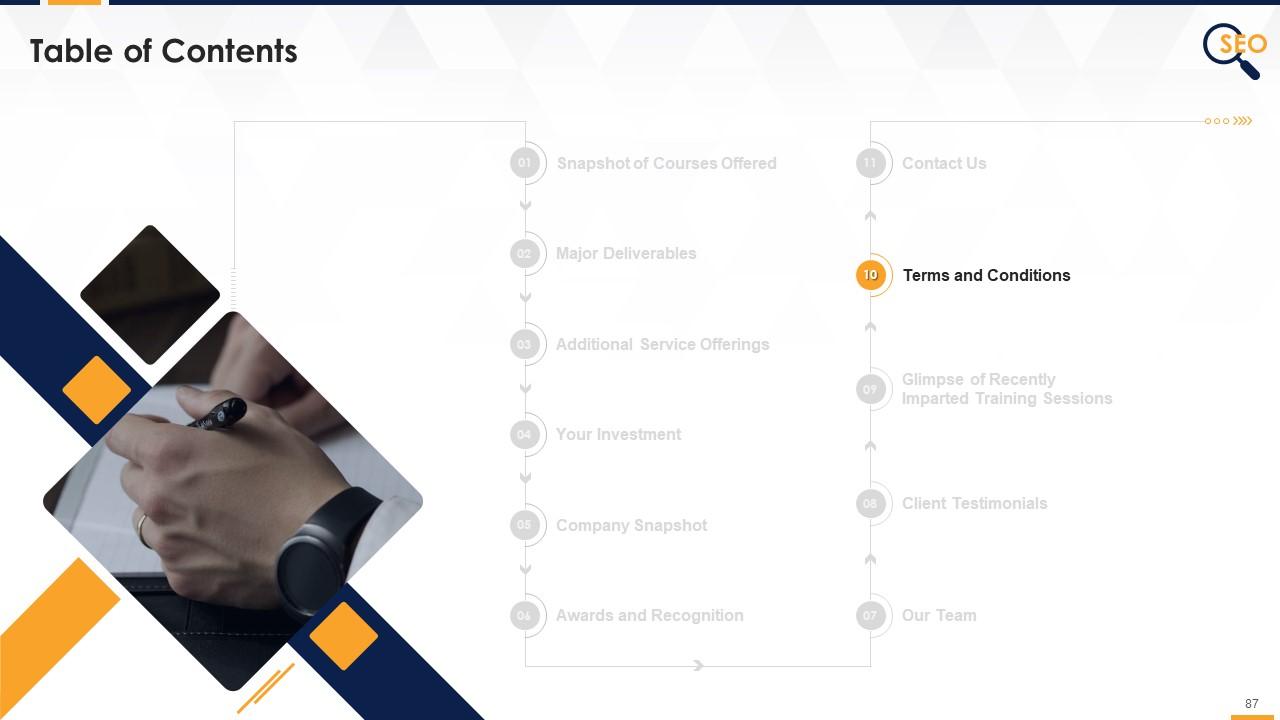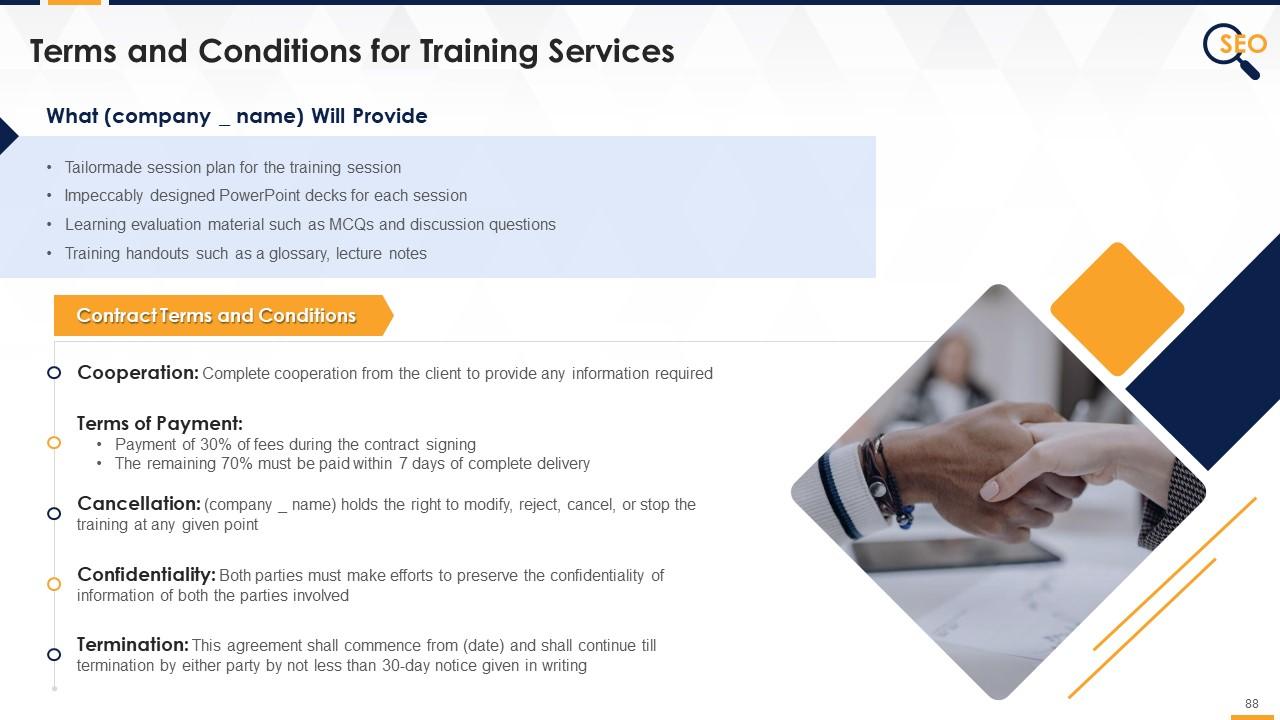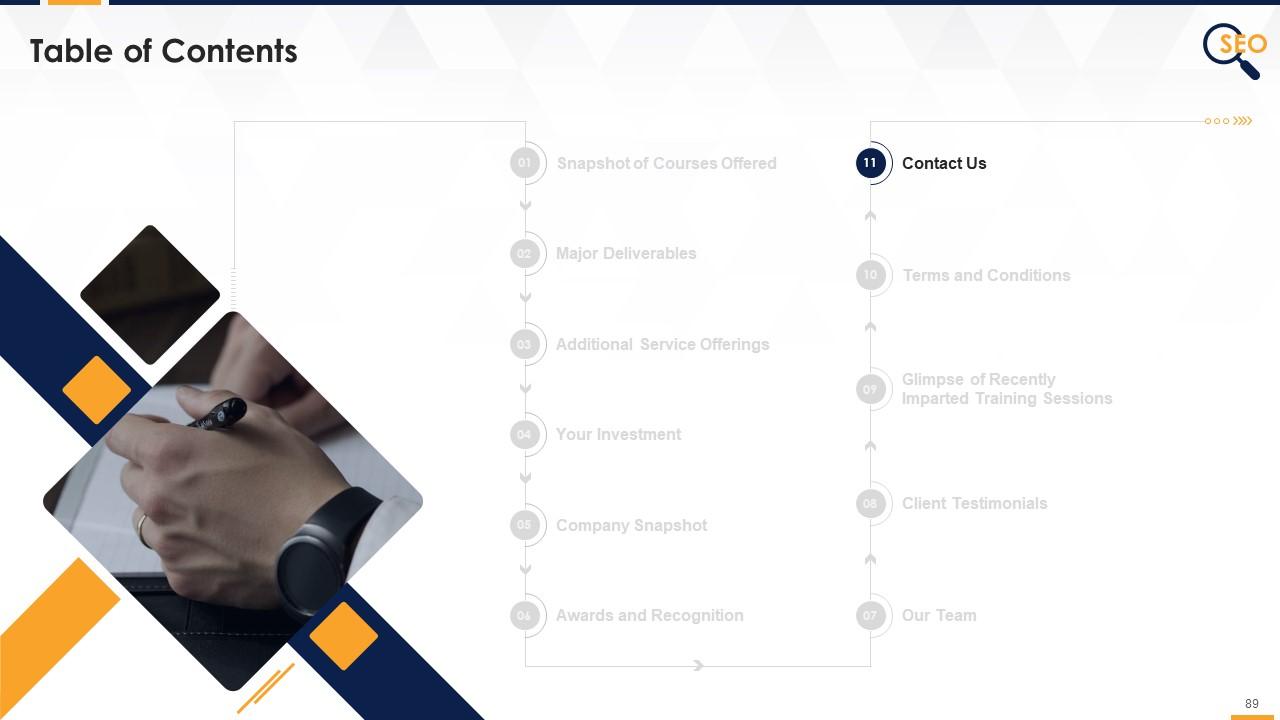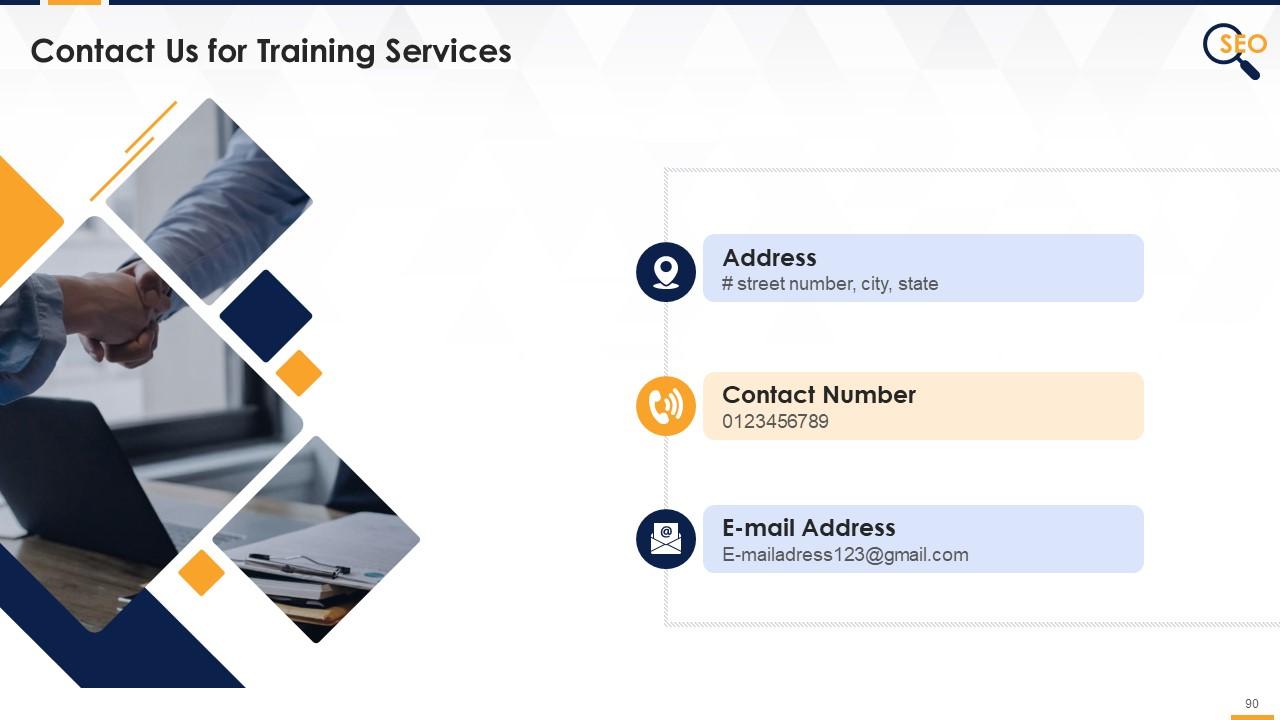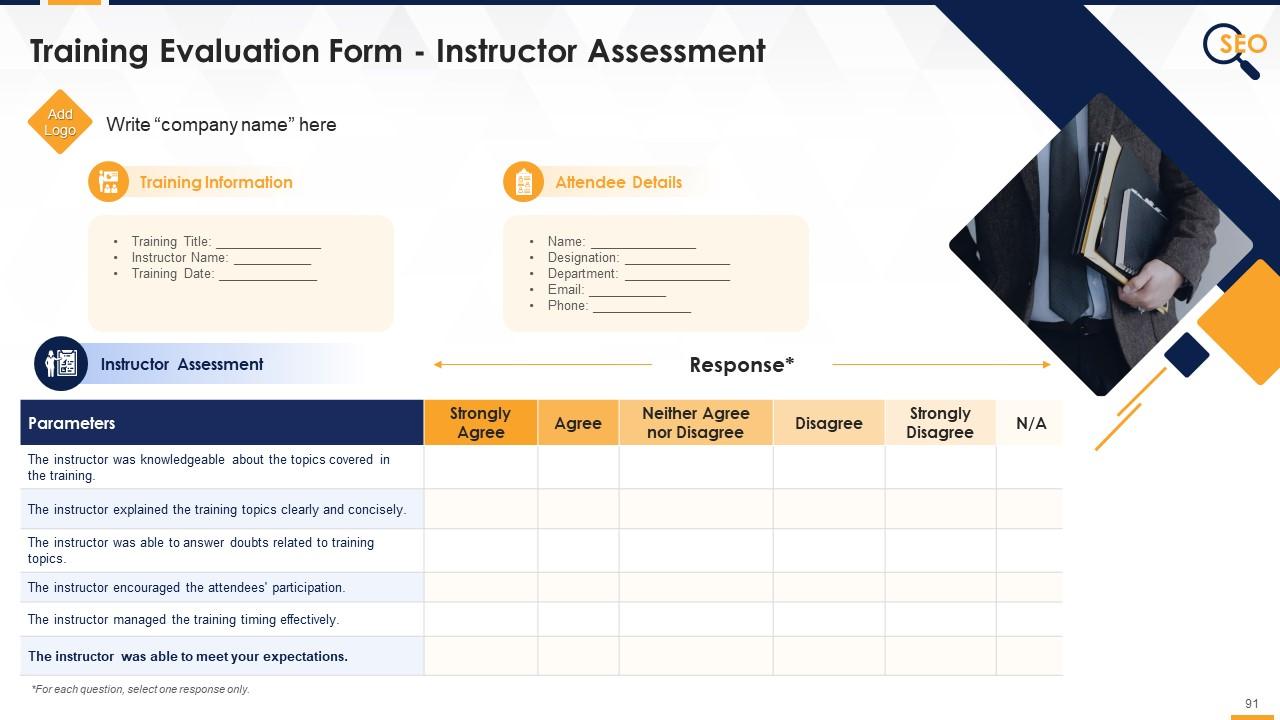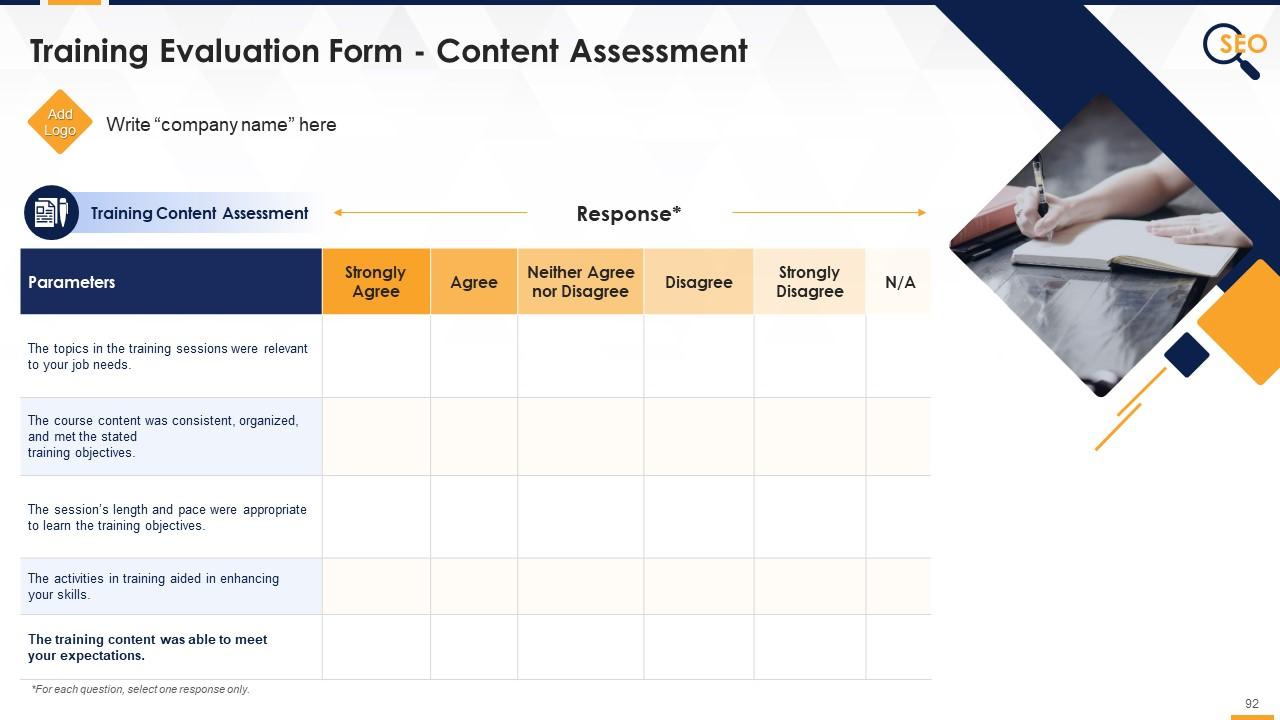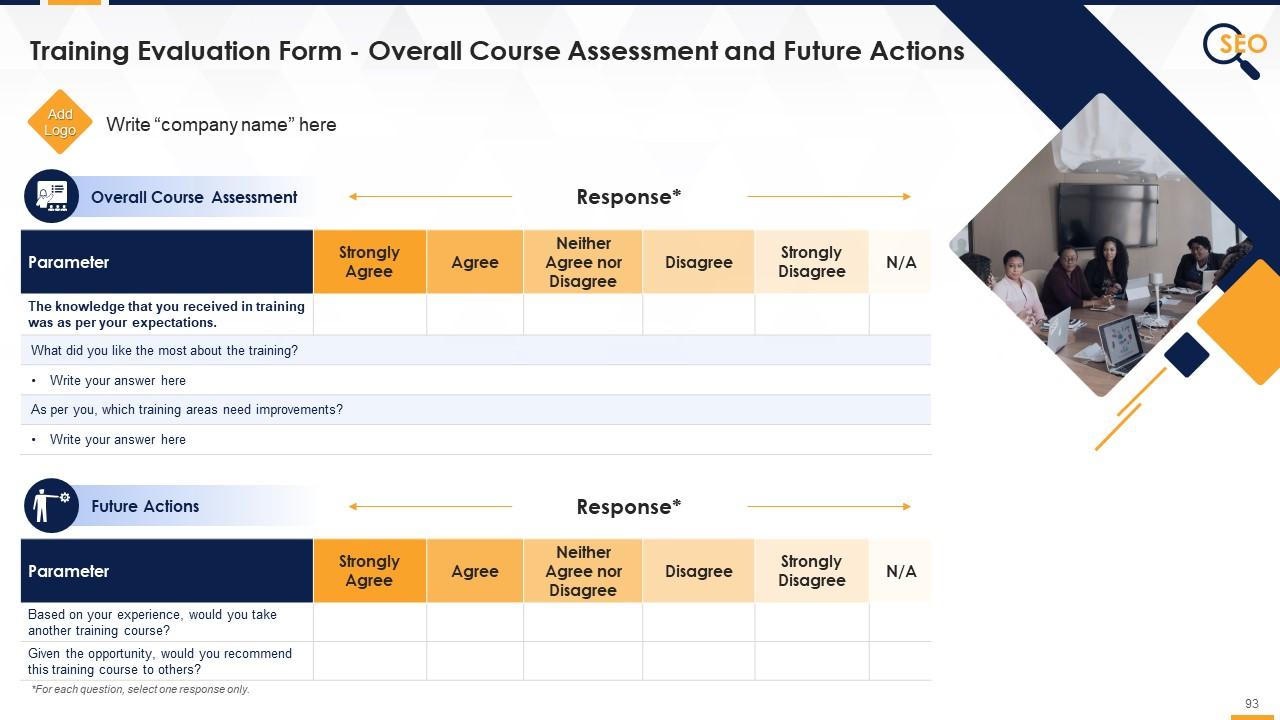SEO Audit Training Module On Search Engine Optimisation Edu Ppt
This training module deals in detail with the SEO audit. It covers the importance of conducting website SEO audits and multiple backend and frontend factors. It covers the key SEO audit areas, i.e., Technical SEO, On-Page SEO, Off-Page SEO., with common mistakes and associated corrective actions and the tools to use for audit. Then in-depth, it covers the audit factors for Technical SEO audit such as Sitemaps, Robots.txt, Site Errors, URLs Errors, Bloated CSS and JavaScript files, SSL certificate, Page Speed, and Mobile Optimization. The PPT deck also includes On-page SEO audit parameters such as Title Tags, Meta Description Tags, Heading H1 to H6, Content Duplication, and Image Optimization. Further, it covers Off-page SEO audit factors such as Internal and External Links, Backlinks, Anchor Text, and Social Media Integration. The PowerPoint deck also contains the customizable and impeccably designed audit checklists and sample audit reports for quick reference.
- Google Slides is a new FREE Presentation software from Google.
- All our content is 100% compatible with Google Slides.
- Just download our designs, and upload them to Google Slides and they will work automatically.
- Amaze your audience with SlideTeam and Google Slides.
-
Want Changes to This PPT Slide? Check out our Presentation Design Services
- WideScreen Aspect ratio is becoming a very popular format. When you download this product, the downloaded ZIP will contain this product in both standard and widescreen format.
-

- Some older products that we have may only be in standard format, but they can easily be converted to widescreen.
- To do this, please open the SlideTeam product in Powerpoint, and go to
- Design ( On the top bar) -> Page Setup -> and select "On-screen Show (16:9)” in the drop down for "Slides Sized for".
- The slide or theme will change to widescreen, and all graphics will adjust automatically. You can similarly convert our content to any other desired screen aspect ratio.
Compatible With Google Slides

Get This In WideScreen
You must be logged in to download this presentation.
PowerPoint presentation slides
Presenting Training Module on SEO Audit. This presentation deck contains 93 well-researched and uniquely designed slides. These slides are 100 percent made in PowerPoint and are compatible with all screen types and monitors. They also support Google Slides. Premium Customer Support available. Suitable for use by managers, employees, and organizations. These slides are easily customizable. You can edit the color, text, icon, and font size to suit your requirements.
People who downloaded this PowerPoint presentation also viewed the following :
Content of this Powerpoint Presentation
Slide 4
This slide provides information regarding the SEO audit. It also covers details of its importance in improving website performance, content optimization, enhancing user experience, discovering potential revenue sources, and removing toxic backlinks.
Instructor's Notes:
The major benefits of performing an SEO audit are:
- Improves Website Performance: Conducting an SEO audit will identify any issues that the website faces, such as security concerns or issues with sitemaps, so that they can be resolved to improve the website performance
- Content Optimization: SEO audit will showcase if the existing content (Keywords, Text, Anchor texts, etc.) is bringing the relevant traffic to the website or not? If not, then what prospective actions must be taken to optimize the content
- Enhances User Experience: SEO audit will point out the website's technical issues, such as broken links, slow loading speed, etc., which then can be fixed to make it more user-friendly for an enhanced user experience
- Discover Potential Revenue Sources: SEO audit helps understand what competitors are doing and eventually unearth the lucrative opportunities to partner with prospective influencers or potential affiliates for increased business website visibility
- Removes Toxic Backlinks: SEO audit helps find and remove the toxic backlinks that attract penalties from search engines impacting website ranking in SERPs
Slide 5
This slide provides an overview of frontend factors that must be taken into account for SEO audit, such as user-friendly design, website’s page loading time, bug-free code, simple navigation, optimized content – keywords, text, images, and sitemaps for both user and search engine.
Slide 6
This slide provides information regarding Technical SEO Audit, On-Page SEO Audit, and Off-Page SEO Audit.
Slide 8
This slide provides an overview of multiple factors in technical SEO audit such as URLs, minifying CSS & JavaScript files, mobile optimization, sitemaps, robots.txt, image optimization, single domain, HTML errors / W3C validation, SSL certificate, and crawl errors.
Slide 9
This slide provides information regarding the important XML sitemap checks for SEO audit. It also includes details of common mistakes, corresponding corrective actions, and the best tools to conduct the sitemaps audit.
Slide 10
The purpose of this slide is to provide information regarding the approaches to conduct the SEO (Search Engine Optimization) audit of robots.txt file. It also tabulates the common mistakes, corresponding corrective actions, along with the best software to conduct the robots.txt file inspection.
Instructor's Notes:
- Correct way to place robots.txt file in the root directory of the website:
- Incorrect way – https://www.website.com/assets/robots.txt
- Correct way – https://www.website.com/robots.txt
- Proper way to use wildcards:
- Disallow: /xyz* - (* represents that any URL with “/xyz” present in it will be blocked)
- Disallow: *.file_type$ - (Any URL ending with .file_type extension should be blocked)
- Correct way to use a trailing slash: Let’s say we want to block the crawling of “/xyz” in the URL
- Incorrect way - Disallow: /xyz/ (As it will block the “/xyz/” folder in the URL not the”/xyz” as required
- Correct way - Disallow: /xyz
- The code snippet to use in the page code of the URLs that are required to be blocked from indexing: <meta name=”robots” content=”noindex”/>
- The command to declare the sitemap in the robots.txt file: https://www.website.com/sitemap.xml
- Let’s say we want to block the URL https://www.website.com/xyz
- Incorrect way - Disallow: /Xyz
- Correct way - Disallow: /xyz
Slide 11
This slide provides an information regarding the major site errors in SEO such as DNS (domain name server) & server errors and robots failure. It also includes details of issues, useful tools to detect issues, and corrective actions.
Instructor's Notes:
- Server errors are different from DNS errors as in server errors, search engine crawler is successfully able to lookup the website but cannot connect due to server issues
Slide 12
This slide provides information regarding the major URL errors in SEO such as soft 404, 404, access denied, not followed, and non-www and www versions of URLs. It also provides details of audit tools to detect them and corrective actions to deploy to resolve them.
Slide 13
The purpose of this slide is to provide an overview of Bloated CSS & JavaScript Files and their impact on SEO. It also contains information regarding the corrective action, such as removing extra code, along with the details of the tools that can be used.
Slide 14
The purpose of this slide is to introduce the SSL certificate and its adverse impact if one doesn’t install it. It also includes information about the multiple SLL certificates such as single-domain SSL certificate, multi-domain SSL certificate, wildcard SSL certificate, organization SSL certificate, and extended.
Instructor's Notes:
The major types of SSL certificates are:
- Single-domain SSL certificate: If the website is hosted on a single domain, this type of certificate is good enough
- Multi-domain SSL certificates: If a website is hosted on multiple domains, install this type of certificate as it covers both subdomains and entirely new websites
- Wildcard SSL certificates: This type of certificate covers subdomains on a single root domain but not new websites
- Organization SSL certificates: It is like a single-domain SSL certificate but requires details of the organization for which the website has been installed
- Extended: This type of certificate not only validates domain ownership but also verifies the organization details filled
Slide 15
This slide provides an information regarding the page speed and major tools to audit it. It also includes details of major mistakes that result in slow page speed and corrective actions to improve it.
Slide 16
This slide tabulates the major mobile optimization mistakes in SEO audit and tools to identify them. It also contains information regarding the corrective actions to resolve them.
Slide 18
This slide provides an overview of multiple on-page SEO audit factors such as title tags, meta description tags, headings (H1 to H6), content duplication, and image optimization.
Slide 19
This slide provides information regarding the common mistakes identified in On-Page SEO audit. It also contains details of multiple audit tools and corrective actions to rectify those mistakes.
Slide 20
This slide indicates the common meta description tag mistakes in the On-Page SEO audit. It also contains details of audit tools and corrective actions.
Slide 21
This slide indicates the common heading tags issues in On-Page SEO audit. It also contains details of audit tools and corrective actions.
Slide 22
This slide provides information regarding the content duplication issues and associated corrective actions in On-Page SEO audit. It also contains details of features of high-quality SEO content.
Slide 23
This slide provides information regarding the common image optimization mistakes in On-Page SEO audit and their corrective actions.
Slide 25
This slide provides an overview of multiple off-page SEO audit factors such as internal and external links, backlinks, anchor text, and social media integration.
Slide 26
This slide provides information regarding the common internal and external links mistakes in off-page SEO audit. It also contains details of corrective actions and tools for audit.
Slide 27
This slide provides information regarding the major backlinking mistakes in off-page SEO audit. It also tabulates the multiple corrective actions along with the tools for audit.
Slide 28
The purpose of this slide is to highlight the anchor text mistakes in off-page SEO audit along with corrective actions and tools for audit.
Slide 29
This slide tabulates the typical social media integration mistakes done in SEO. It also provides information regarding the associated corrective actions.
Slide 31
This slide showcases a comprehensive checklist to conduct an SEO audit. It includes details of multiple factors associated with Technical, On-Page, and Off-Page SEO Audit.
Slide 32
This slide highlights the sample scorecard for the preparation of the SEO audit report.
Slide 34
This slide highlights the findings of On-page SEO audit findings of major factors such as thin content, keyword focus, and page load speed.
Slide 35
This slide tabulates the findings of on-page SEO analysis factors such as title tags, heading tags, meta descriptions, duplicate content, and alt tags.
Slide 36
This slide showcases the findings of an off-page SEO audit covering major factors such as broken external links, backlink toxicity analysis, and referring domains.
Slides 47 to 62
These slides include multiple energizer activities to break the monotony of training sessions and actively engage trainees. The energizer activities are as follows:
- Buzz
- Red Nose
- Don’t Answer
- Who are You?
- The Name Game
- Pass the Ball
- Genie in a Bottle
- Names and Adjectives
- Who am I?
- Are We Together?
- Write your Name
- Chinese Whisper
- Random Chairs
Slide 64
This slide highlights the cover letter for the training proposal. It includes details regarding what the company providing corporate training can accomplish for the client.
Slide 67
The purpose of this slide is to showcase the multiple types of courses offered by the training company.
Slide 69
This slide indicates the major deliverables that the corporate training firm will provide to the client. The key deliverables highlighted are session plans, PowerPoint deck, evaluation material, and training handouts.
Slide 71
This slide represents the multiple additional services offered by the training firm to the client, such as webinars, planning journals, and e-learning design solutions.
Slide 73
This slide tabulates the major deliverables offered by the training company to the client along with their associated costs.
Slide 74
The purpose of this slide is to highlight the multiple additional services offered by the training firm along with their cost details.
Slide 76
This slide provides an overview of the corporate training firm's vision and mission statements, core values, and key clients.
Slide 78
This slide highlights the major awards and recognition won by the training firm for their exceptional service to clients.
Slide 80
The slide provides information regarding the team members that would be providing the training services to the client. It includes details of the trainer and their respective designations.
Slide 81
The slide provides information regarding the team members that would be providing the training services to the client. It includes details of the employees names and their respective designations.
Slide 83
This slide provides information pertaining to testimonials given by satisfied clients of the training firm.
Slide 84
This slide highlights the testimonials from multiple satisfied clients of the training firm providing information regarding congratulatory messages, client name, and company details.
Slide 86
This slide showcases the case study for the training proposal. It includes information regarding the problem faced by the client and solutions offered by the training firm. It also covers details of the results and client testimonial.
Slide 88
This slide provides information regarding the contract terms and conditions of the training proposal. It also includes details of deliverables that the training company will provide to the client.
Slide 90
The purpose of this slide is to provide the contact information of the corporate training firm. It includes the firm’s official address, contact number, and email address.
Slide 91
This slide highlights the training evaluation form for instructor assessment. It also includes sections to fill details of training information and attendee details.
Slide 92
This slide showcases the questions for the assessment of the training content by the attendees.
Slide 93
The slide indicates the evaluation form for course assessment. It also includes questions pertaining to the future actions of the attendees.
SEO Audit Training Module On Search Engine Optimisation Edu Ppt with all 98 slides:
Use our Training Module On Search Engine Optimization SEO Audit Edu Ppt to effectively help you save your valuable time. They are readymade to fit into any presentation structure.
-
Unique and attractive product design.
-
Visually stunning presentation, love the content.



